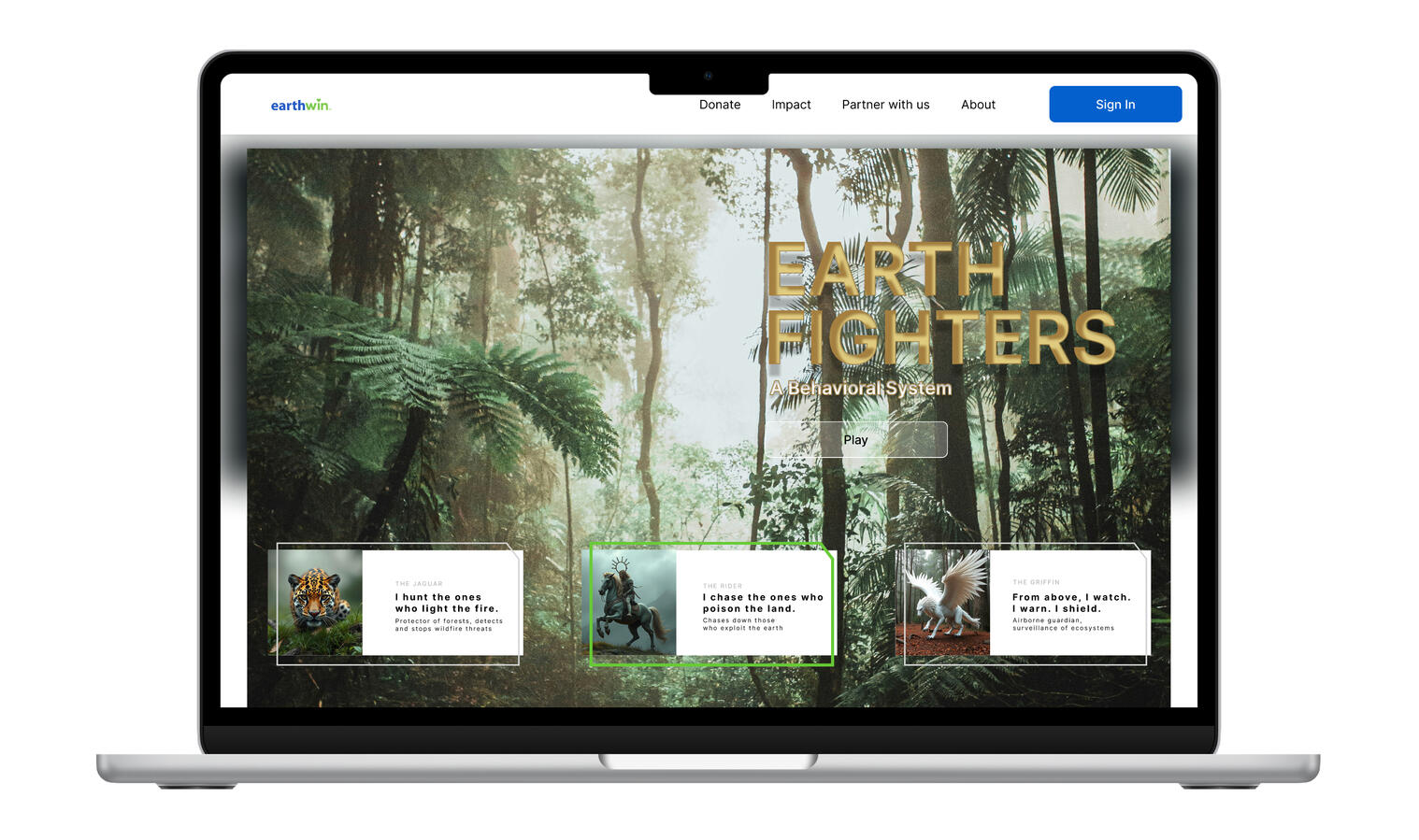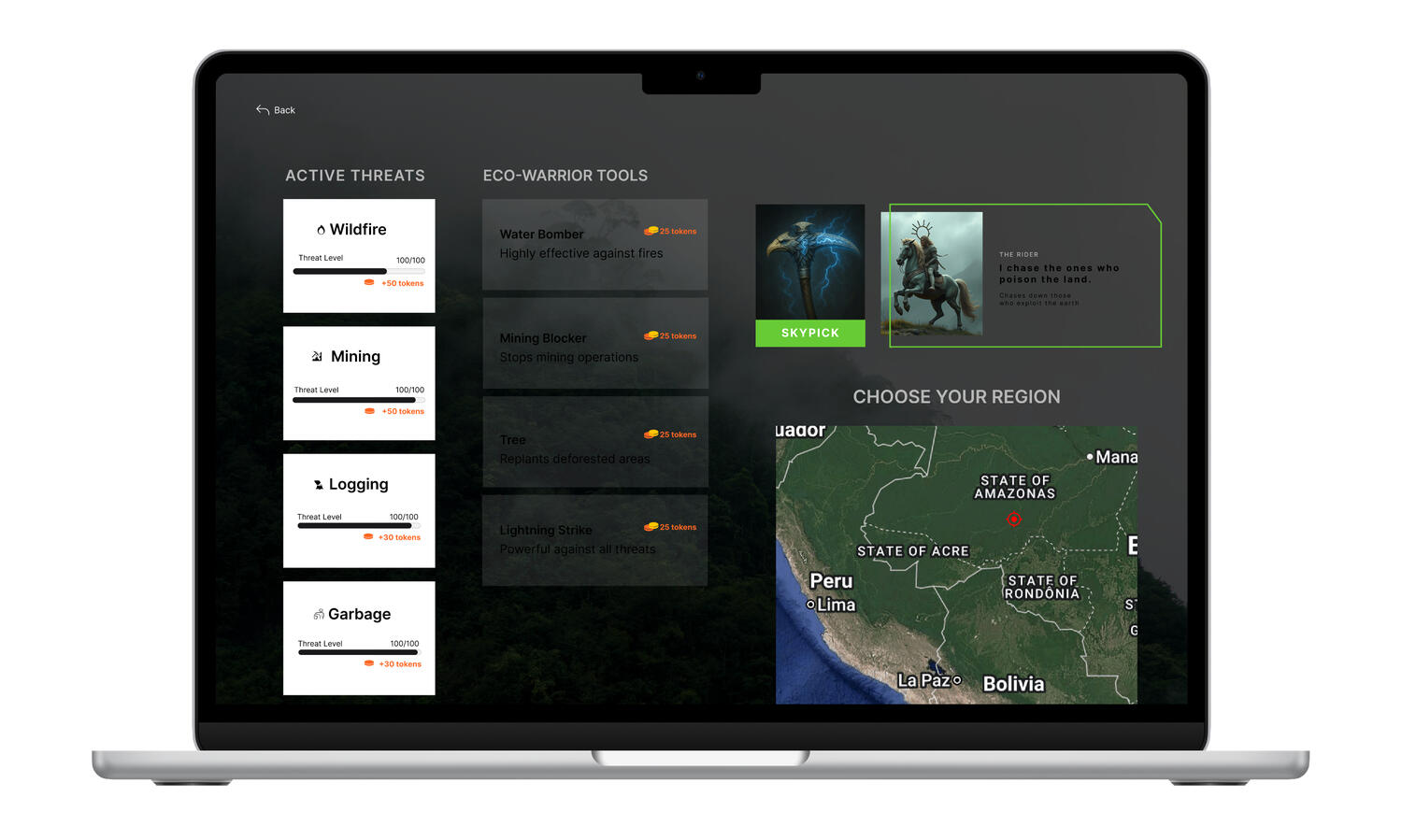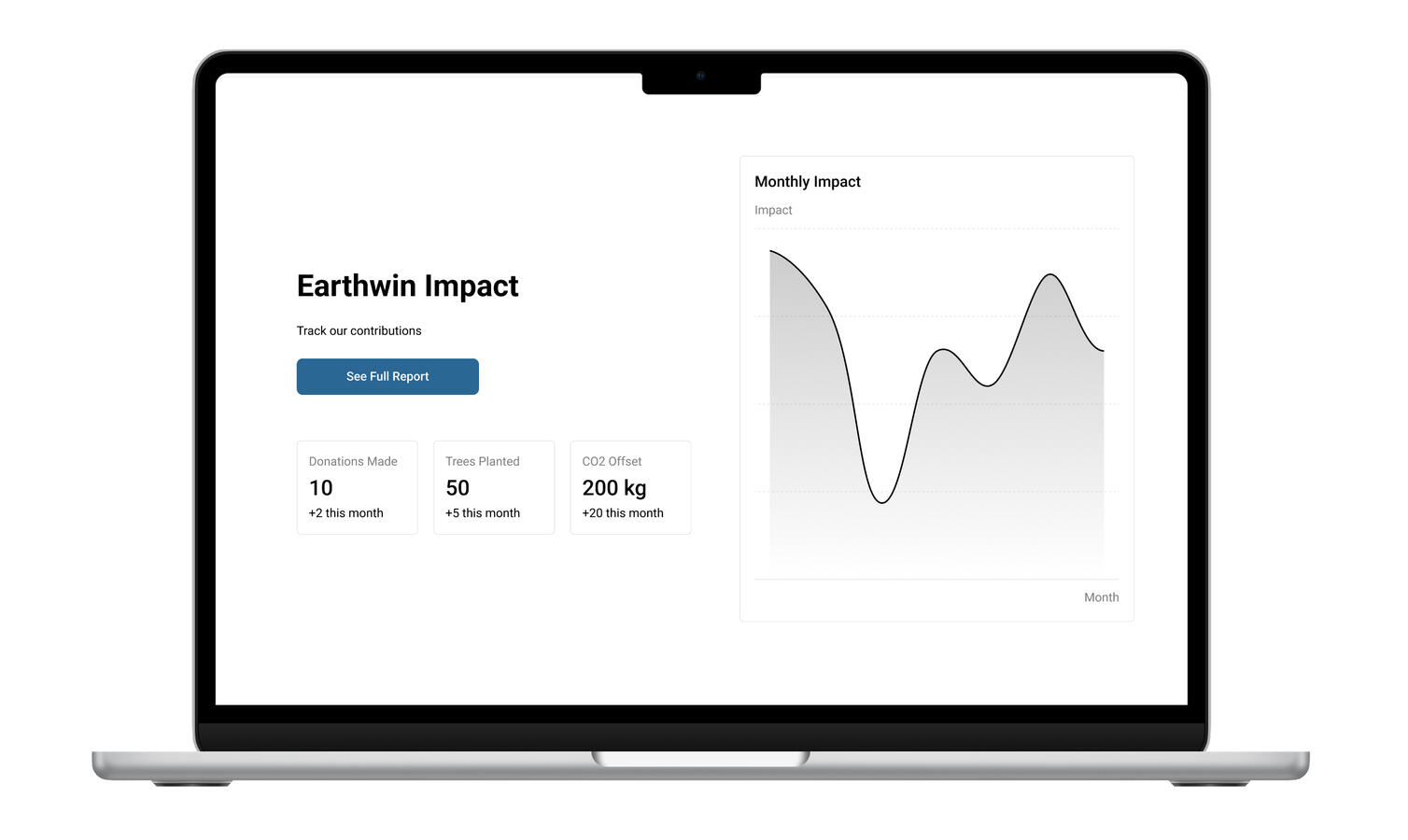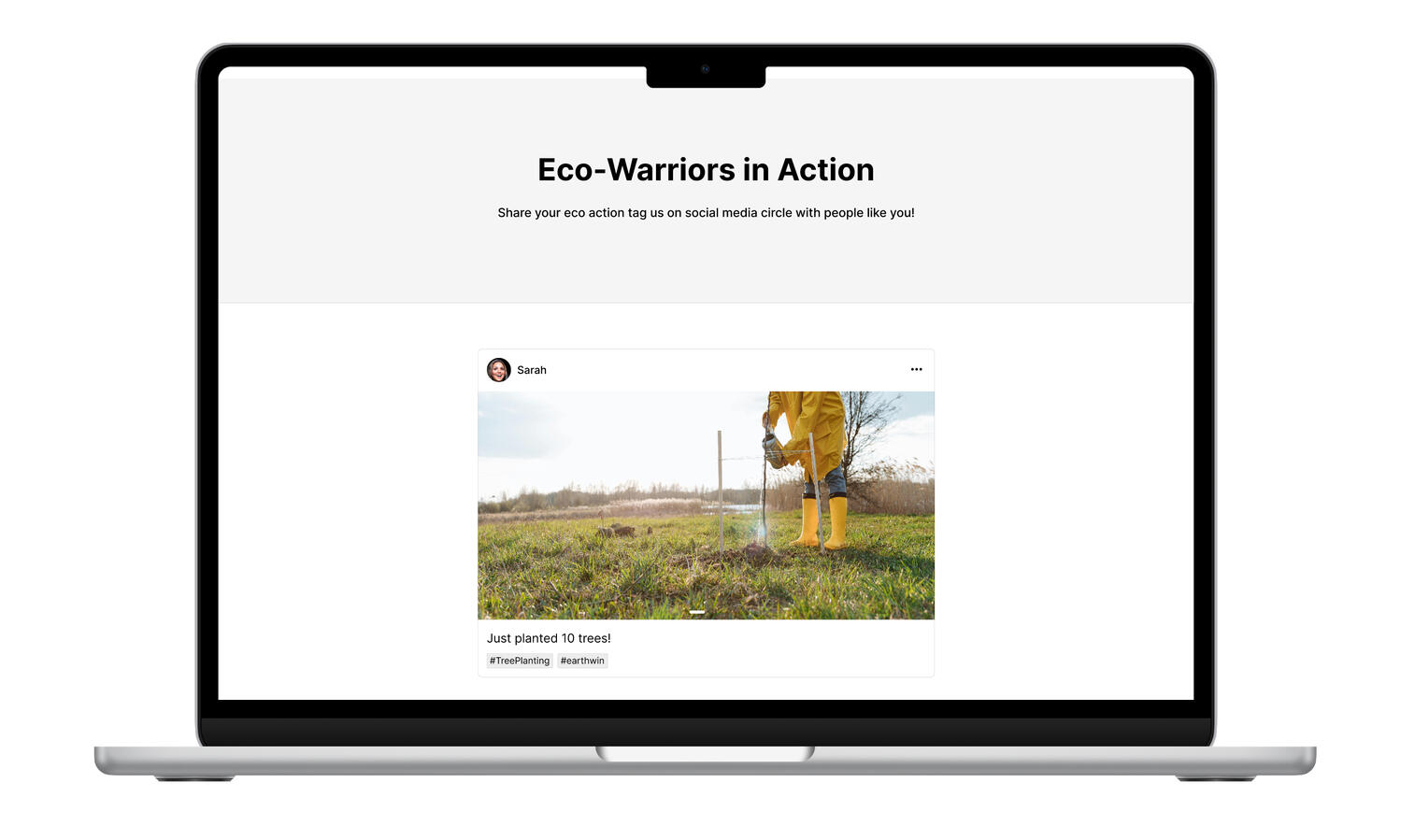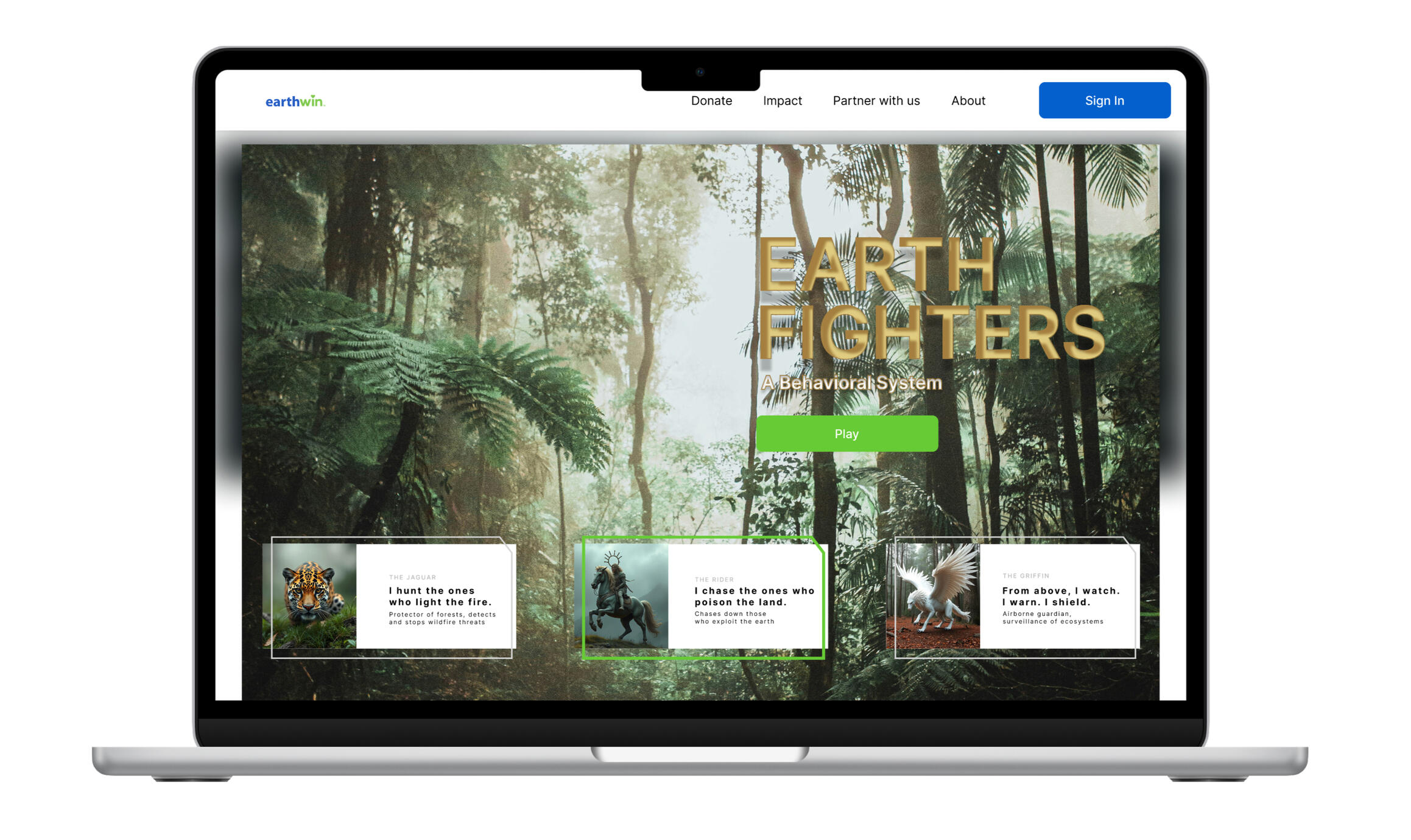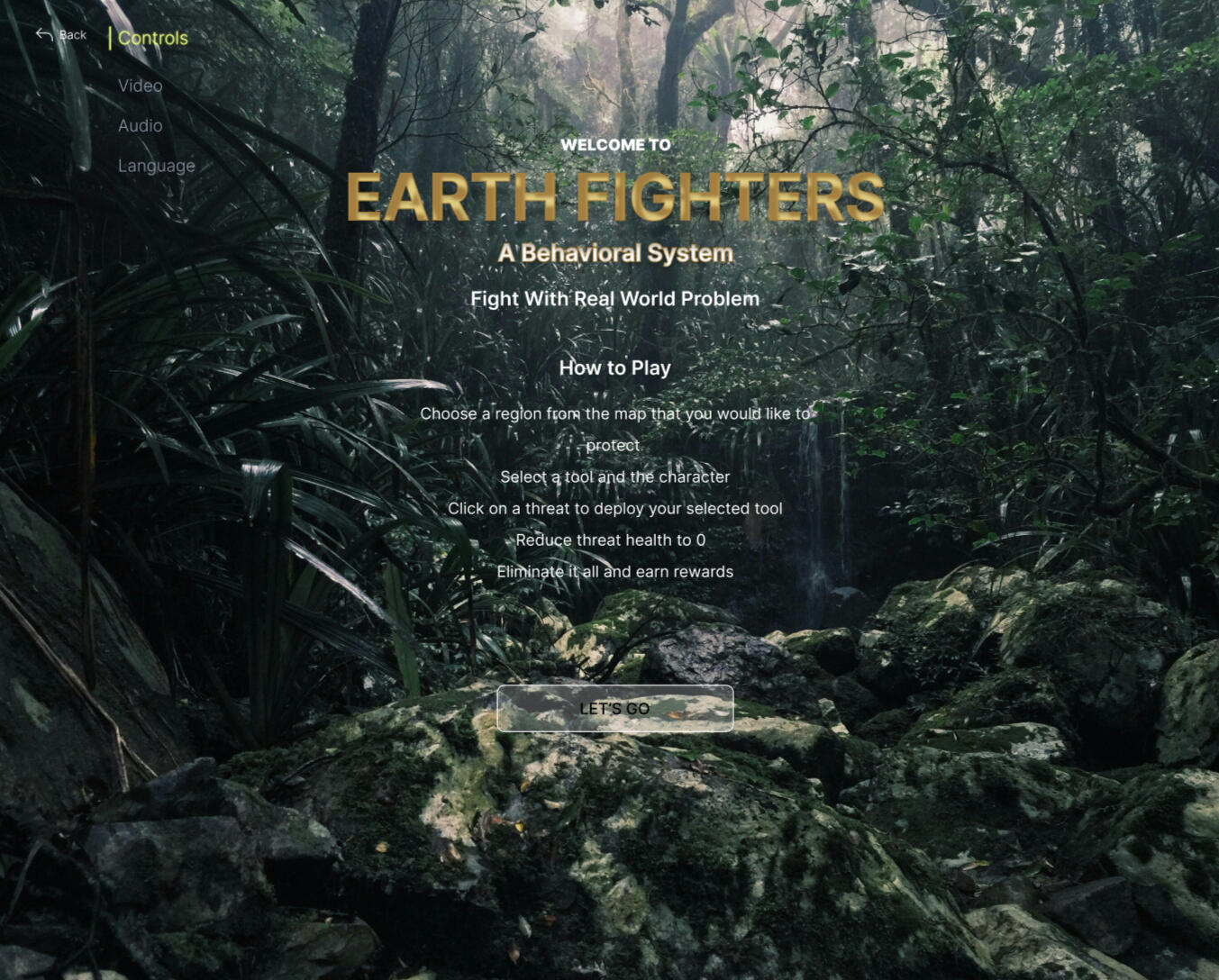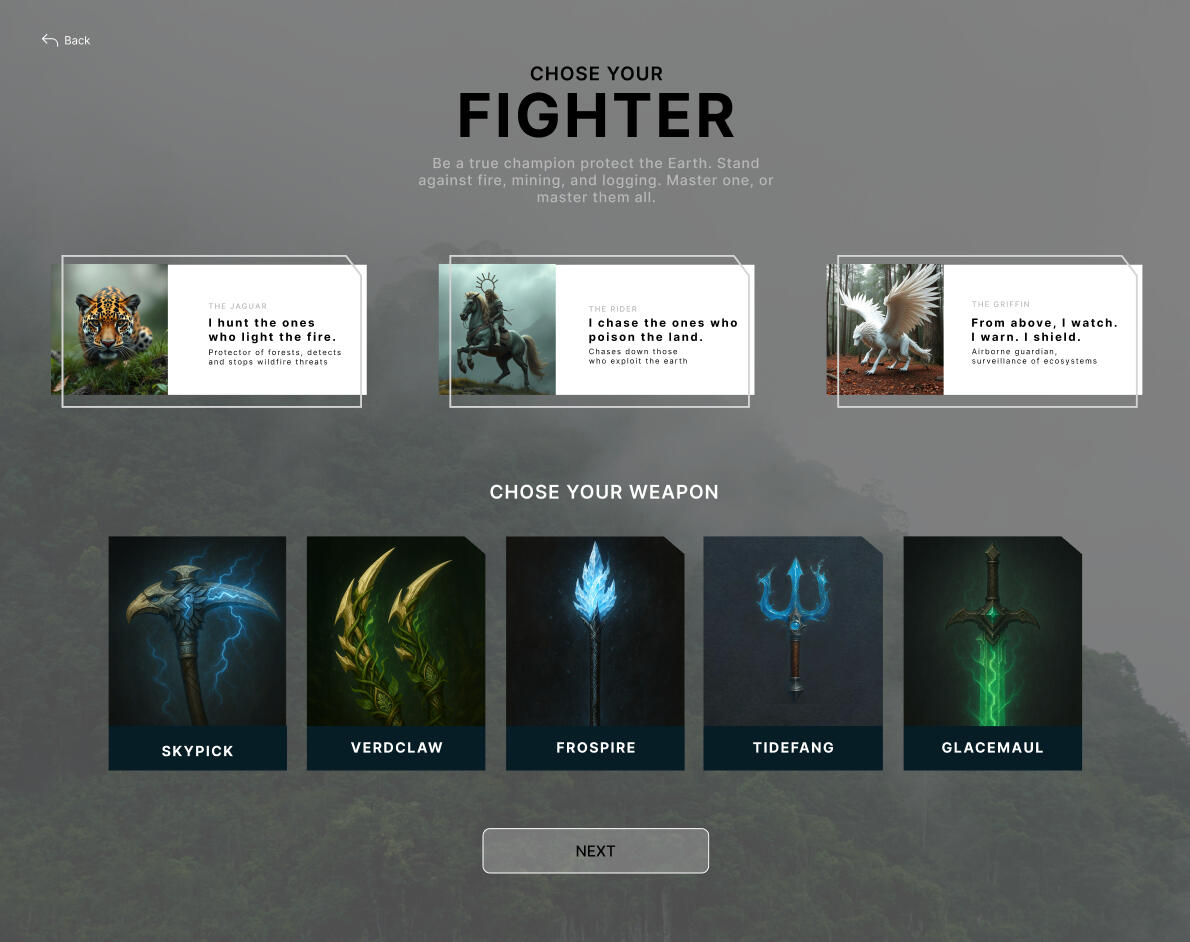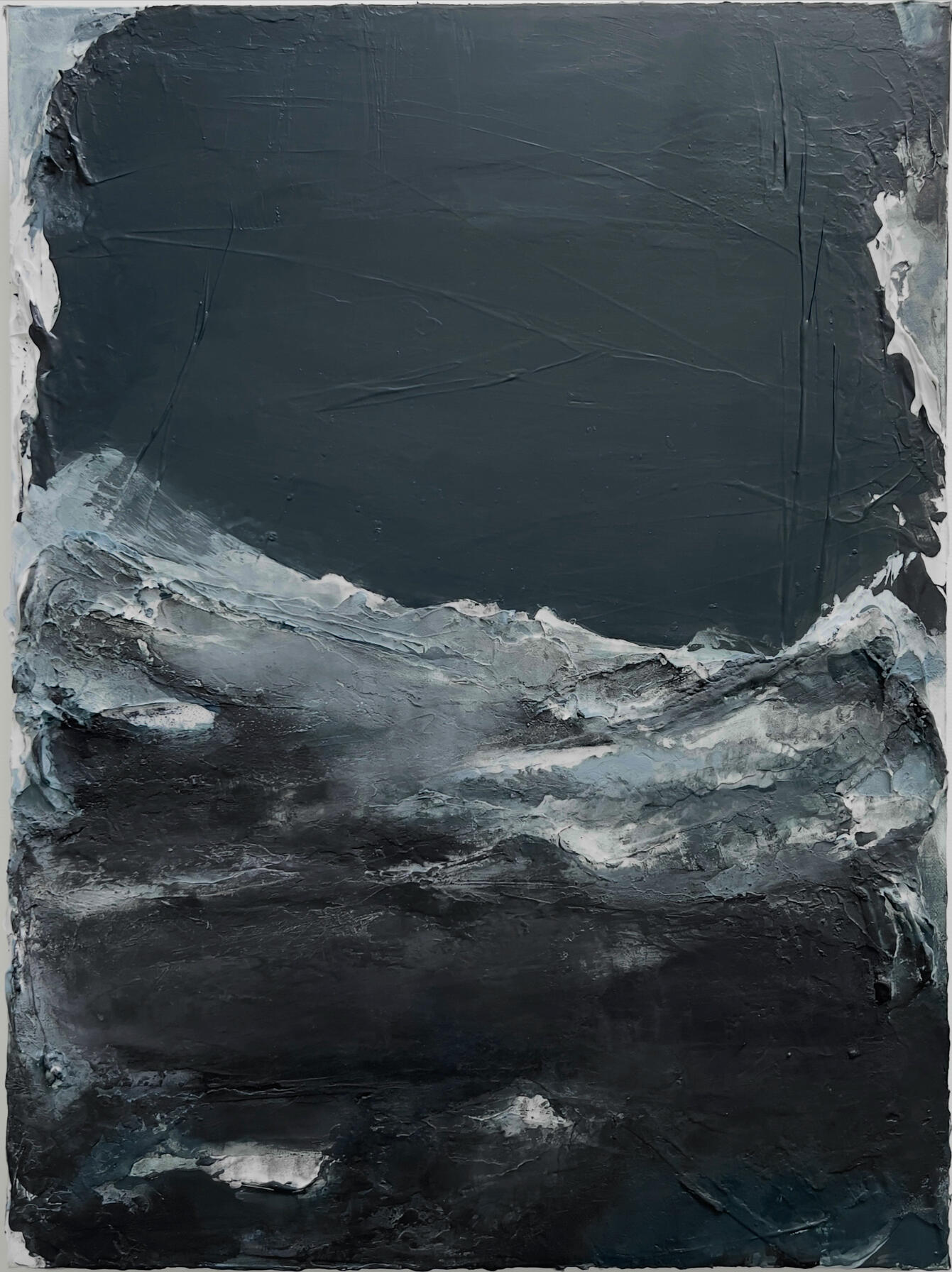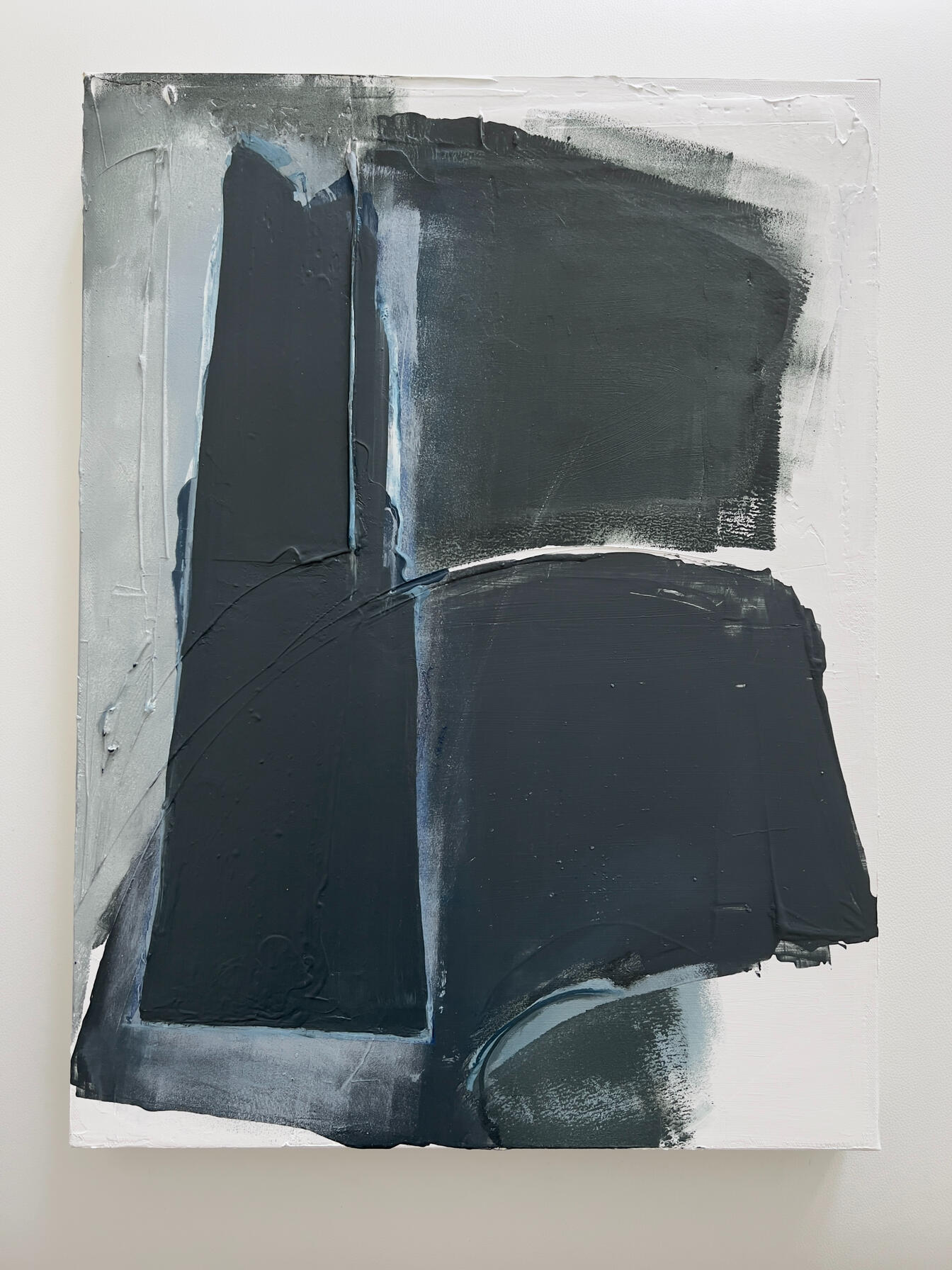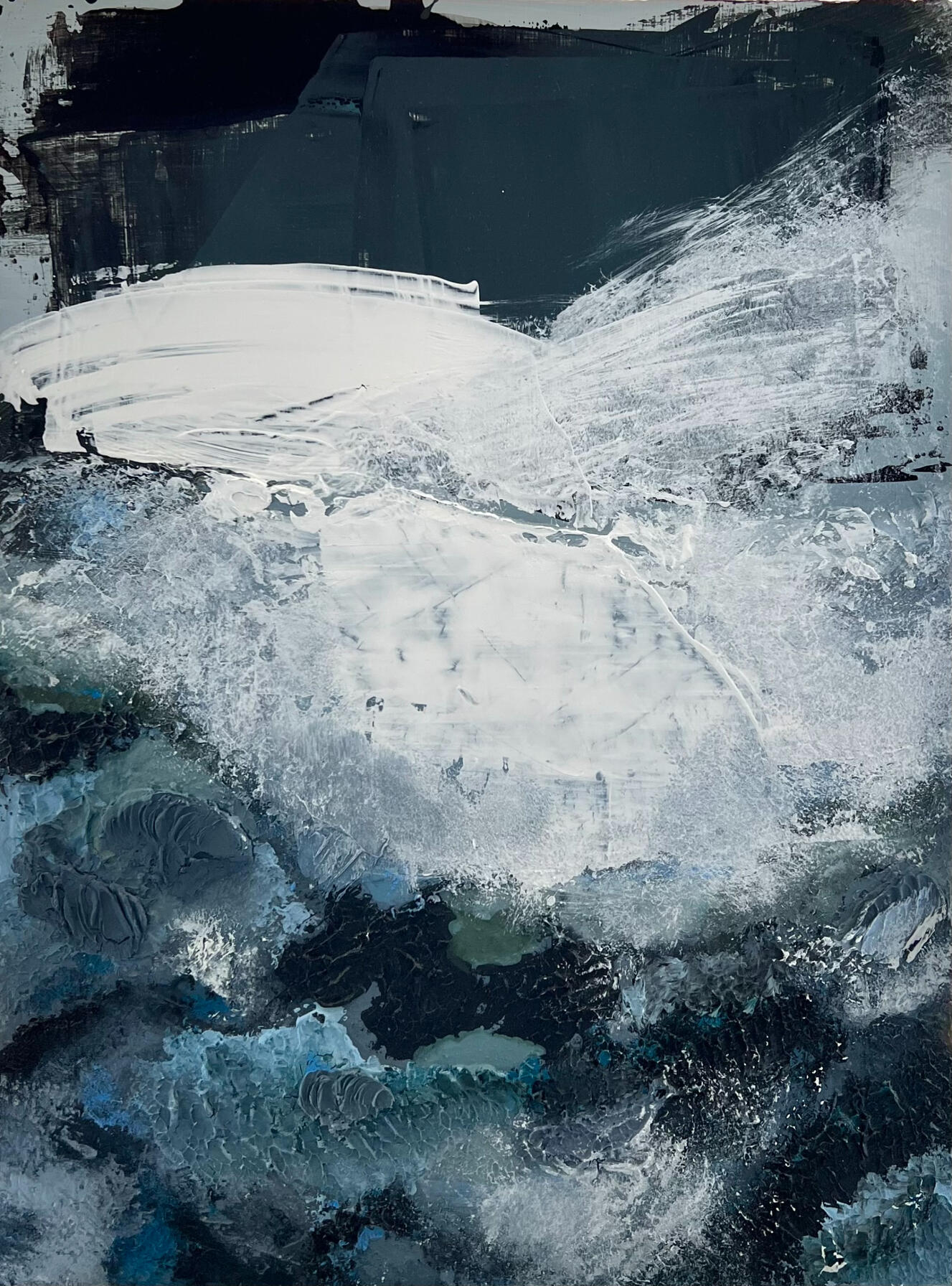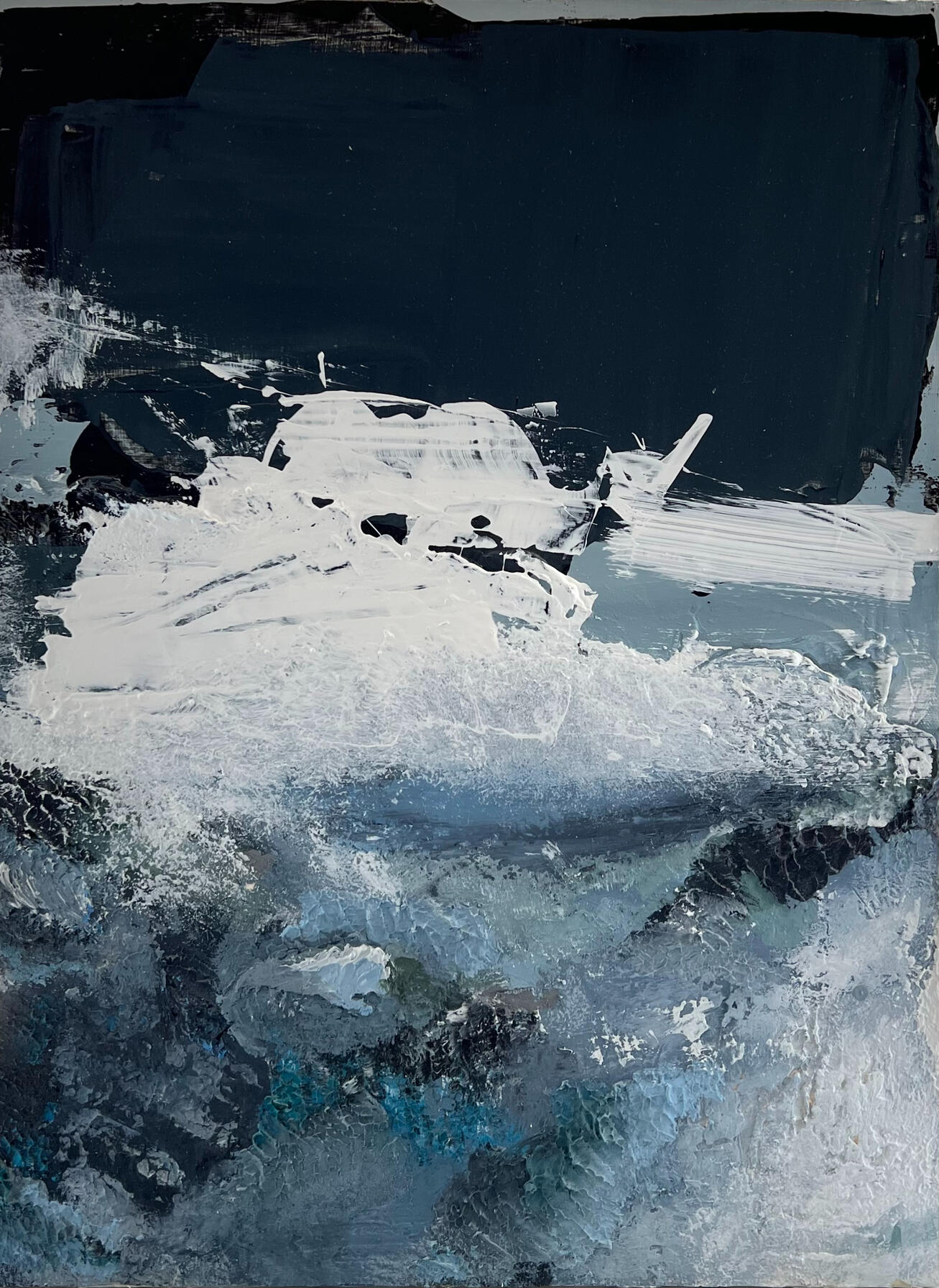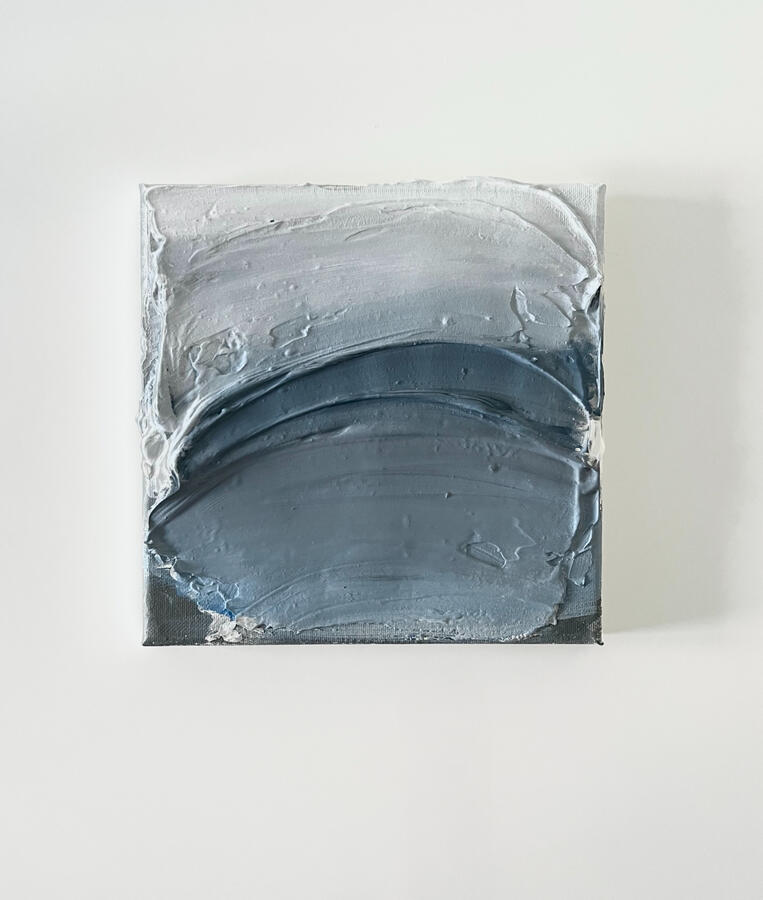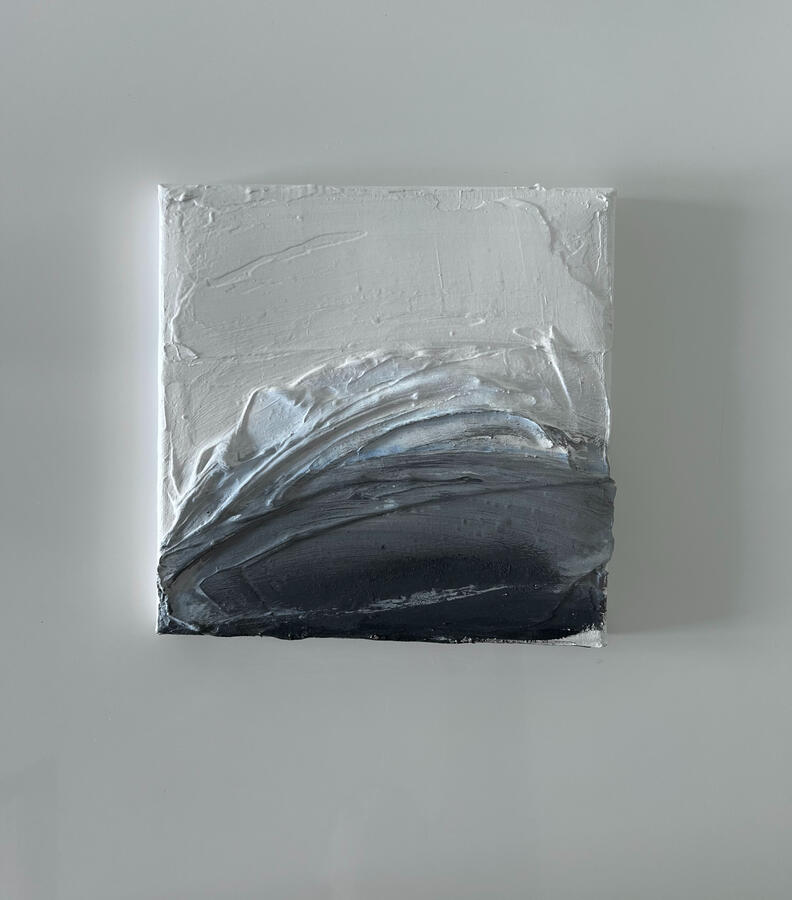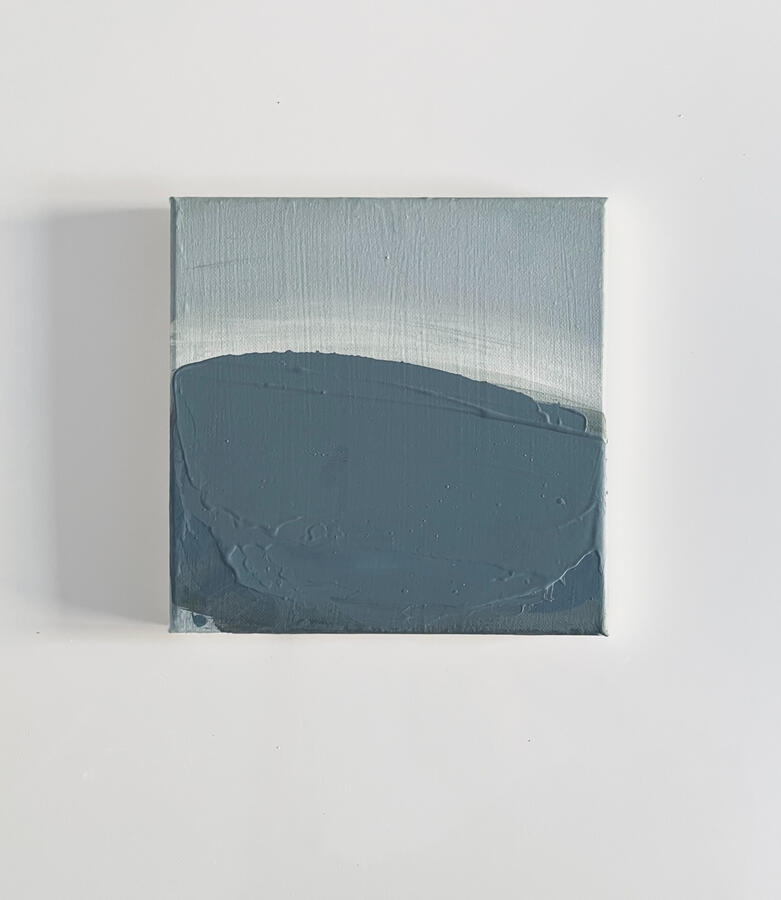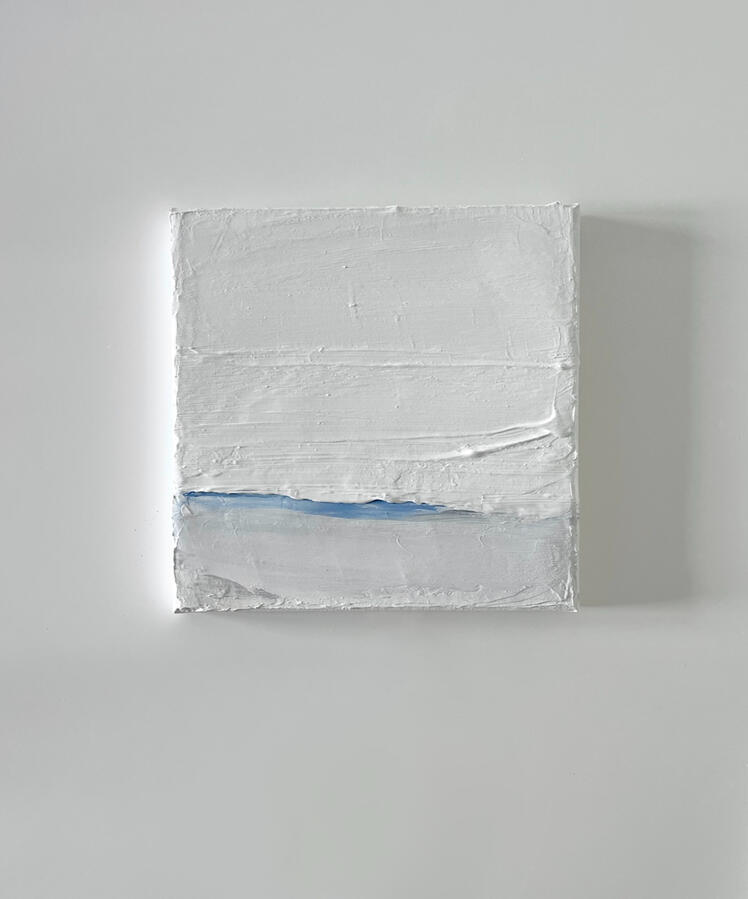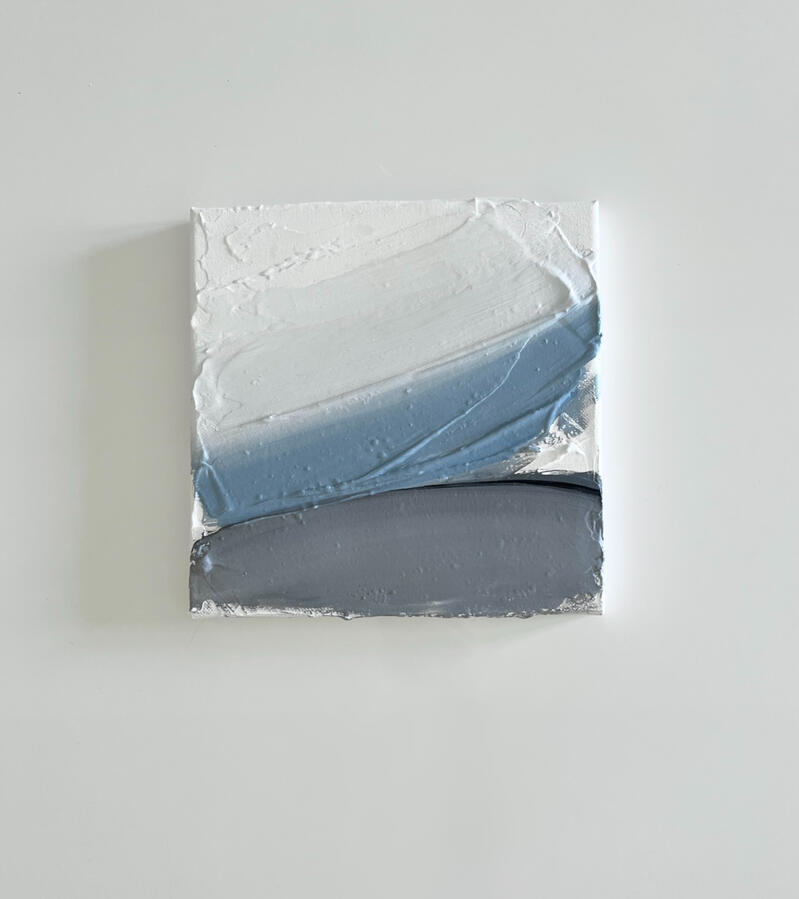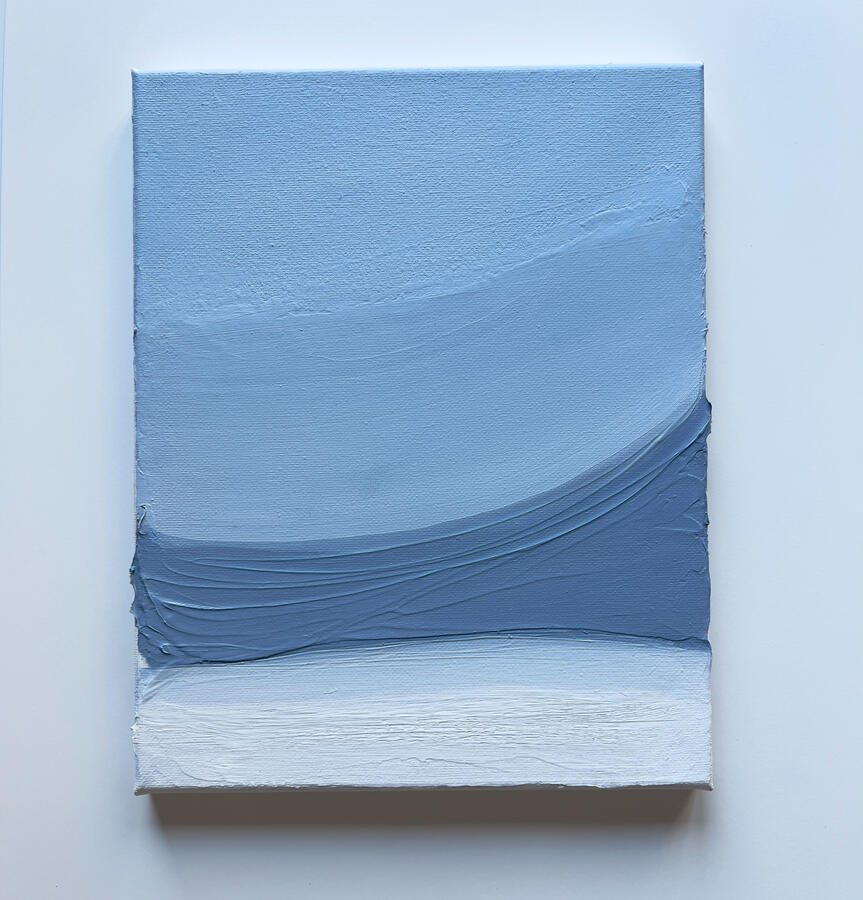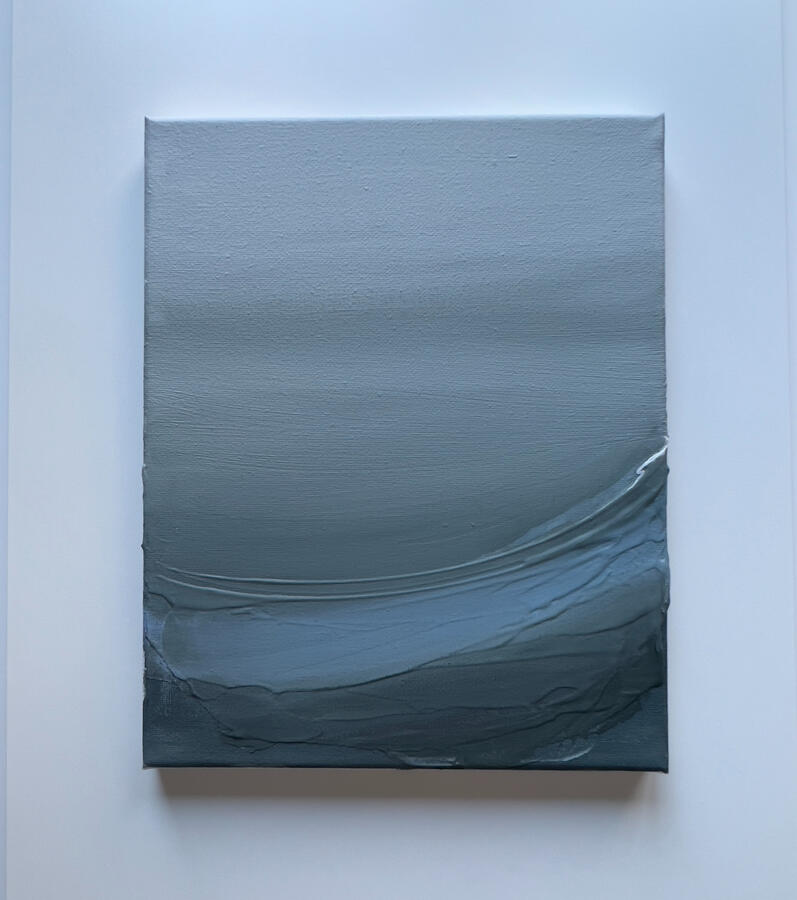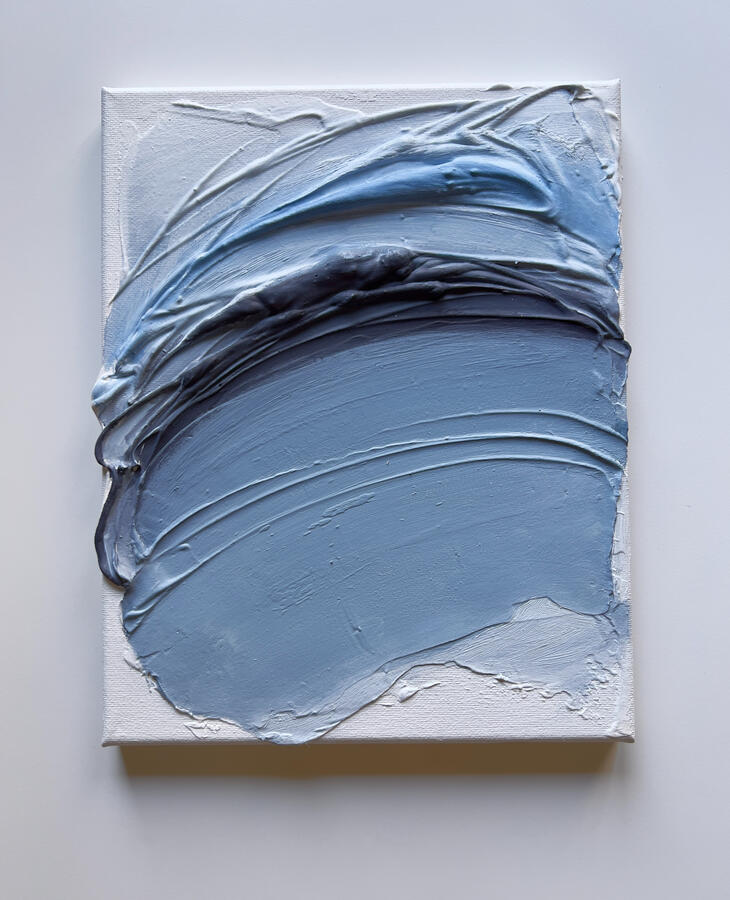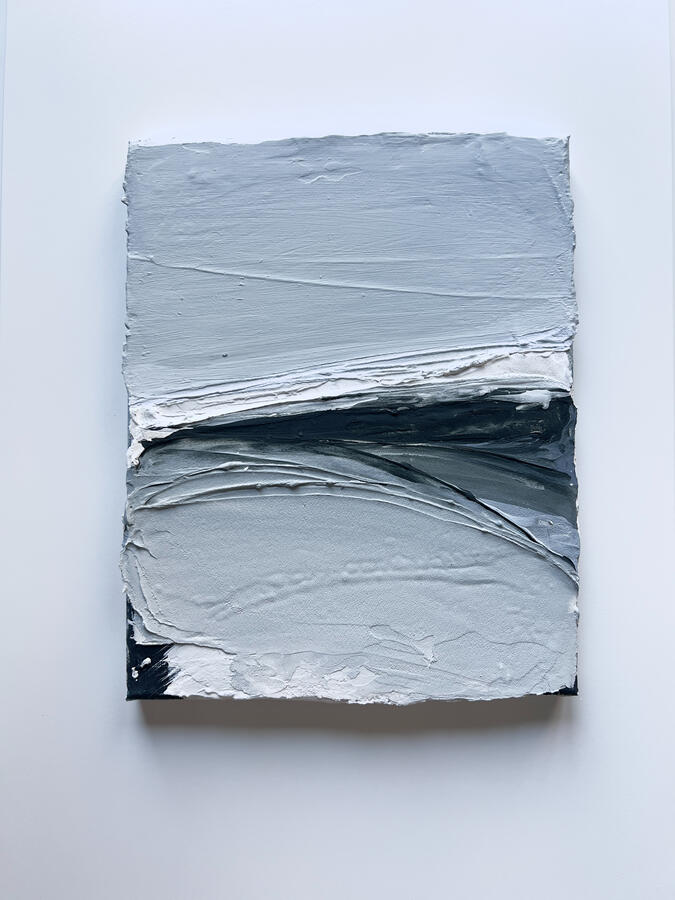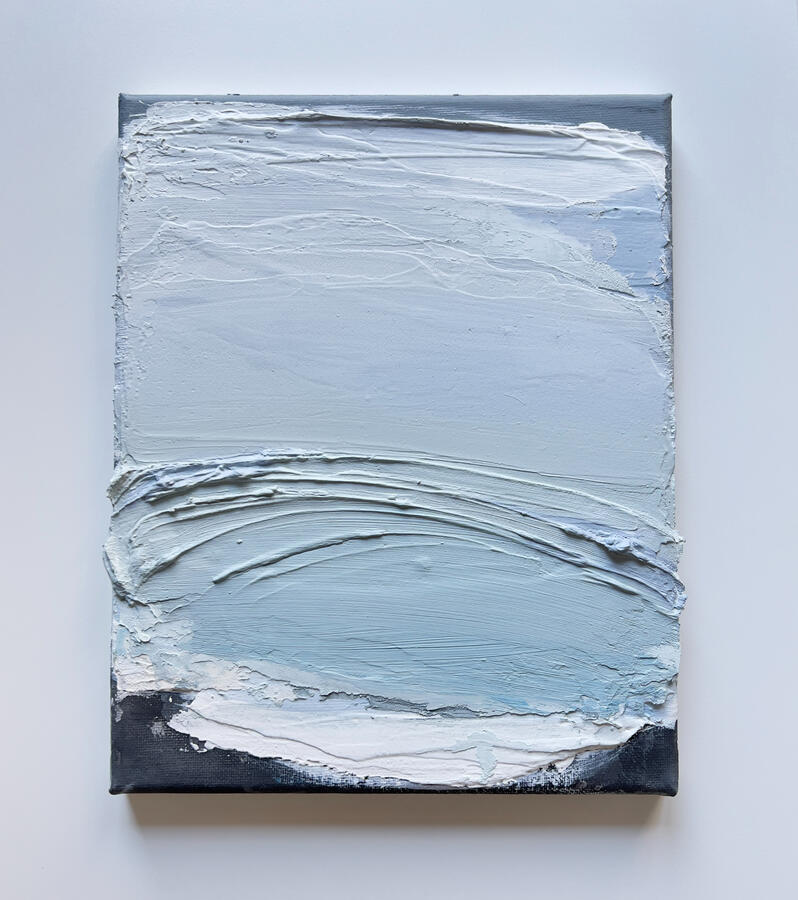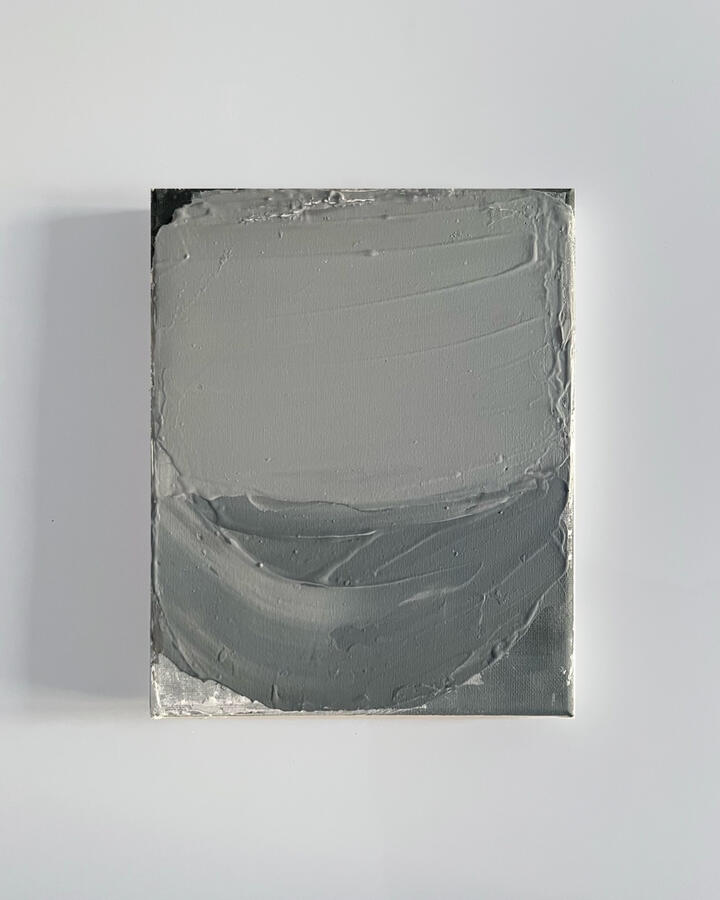Project Meratas
FinTech | Interaction Design | UI Design | UX Research
Company: Meratas/Career-Bond
Role: UX Designer
Focus: Redesigning a FinTech loan platform to increase user trust and improve conversion through clarity and transparency.
Deliverable: Research-backed UX proposal presented to client stakeholders.
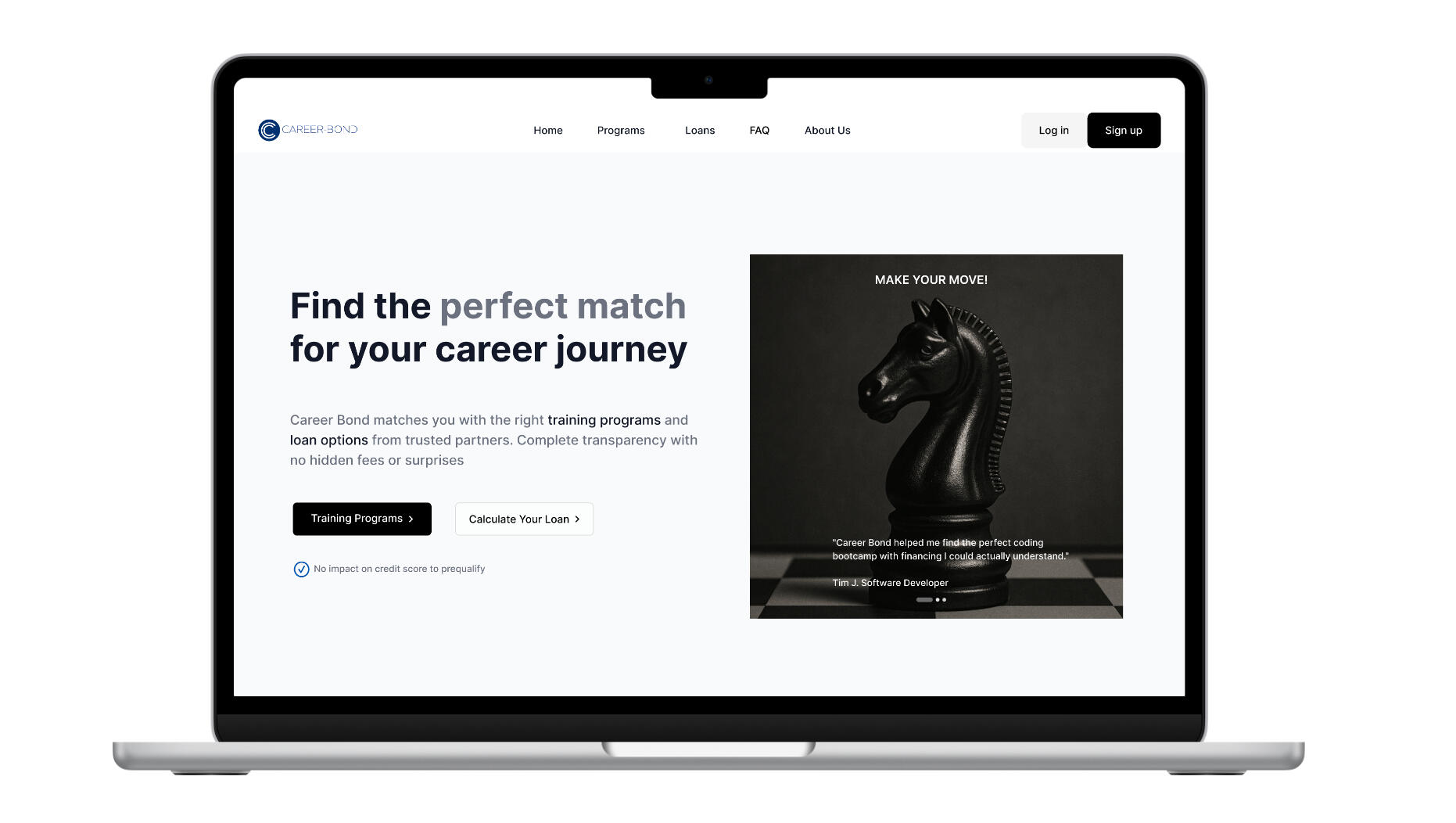
Project Earthwin
Environmental | UX/UI Design | Advanced Prototyping | UX Research
Company: Earthwin
Role: UX Designer
Focus: Designed a concept platform connecting eco-actions to real impact. Built an AI-visual game interface turning user emotion into measurable action through tokens and transparent rewards.
Deliverable: High-fidelity prototype demonstrating interactive reward mechanics and sustainable user journeys.
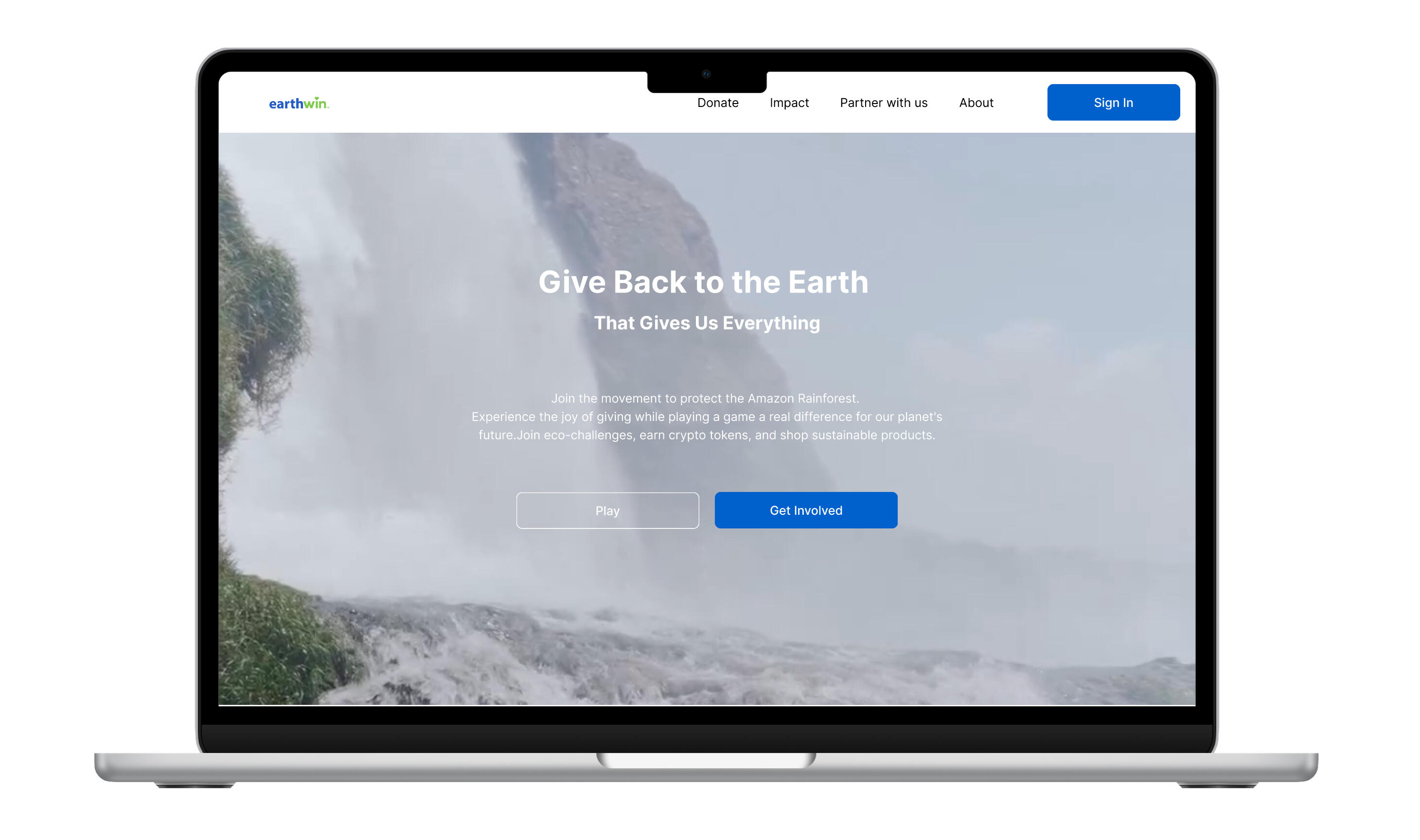
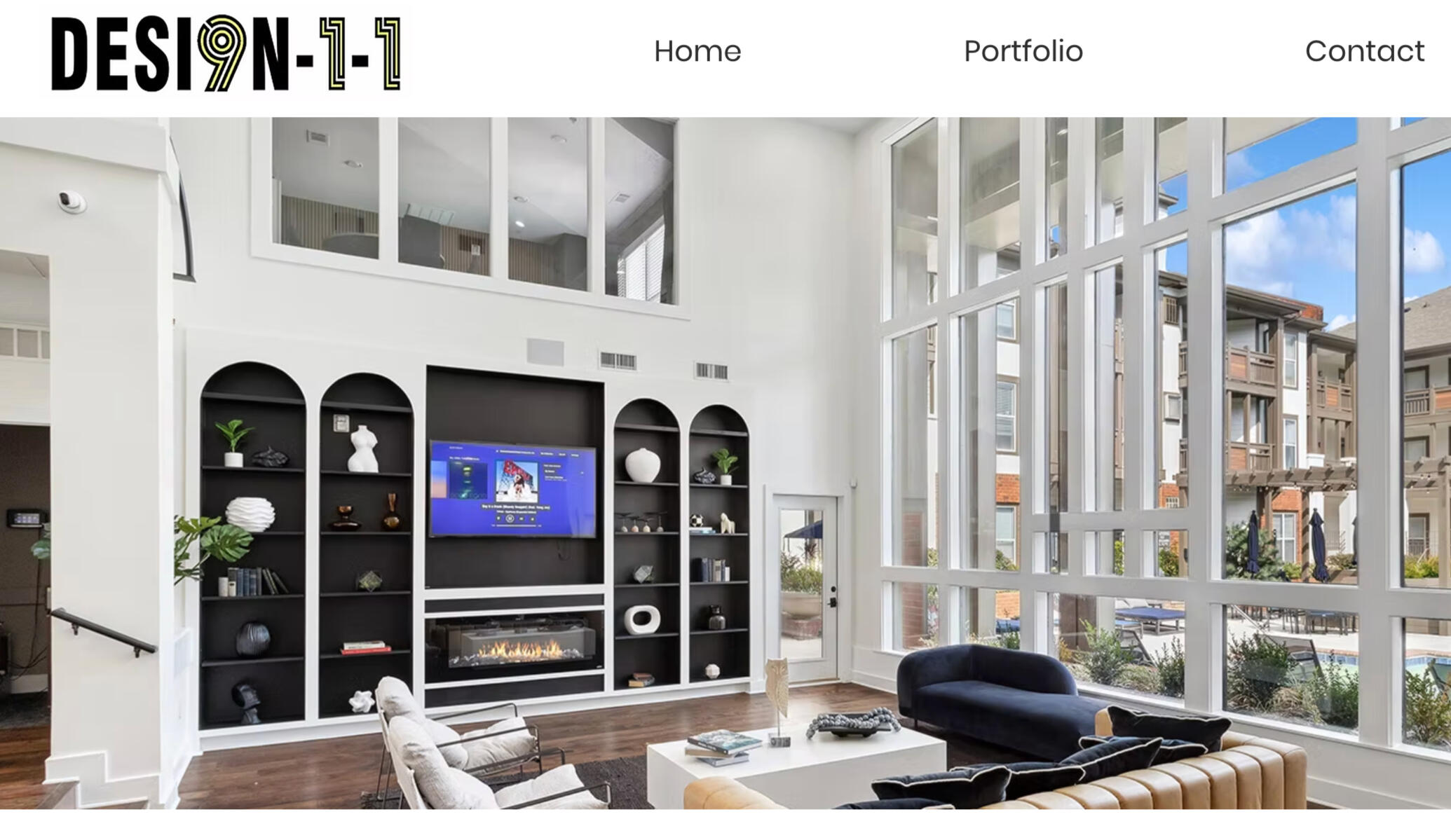
Project Desi9n-1-1
AR-Lidar-Interior Design | UX Research | Advanced Research | Interaction Design
Company: Desi9n-1-1
Role: UX Researcher
Focus: Investigating user trust and adoption for an AR-based LiDAR wellness scanner.
Deliverable: Comprehensive research report and MVP recommendations.
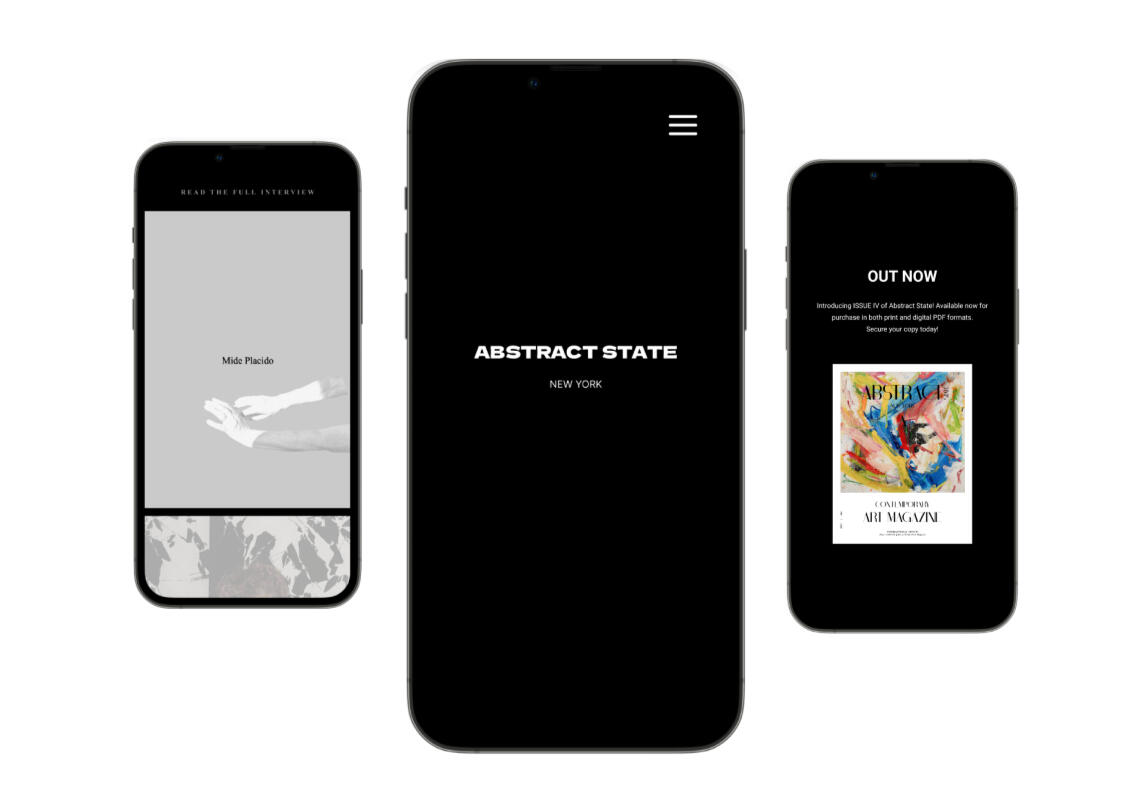
Project Abstract State
Art | Product Design | Branding | Editorial |UX/UI Design
Company: Abstract State
Role: Founder & Product Designer
Focus: Contemporary art magazine + digital platform (brand, editorial, website, e-commerce).
Deliverable: Quarterly print & digital issues; integrated website and shop.
COMING SOON...
Desi9n-1-1
AR LiDAR Interior Design | Research Project
This project explored how AR and LiDAR can enhance human awareness of indoor environmental health. The study examined how data visualization can make invisible toxins visible, understandable, and actionable, bridging the gap between data and personal design decisions.
⚡ AT A GLANCE
Role: • Role: UX Researcher & Strategist • Deliverable: Strategic MVP roadmap + AR concept validation
Research
• 60+ participants, mixed methods (card sorting, photo elicitation, journey mapping)
Challenge
Users lack compact tools to identify which furniture causes poor air quality
Solution
Strategic MVP roadmap prioritizing mobile-first, scientific evidence, and source identification
Impact
100% mobile preference validated; defined 3-pillar adoption framework for AR health tech
| %100 | 60+ | 44% |
|---|---|---|
| Mobile Preference | Research Participants | Use No Health Tools |
| All participants chose smartphones over tablets or AR glasses | 9 surveys + 2 in-depth interviews + 50+ group survey | Gap in current wellness monitoring solutions |
The Challenge
Indoor air quality monitoring faces three critical barriers
preventing user adoption and actionable decision-making:Problem 1: The Source Gap (User Pain Point)
Users lack compact tools to identify which specific furniture
or design elements are causing poor air quality. Existing
solutions show aggregate data but don't pinpoint the toxin
source.Problem 2: The Awareness Gap (Market Opportunity)
44% of surveyed users use NO tools to monitor home health,
despite growing wellness awareness. Current solutions prioritize
aesthetics over actionable health intelligence.Problem 3: The Trust Gap (Adoption Barrier)
Users distrust AI-generated health alerts without scientific
backing or expert validation, creating resistance to new
monitoring technologies.
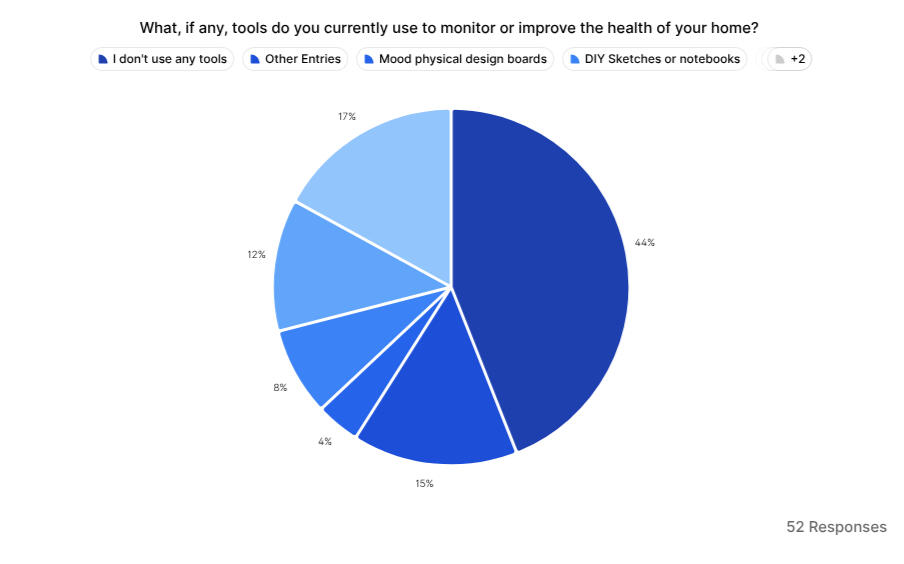
Understanding the User
Through Mixed-Methods Research we studied behavior, trust, and adoption factors.Participant BreakdownTech & Design Professionals: The largest group, critical for testing assumptions on AR/LIDAR adoption (6 participants).Wellness-Focused Homeowners: The core target market, focused on health outcomes (3 participants).Interior Design Enthusiasts: Focused on aesthetics and style integration (2 participants).
| 2 | 9 | 50+ | +60 |
|---|---|---|---|
| In-depht interviews | Indivual Survey | Group Survey | Total Research Participants |
Research Approach
Methods used:• Card Sorting → Feature and trust-factor prioritization• Photo Elicitation → Space psychology & visual preferences• Journey Mapping → Reactions to air-quality alerts and decision flows• Surveys + Interviews → 60+ participants
Central Research Question
What would you do if your smart device alerted you about poor air quality?
This question became the foundation for understanding user behavior, device preferences, and trust dynamics.
Key Strategic Insights
Finding 1: Trust Requires Scientific Evidence Users rely on scientific data and expert validation (not AI alone) to trust health alerts. Transparency is non-negotiable for adoption.
→ Solves Problem 3 (Trust Gap)
Finding 2: 100% Mobile-First Preference. All participants chose smartphones over tablets or AR glasses,proving the need for a mobile-first strategy.
→ Solves Problem 1 (Compact Tool Need)
Finding 3: Predictable User Behavior Pattern Alerts trigger immediate response: Identify Source → Research Solutions → Consult Professionals. Design must support this natural flow.
→ Solves Problem 2 (Actionable Intelligence)
Finding 4: Minimalist Aesthetics = Trust 66.7% preferred minimalist environments, linking clean visual design to wellness perception and control.
→ Informs Visual Strategy
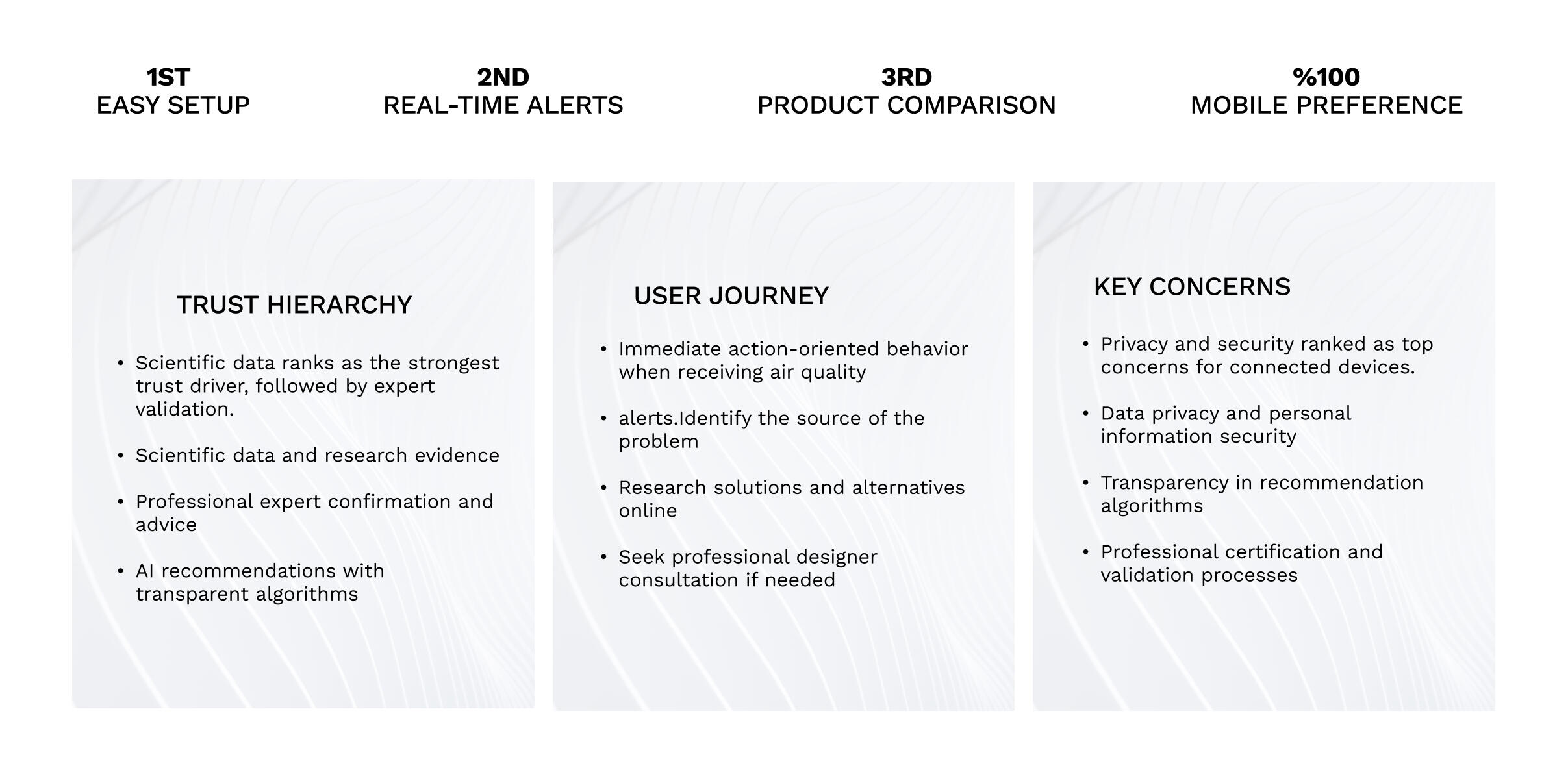
Strong Mobile Preference
100% of participants chose smartphones over tablets or AR glasses, proving the need for a Mobile-First strategy..
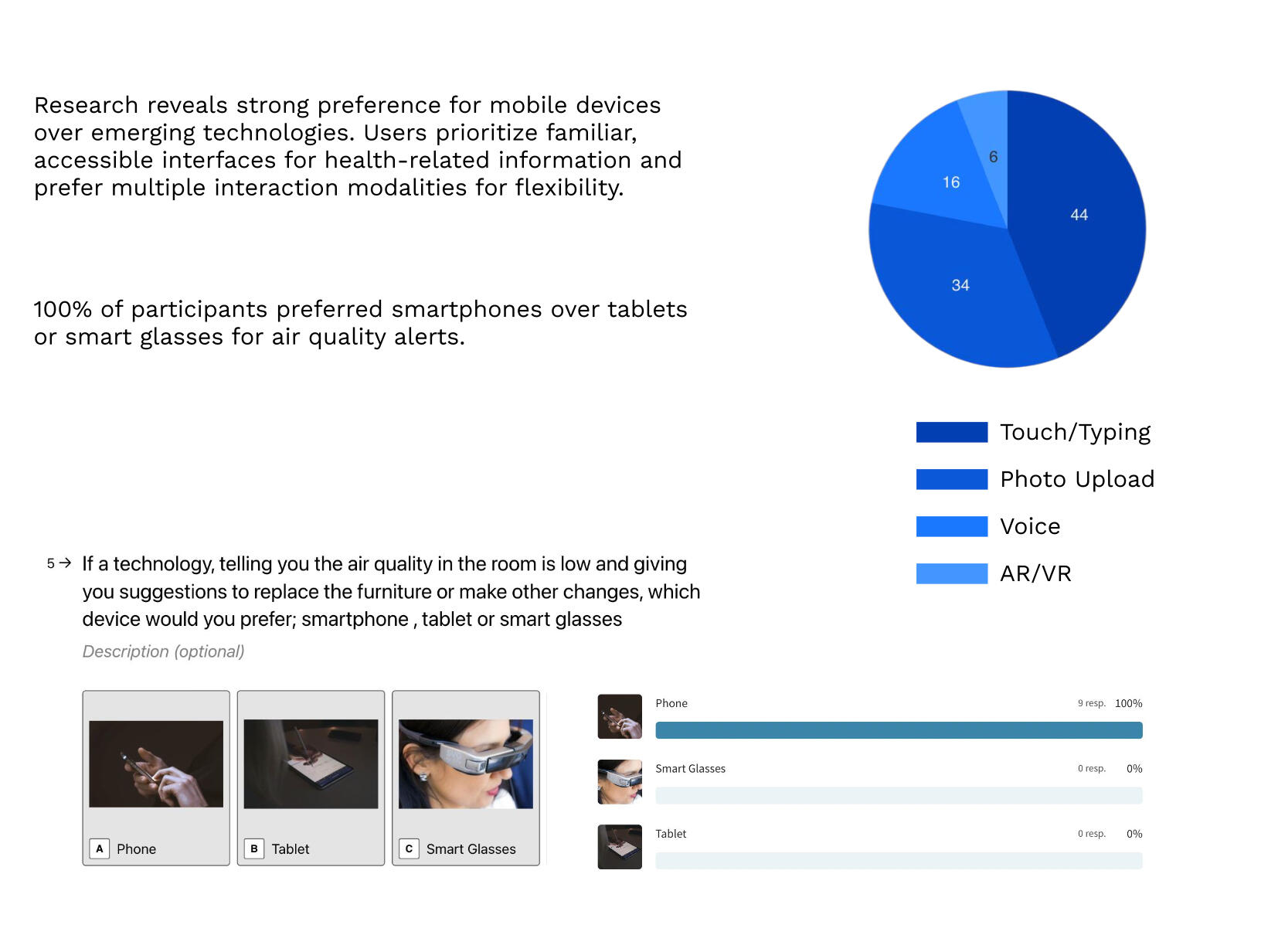
Behavior Orientation
Alerts trigger a predictable, immediate response: Identify Source, Research Solutions, Consult Professionals.
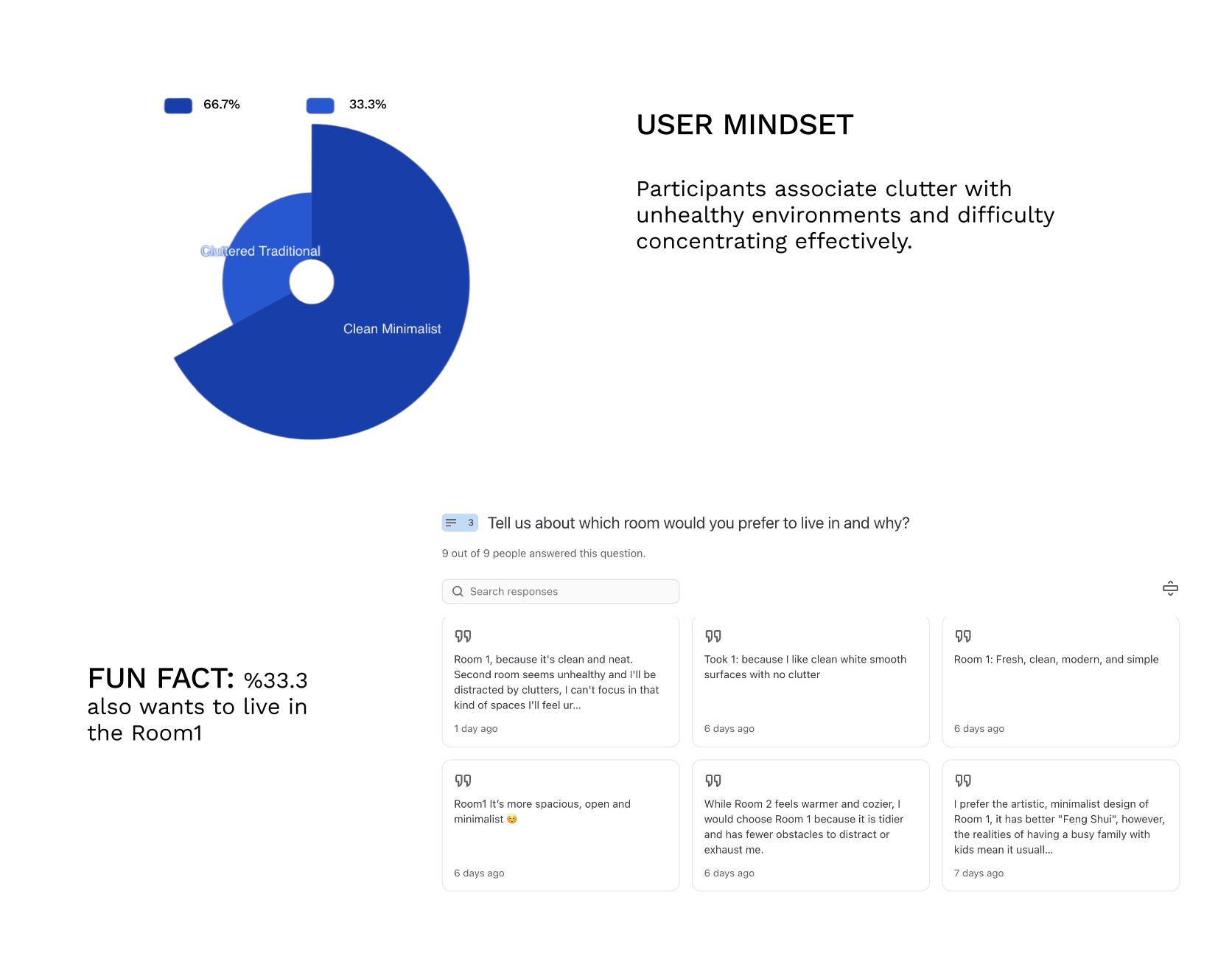
Space Psychology
66.7% preferred minimalist environments, linking clean design to wellness and control.
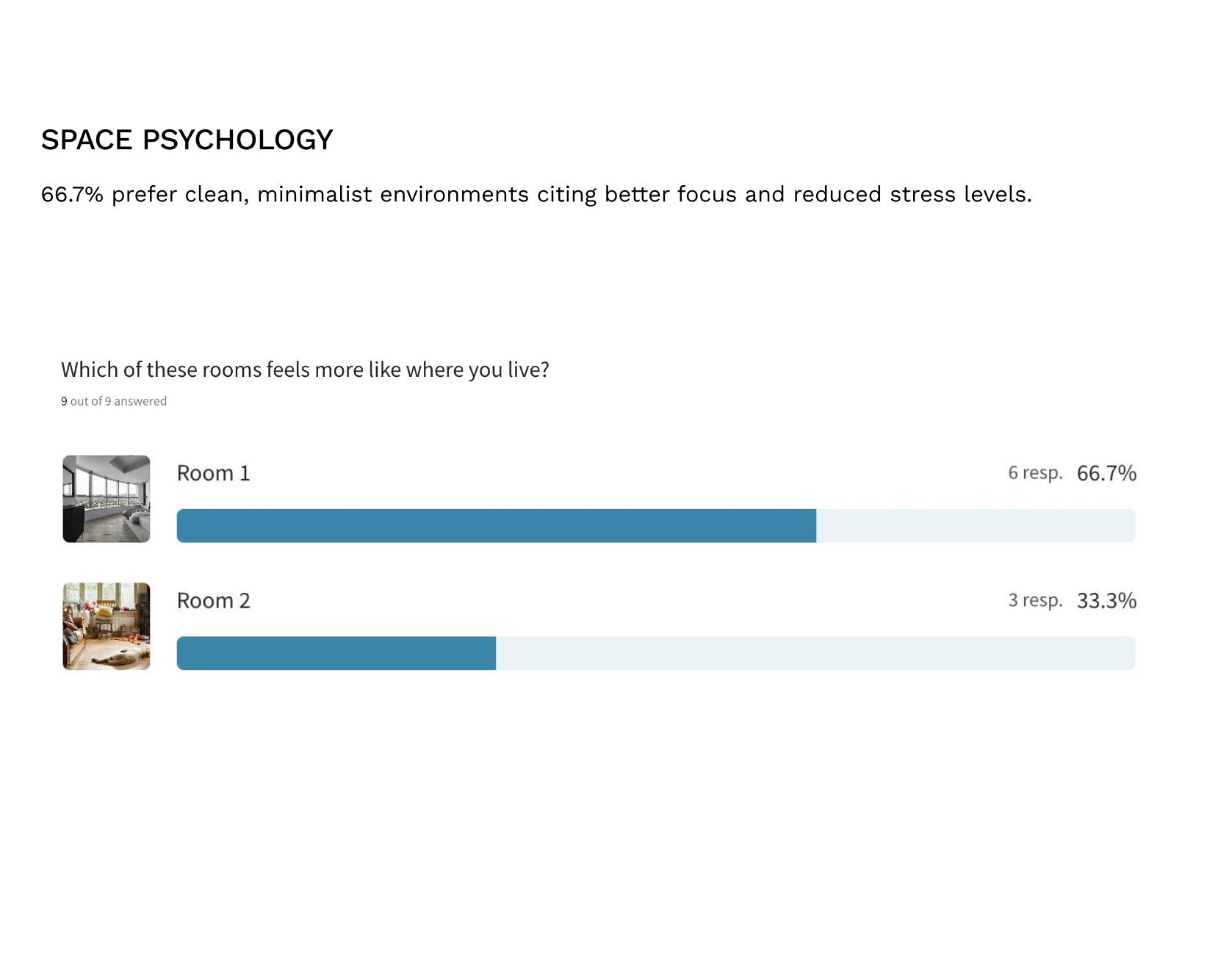
Strategic MVP & Design Implications
Based on research findings, the strategic recommendations directly address each identified barrier:Strategic Recommendations for MVP→ Solves Problem 1 (Source Gap): AR-LiDAR pinpoints toxin source in furniture.→ Solves Problem 2 (Market Gap): Mobile-first approach targets 44% non-adopters.→ Solves Problem 3 (Trust Gap): Scientific evidence + expert validation frameworkResearch exposed a clear direction for Tanit's MVP, focusing on three core pillars: Mobile-First, Trust Through Evidence, and Comparison Features.
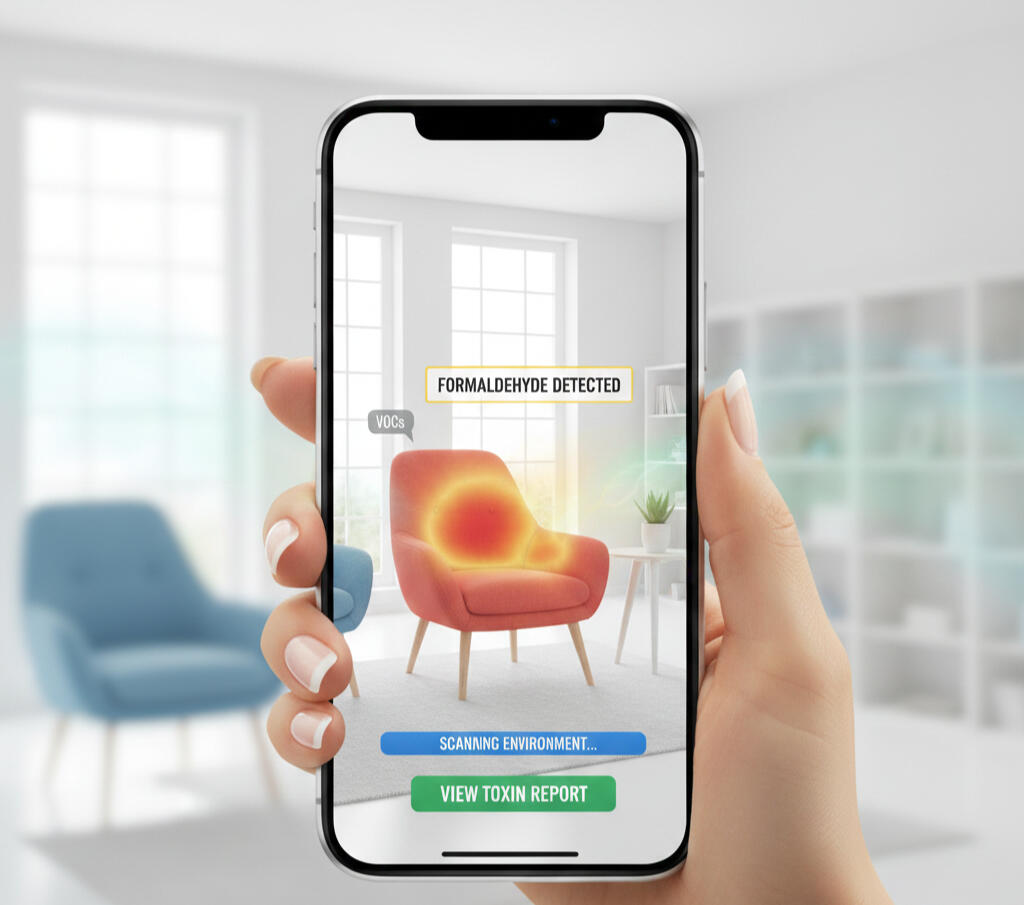
Conclusion & Next Steps
This 7-week research cycle revealed that trust, transparency, and simplicity shape adoption of complex technologies. By merging behavioral psychology with LiDAR data, the platform transforms air-quality monitoring into an active decision-making support tool.Implementation Roadmap: Next steps include creating an interactive mobile prototype focused on the Scan, Diagnose, Act user flow, followed by prototype validation with environmental experts and AR testing in real homes.
Earthwin
Environmental | Advanced Prototyping | Behavioral Design
Project Goal Redesigning a sustainability platform to drive sustained user engagement by connecting micro-actions to measurable, transparent impact.
⚡ AT A GLANCE
Role: UX Designer • Behavioral Design
Deliverable: High-fidelity prototype with behavioral system, token economy, and blockchain integration
Research
• 4 user interviews
• Heuristic analysis
• Behavioral mapping
Challenge
• Emotional detachment from abstract goals
• Single-use donations, no sustained engagement
• 3 complex systems to integrate (game, crypto, tracking)
Solution
• Earth Fighters game (behavioral system)
• Token-based reward economy
• Blockchain-verified impact proof
Impact
"I'd do something if I could see it matter" (4/4 users)
• Frustration → sustained action
• Prototype delivered to stakeholders
The Challenge
The project required overcoming three interconnected challenges that prevented sustained engagement with environmental action.Problem 1: Emotional Detachment (User Research Finding)
Users felt powerless and emotionally disconnected from abstract
environmental goals, leading to single-use donations and
abandonment.Problem 2: Trust & Complexity Barrier (Strategic Challenge)
The platform needed to integrate three high-friction technologies
(behavioral system, cryptocurrency, impact tracking) without
overwhelming users or eroding trust.Problem 3: Hidden Features & Cluttered Navigation
Heuristic analysis revealed the existing site buried key ideas
under redundant navigation. Critical features (tokens, crypto,
game) were entirely non-existent.
Our Approach
The design began with a psychological question:
What would you do if you saw someone starting a fire in a forest?
This question revealed people’s emotional extremes anger, urgency, and helplessness.
While mining or deforestation felt distant and corporate, fire provoked personal outrage. That became the foundation of the design system: a platform that channels emotional energy into constructive action.The goal wasn't to gamify environmentalism for fun; it was to transform frustration into purpose through a Psychology-First System.
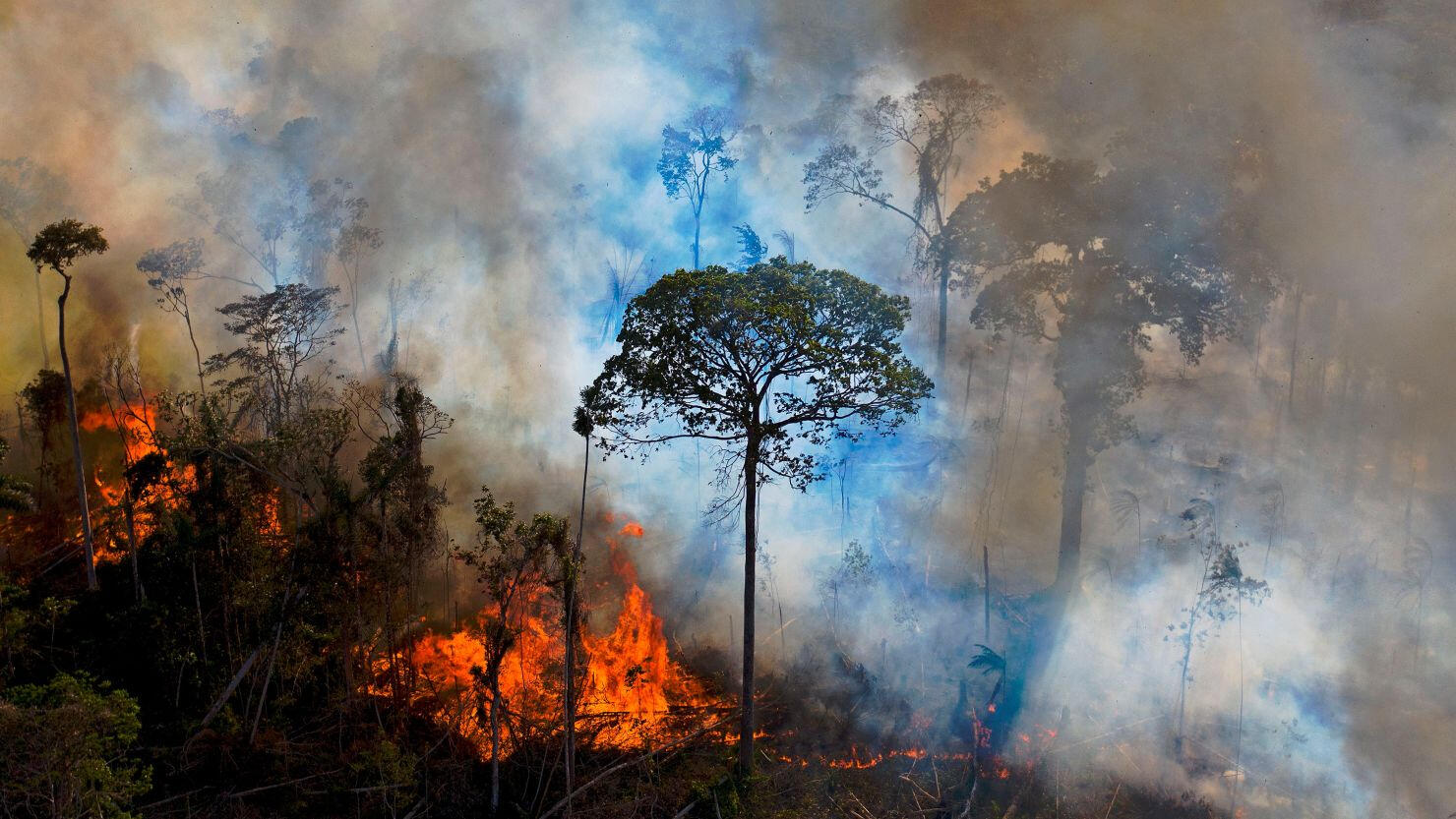
We replaced the ambiguity of typical gamification with clear functions:- Behavioral System (The Game): Provides the emotional release valve and sustained motivation for the user.- Crypto Tokens: Provides tangible, verifiable proof of real-world impact and contribution.
Understand The Business: The Eco-Cycle
The core business objective was to ensure long-term participation through a verifiable funding model. Based on the user research, I reframed the platform's concept into a functional loop that makes the emotional investment tangible:Play (Channel frustration into the game) → Earn (Tokens/Reward) → Convert (Tokens to Crypto/Funding) → Contribute (Real-world impact)This functional model bridges the digital action with the financial outcome, ensuring emotional engagement directly drives transparent funding and participation.
Understand The User
Interviews showed that people care deeply about nature but disengage when they can’t see results. They needed emotional connection, visible progress, and proof that their actions had meaning.
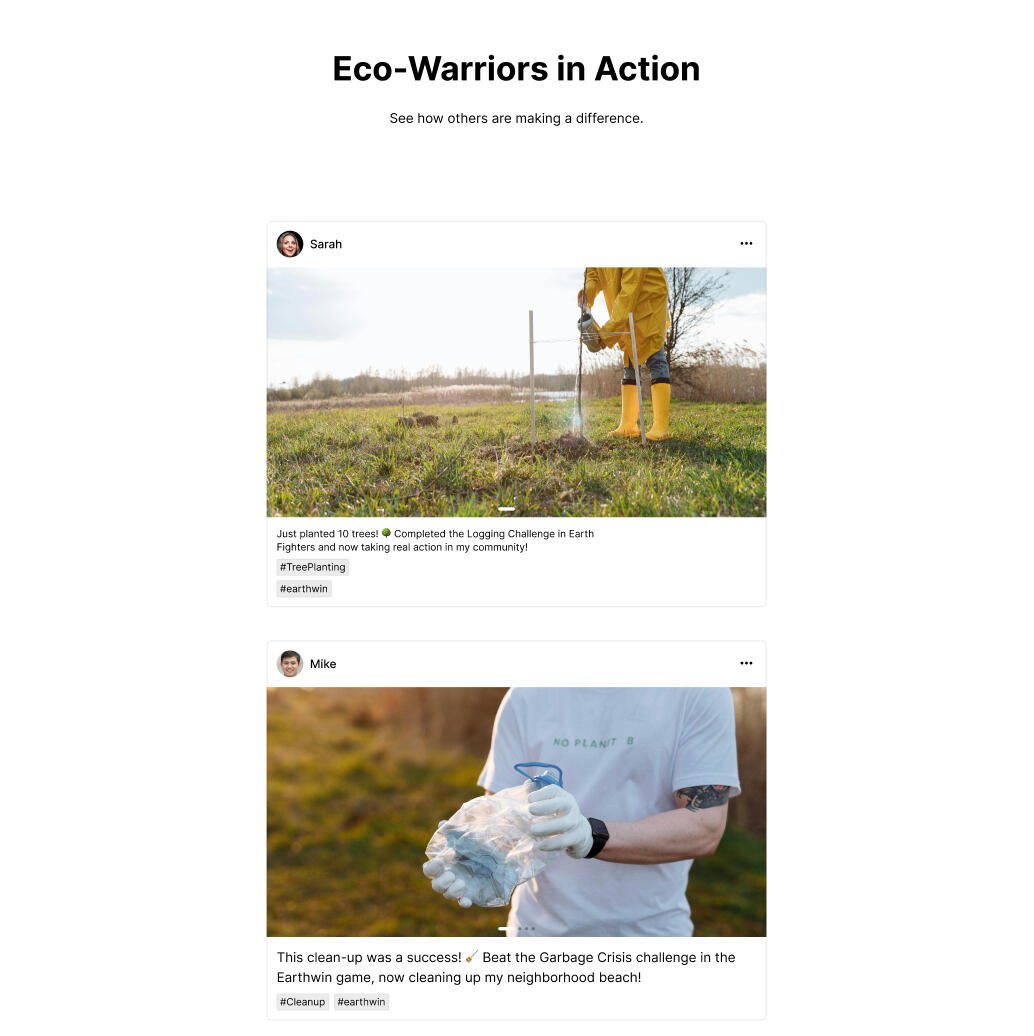
The Key Quote:
“I’d do something if I could actually see it matter.”
This insight shaped the product vision: make environmental action transparent, rewarding, and emotionally validating.
Research MethodologyThrough in-depth interviews with 4 participants
-2 professionals in tech,
-1 professional in business
-1 nature enthusiast/professional modelWe conducted research to identify core emotional and behavioral barriers.
Key Diagnostic QuestionThe primary line of inquiry focused on identifying and channeling intense emotional responses: "What would you do if you saw someone starting a fire in a forest?"Finding: The resulting responses of anger, helplessness, and urgency became the psychological foundation for the Emotional Release Valve (The Game).
Understand The Platform
Information Architecture & Platform Design: The existing Earthwin website buried strong ideas under cluttered navigation and repetitive pages. Crucially, key features like the Behavioral System, tokens, and crypto impact tracking were entirely non-existent.
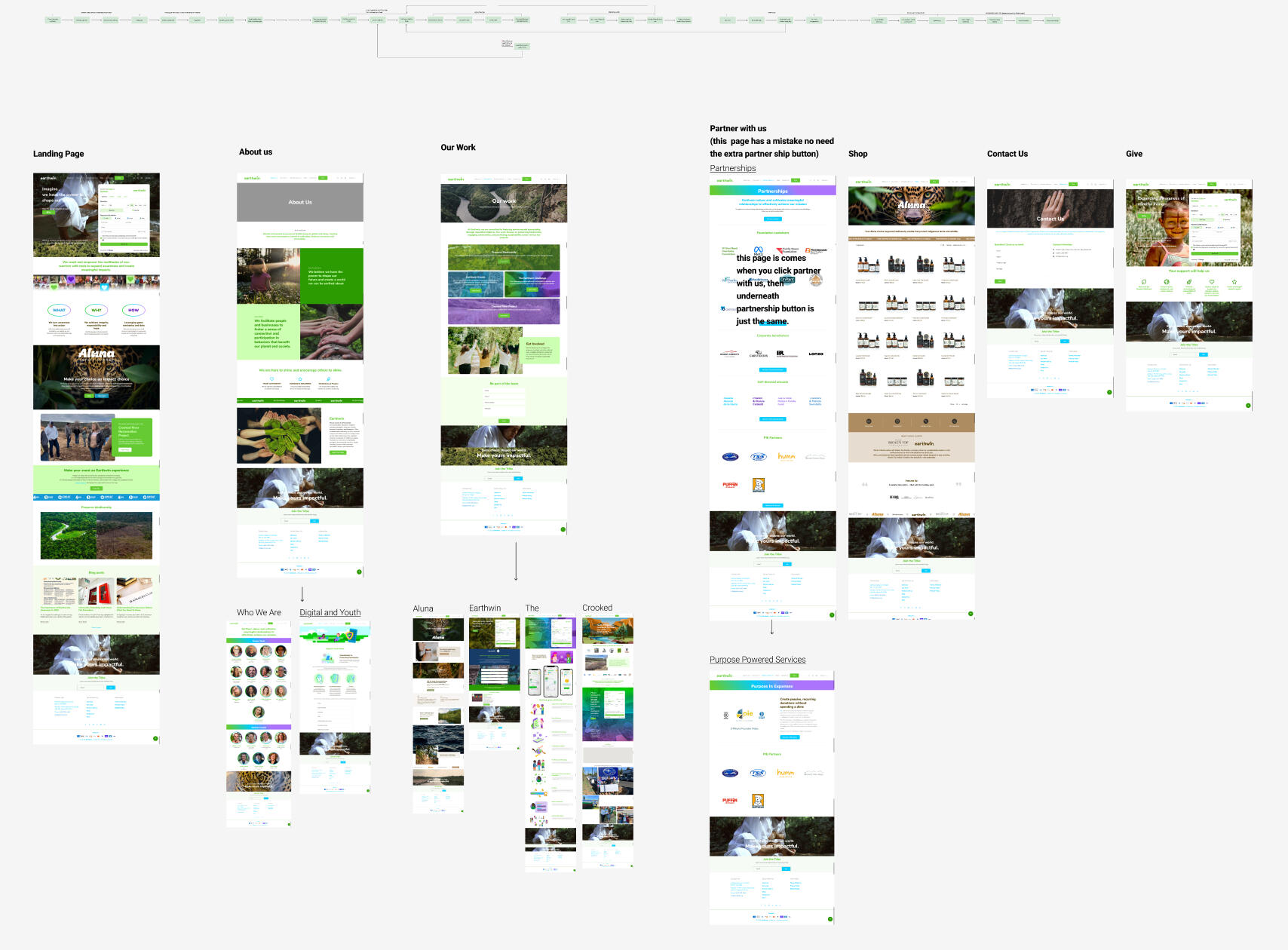
The Problem: Heuristic & Structural Flaws; During heuristic analysis, I identified a recurring issue: redundant navigation and cognitive overload. The existing structure violated principles like “Recognition Rather Than Recall” and “Aesthetic and Minimalist Design,” overwhelming users and obscuring the platform’s core message.
The Solution
The redesign focused on removing all redundancy and establishing a clear hierarchy. This structural cleanup was necessary to support the three interconnected layers (Gamify Impact, Reward Participation, Prove Contribution) detailed in the Design Direction section.
Feature 1:
Earth Fighters (Behavioral System)
Channels eco-frustration into action through gameplay.
→ Solves Problem 1: Emotional Detachment
Feature 2:
Smart Token Economy
Impact currency for donations and eco-purchases.
→ Solves Problem 1 & 2: Sustained engagement
Feature 3:
Blockchain-Verified Impact
Transparent proof of real-world contribution.
→ Solves Problem 2 & 3: Trust & complexity
Designing the Solution
To transform feelings of powerlessness into meaningful action, I structured Earthwin around three interconnected layers:
Gamify Impact: Users earn tokens through eco-challenges based on real-world issues like fire, mining, and pollution.Reward Participation: Tokens act as impact currency that can be used for donations or eco-friendly purchases.Prove Contribution: Tokens convert into Earthwin cryptocurrency, providing blockchain-verified proof of contribution.
Each interaction built trust, motivation, and measurable impact.
Psychology-Based Design
Research showed that frustration, not apathy, drives disengagement.
Earthwin’s design turned that frustration into meaningful participation.Framework:
Emotional Release Valve → Safe outlet for eco-anger through gameplay.Immediate Gratification → Token rewards sustain motivation.Long-Term Value → Cryptocurrency creates visible, lasting proof of impact.
Smart Token Flow
Research showed that frustration, not apathy, drives disengagement.
Play and Earn → Users gain tokens through eco-actions (donations, invites, purchases).Gift and Grow → Tokens can be gifted to support trees or carbon offset projects.Prove and Store → Tokens convert to crypto, creating verifiable blockchain records of contribution.
Flow & Structure
Earthwin’s ecosystem is designed as a self-sustaining cycle that motivates action and rewards participation.
The user journey follows a clear rhythm of Discover → Act → Earn → Prove → Share, ensuring every interaction feels purposeful and connected.Each part of the experience dashboard, game, shop, and volunteer hub feeds into this loop:
users discover environmental challenges, take meaningful action, earn impact tokens, and see their verified contributions visualized in real time.This structure keeps engagement continuous and reinforces Earthwin’s core goal:
turning environmental emotion into measurable impact.

Discover →

Act & Earn →

Prove →

Share
The Game: Earth Fighters (A Behavioral System)
Earth Fighters is the Emotional Release Valve where users channel frustration into positive action. The game was designed as a behavioral bridge between awareness and action, founded on the intense emotional responses (anger, helplessness, and urgency) discovered during user interviews.
Design Intent
The goal wasn’t to build just a game, but a Behavioral System, a space where frustration meets creation. By visualizing environmental action as a heroic journey, the interface motivates users to keep playing, contributing, and believing their actions matter.
Concept
Players explore real-world environmental issues (wildfires, mining, logging, and waste) and respond through symbolic gameplay that rewards constructive action. Rather than fighting people, players combat “eco-threats,” using mythical avatars and elemental tools that represent protection, restoration, and regeneration.Crucially, the tokens earned in gameplay are the direct funding mechanism, converting into real-world eco-actions like tree planting or land preservation credits.Gameplay Flow
• Choose a region to defend (e.g., Amazon Rainforest).
• Select a character; Jaguar, Griffin or Rider, each symbolizing a different ecological archetype.
• Defeat threats to earn tokens.
• Tokens convert to Earthwin cryptocurrency, which can be used to plant trees, buy eco-products, or gift land preservation credits.
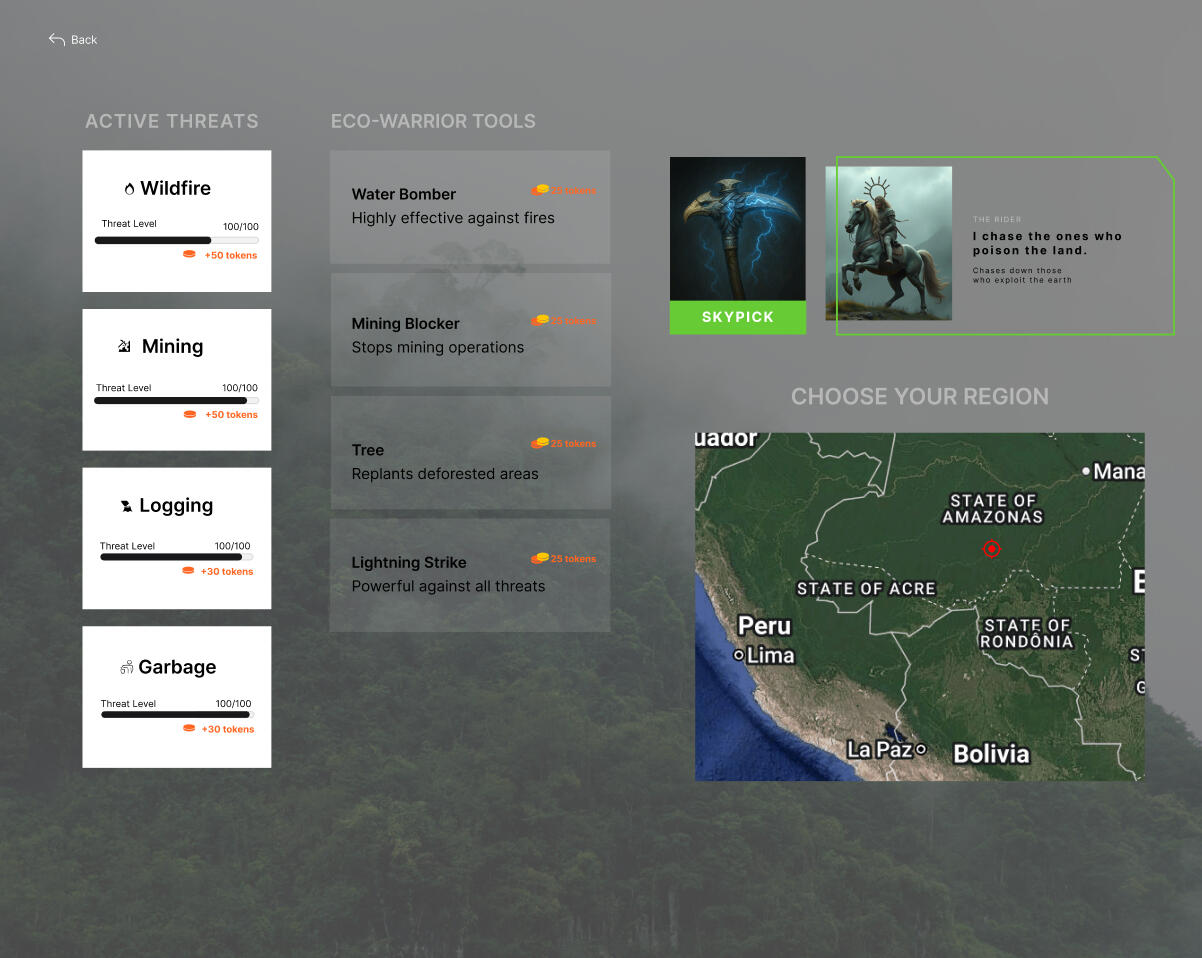
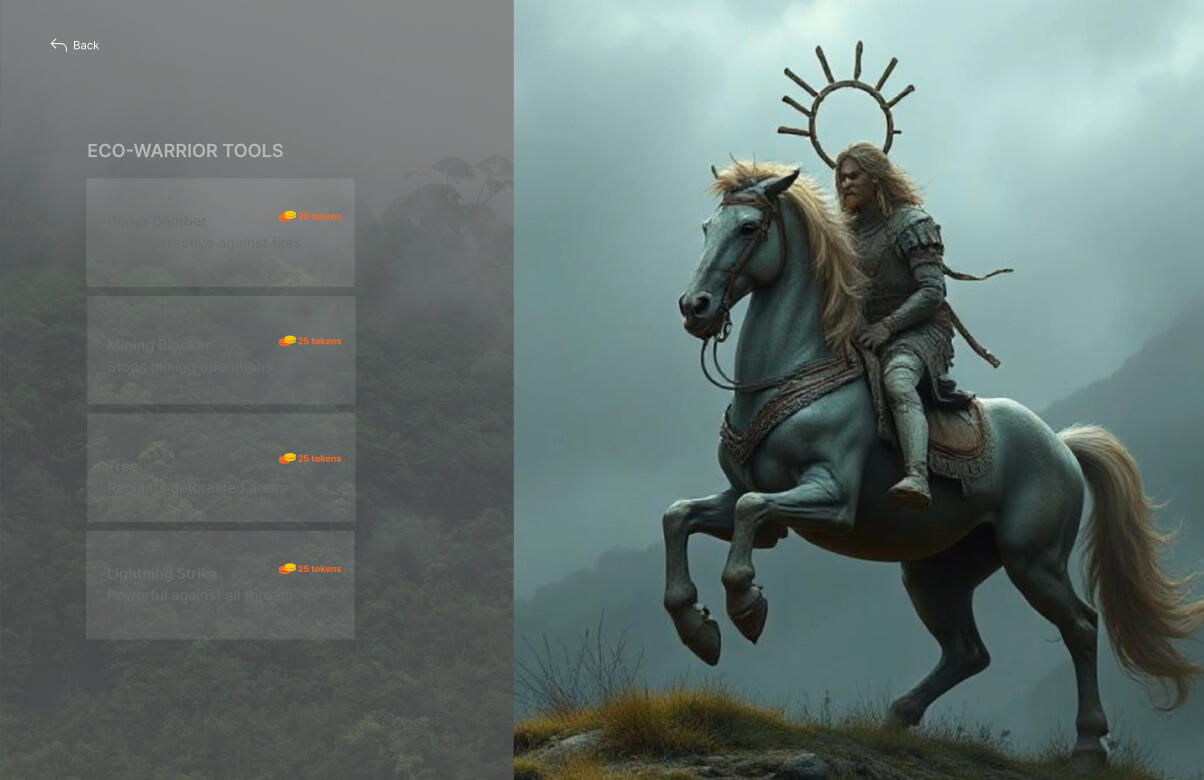
User Interface Design
Earthwin’s interface combines natural greens, deep blues, and earth neutrals to evoke authenticity and environmental harmony, intentionally building the trust necessary for a platform dealing with tokens and crypto. Subtle gradients reflect the transition from awareness to action, mirroring the user’s eco journey. Icons and motion cues are deliberately soft and circular, symbolizing continuity and community.
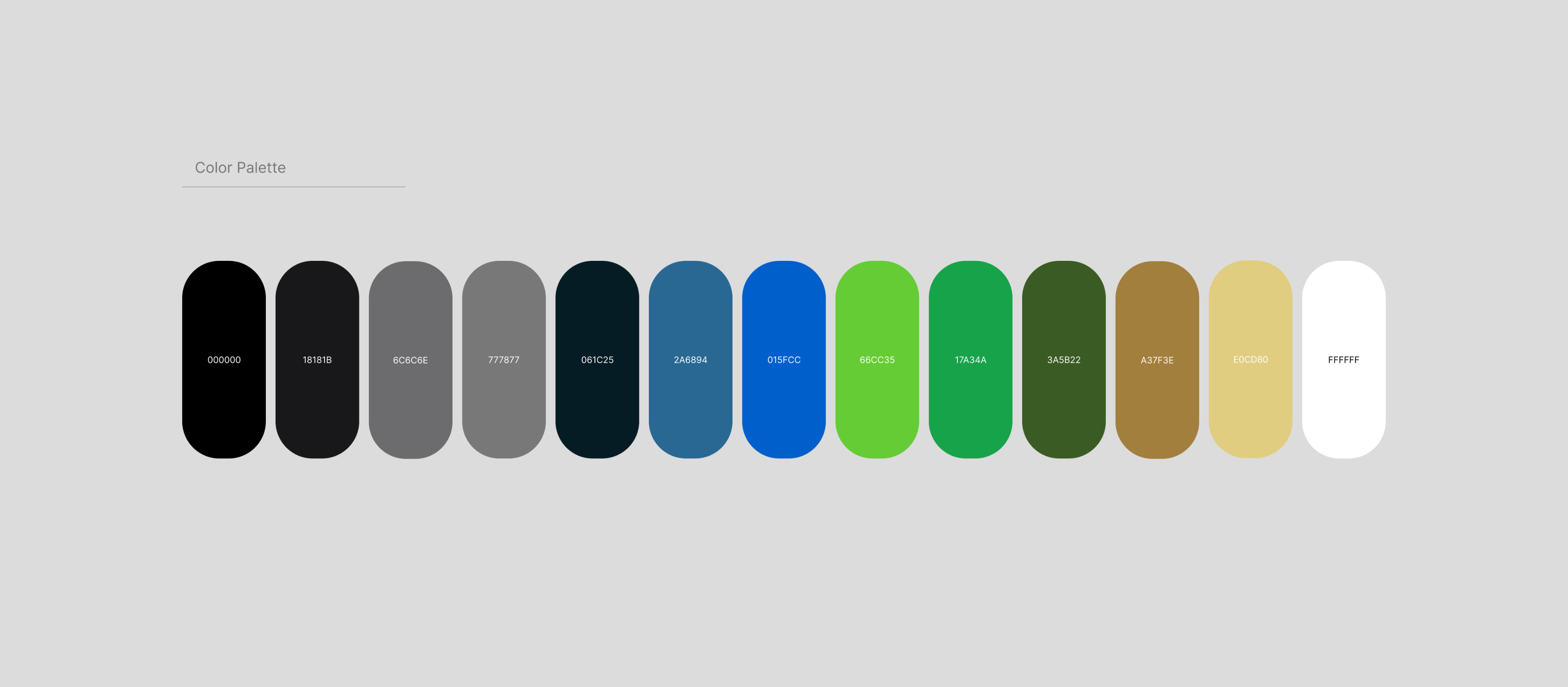
Typography uses Inter, chosen for its clarity and digital precision, ensuring readability across mobile and dashboard interfaces. Font weights (Bold,SemiBold, Medium, Regular) visually guide attention through the gamified structure: action → token → proof → reward.
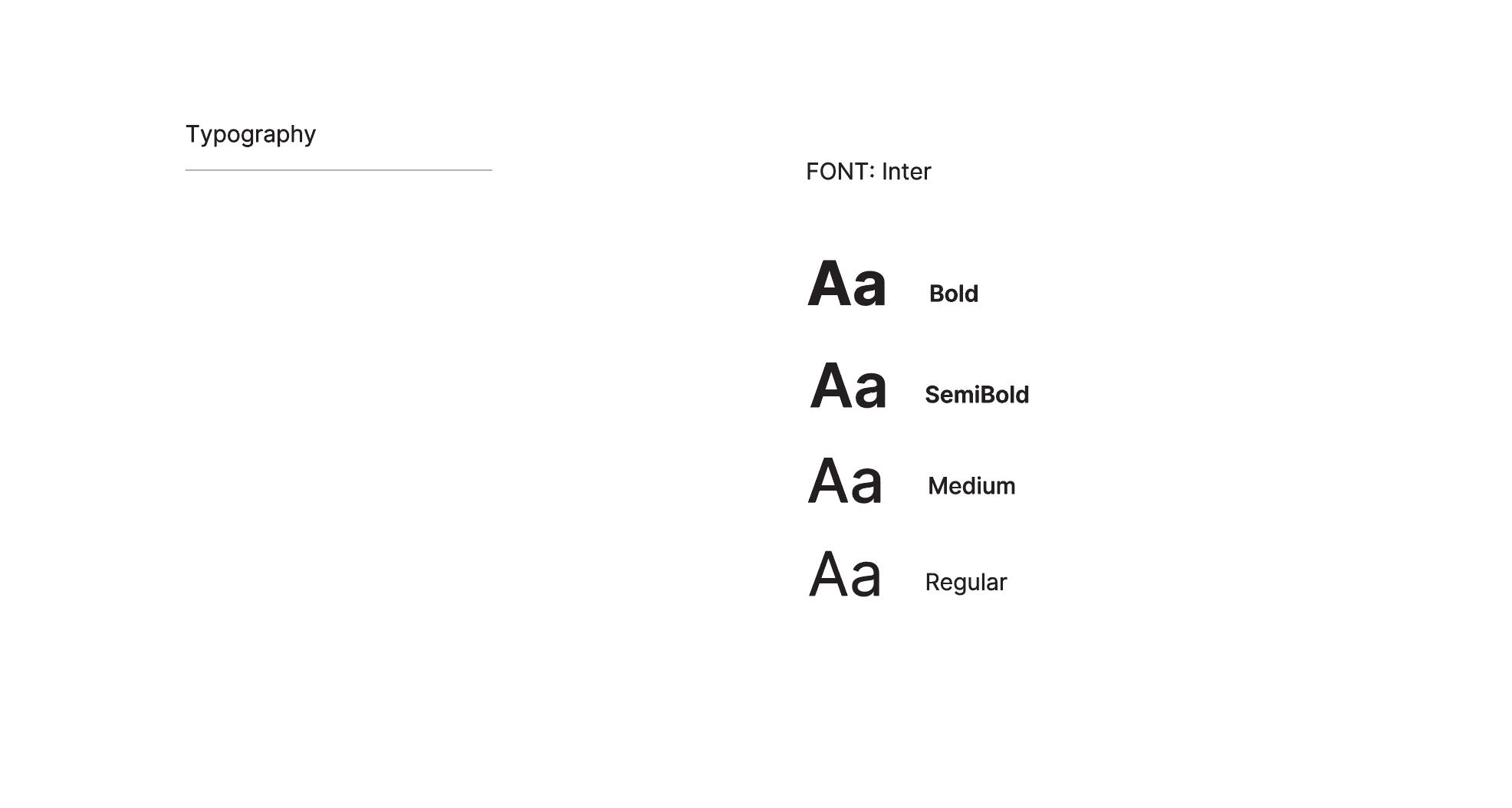
Results & Impact
The redesigned experience reframed Earthwin as a behavioral change platform rather than a donation site.
Gamification created engagement; blockchain created credibility.The concept demonstrated how digital systems can transform climate anxiety into action, turning belief into verified impact.
Meratas / Career-Bond
Fintech | UX Fundamentals Project
Career-Bond (formerly Meratas) is a fintech platform helping students finance education through flexible loan programs. This project focused on improving trust and clarity during the loan exploration and application experience.
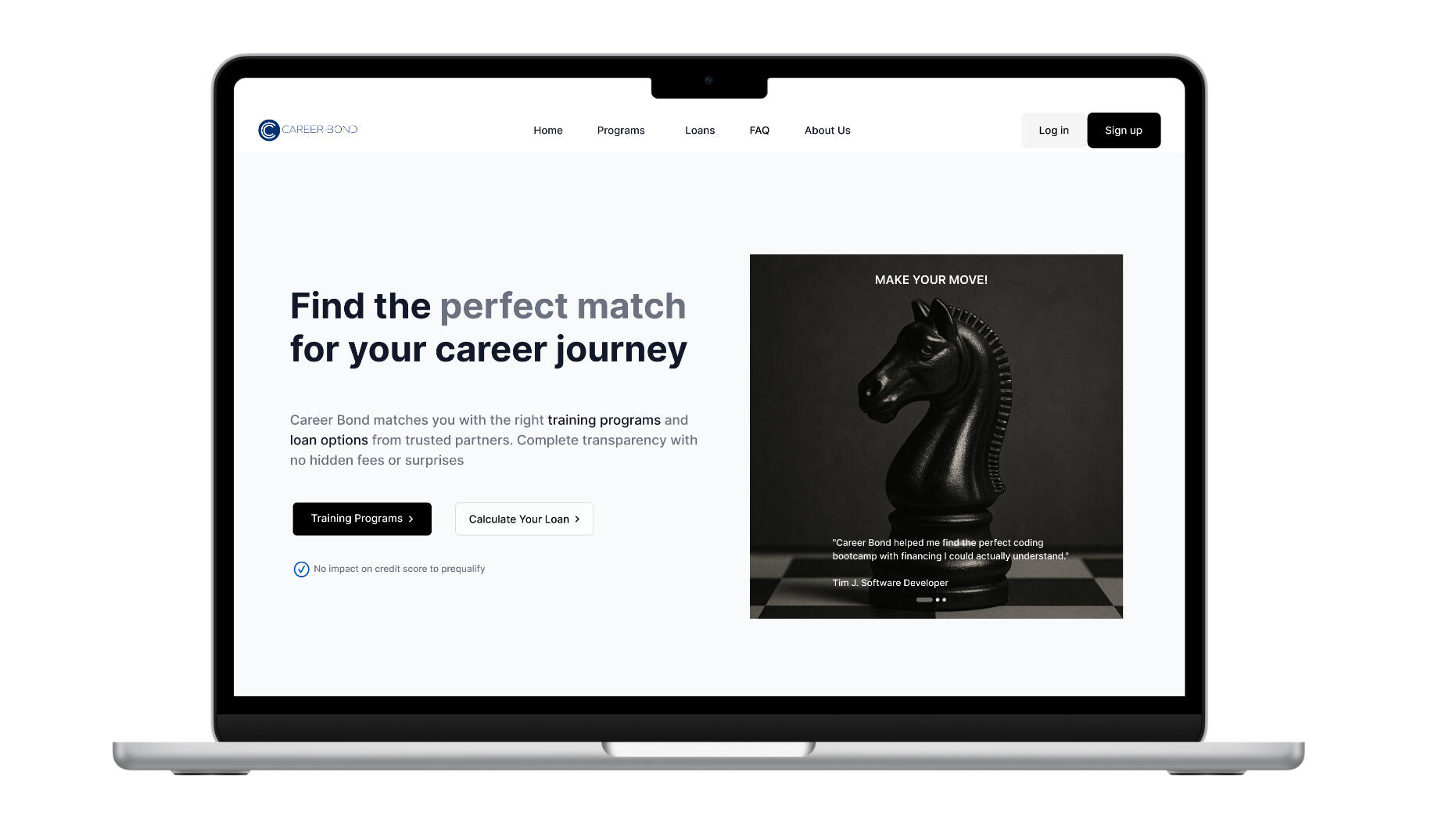
⚡ AT A GLANCE
Role: UX Designer • Deliverable: Research-backed UX proposal + interactive prototype
Research
• 4 user interviews (30 min)
• 2 usability testing rounds
Challenge
•40% distrust from hidden fees
• 30% drop-offs from confusing
• Decision paralysis
Solution
• Interactive calculator (new)
• 3-step transparent flow
• Simplified navigation
Impact
• "Clear, honest, easy" (4/4 testers)
• 100% cognitive load reduction
• Prototype delivered to stakeholders
The Challenge
Career-Bond's original platform presented complex loan details that overwhelmed users and lowered conversion rates during the application process. Many students found repayment breakdowns confusing and distrusted hidden costs. The challenge was to create a transparent, trustworthy experience that builds confidence from discovery to completion.
Problem 1:
Hidden Fee Distrust (40% of users)
The platform didn't show costs upfront. Users had to search for financial information, causing distrust and abandonment.
Problem 2:
Confusing Repayment Terms (30% drop-off)
Repayment breakdowns were unclear, making it difficult for students to understand what they'd actually owe.
Problem 3:
Decision Paralysis
Complex loan details overwhelmed users during the application process without clear guidance on what mattered most.
Our Approach
I began by asking a simple question
“Where is this trust issue coming from?”
I explored how small daily experiences shape user psychology around money and transparency.
In the U.S., a coffee labeled $4 often ends up costing $6 after tax and tip. This constant mismatch between expectation and reality subconsciously teaches people "not to trust what they see" especially in bigger financial decisions like loans. This insight became the foundation of my design approach: transparency builds trust.
Teaching society not to trust what they see!
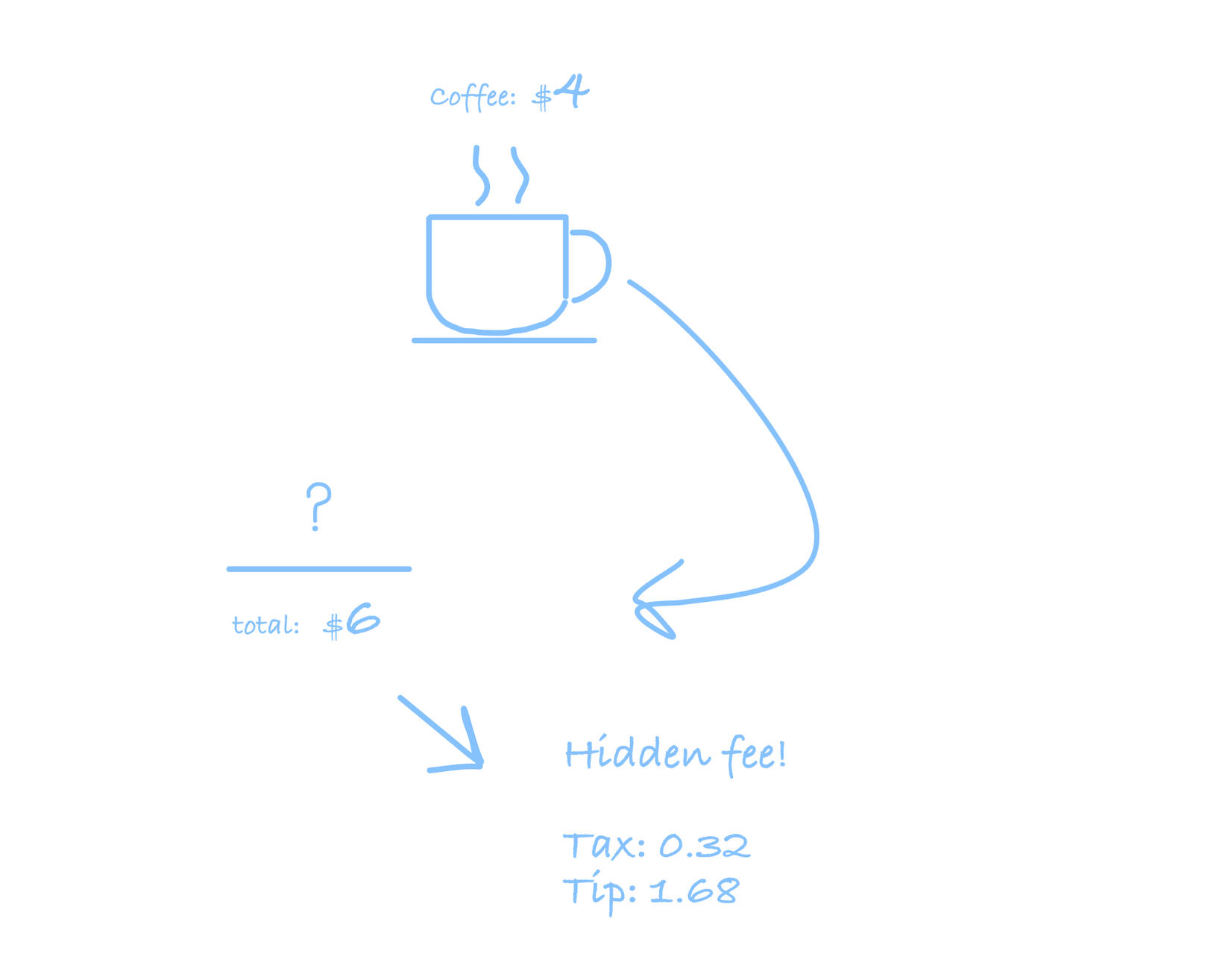
Understand The Business
During the rebrand from Meratas to Career-Bond, stakeholders aimed to increase application completion and communicate transparency as a core brand value. The UX needed to improve conversion during the application process, simplify decision-making, and reinforce credibility across every touchpoint.
Rebrand Goals:
Clarity, trust, and smoother application flow.
Understand The User
Through in-depth interviews with 4 people 2 new Master’s graduates (24 & 26 y.o.) funding bootcamps
2 career-switchers (31 & 38 y.o.) moving into tech, (30 min each) and 2 rounds of usability testing with prospective students."Exact script questions (top 3)-What’s your biggest concern when going through financial processes like this?
-Is there anything you wish these platforms offered that they currently don’t?
-What would make that process easier or more reassuring?
KEY USER INSIGHTS1. Hidden fees caused 40% distrust during signup
2. Confusing repayment breakdown led to 30% drop-offs
3. Lack of cost transparency created decision paralysis
I uncovered three core problems they faced, applicants reported;
1.Uncertainty around total cost and repayment details.
2. Many expected hidden fees and hesitated to proceed without seeing clear numbers first.
3. Trust and clarity emerged as the primary barriers to completion.
Understand The Platform
Before defining solutions, I mapped the existing CareerBond website to analyze how users moved through the loan discovery flow. Despite multiple entry points (“Apply Now,” “Tech Careers,” “Allied Health,” “Business Programs”), every button led to the same pre-qualification form regardless of intent or category.
Before
The landing page had no actionable CTAs only generic information and a single button that repeatedly led users to the personal information form.
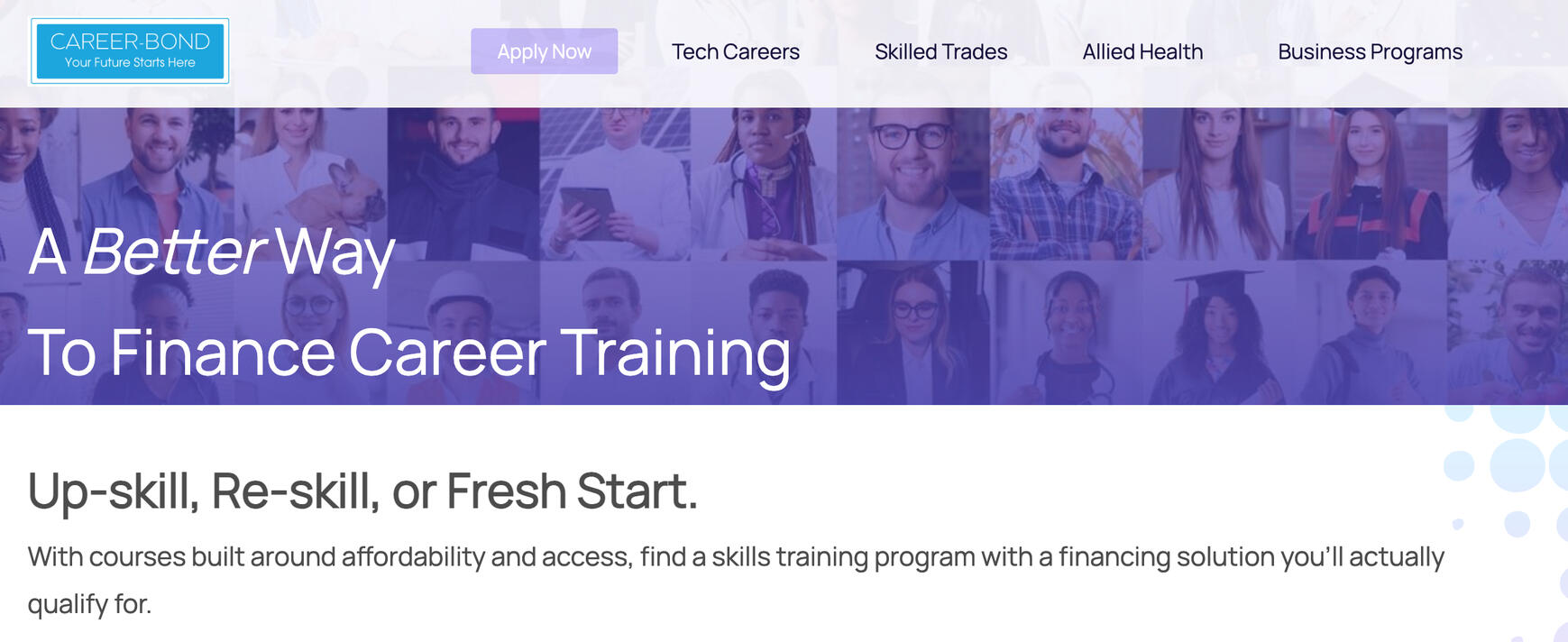
The CTA led users straight to a personal-information form without offering any real value. It looked like a three-step process, but in reality, it only collected data and after completing everything, users still had to wait for results by email.
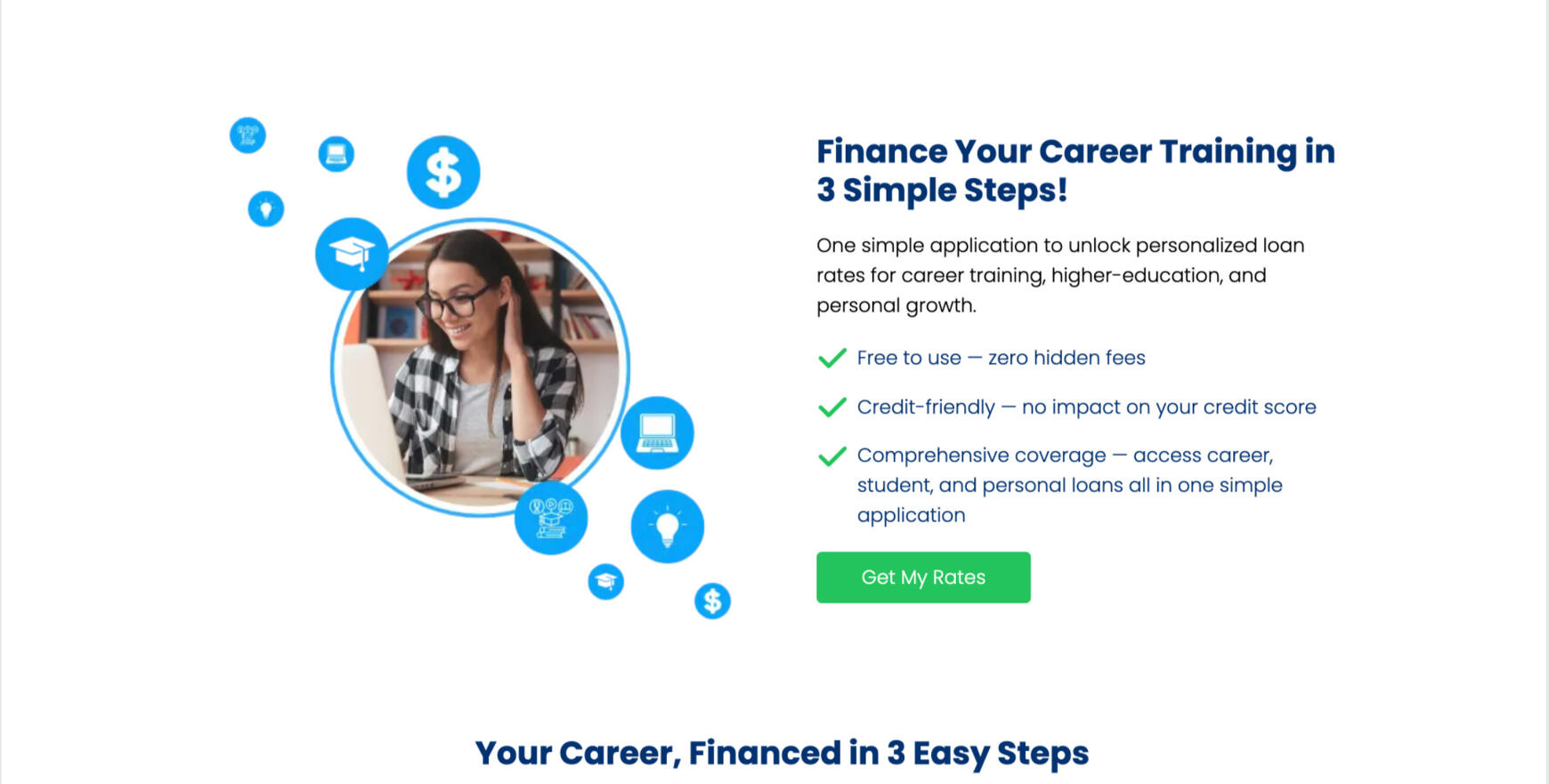
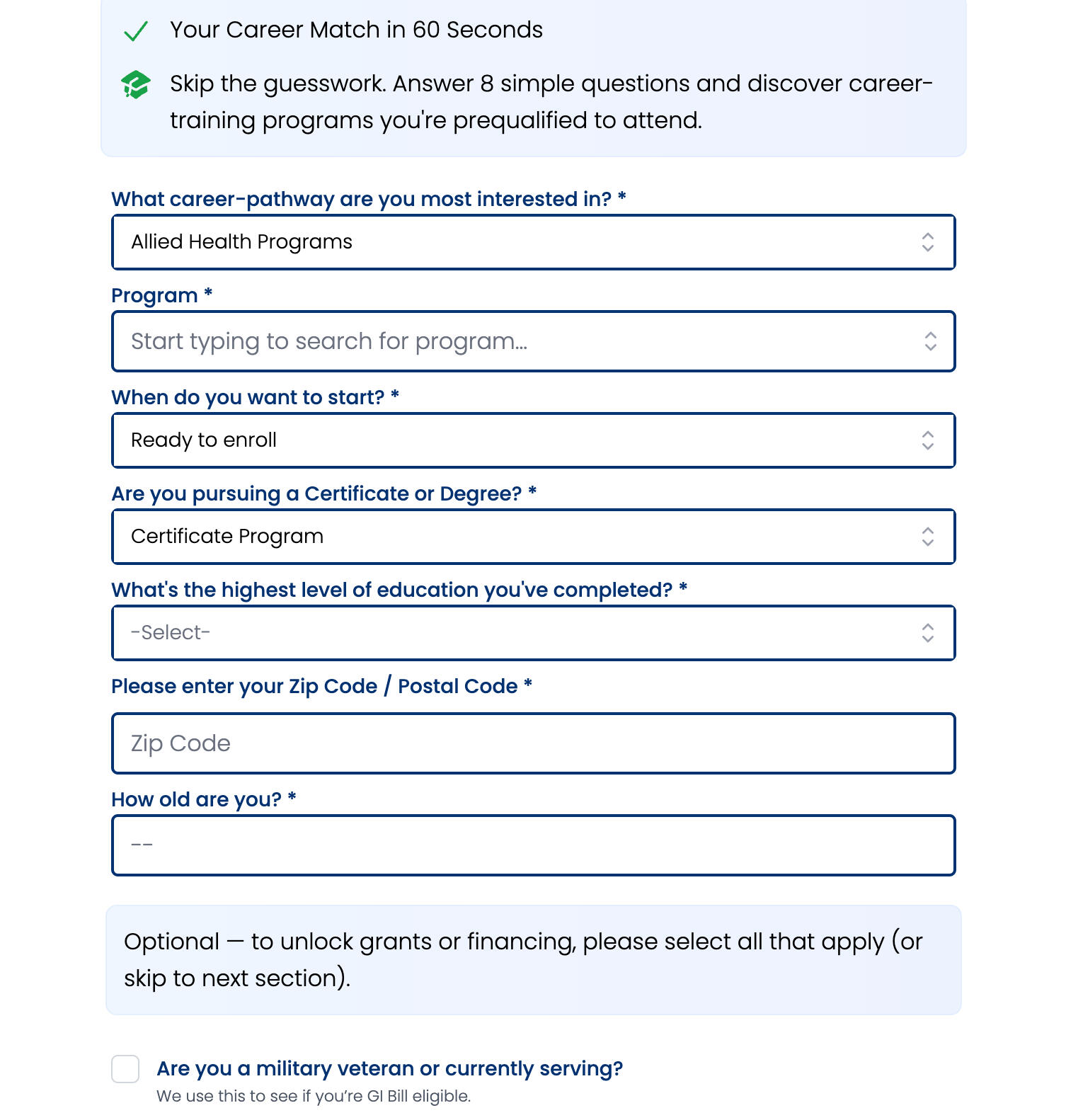
After
The redesigned landing page introduced clear, trust-building CTAs such as Explore Programs and Loan Calculator, offering immediate value before asking for personal data.
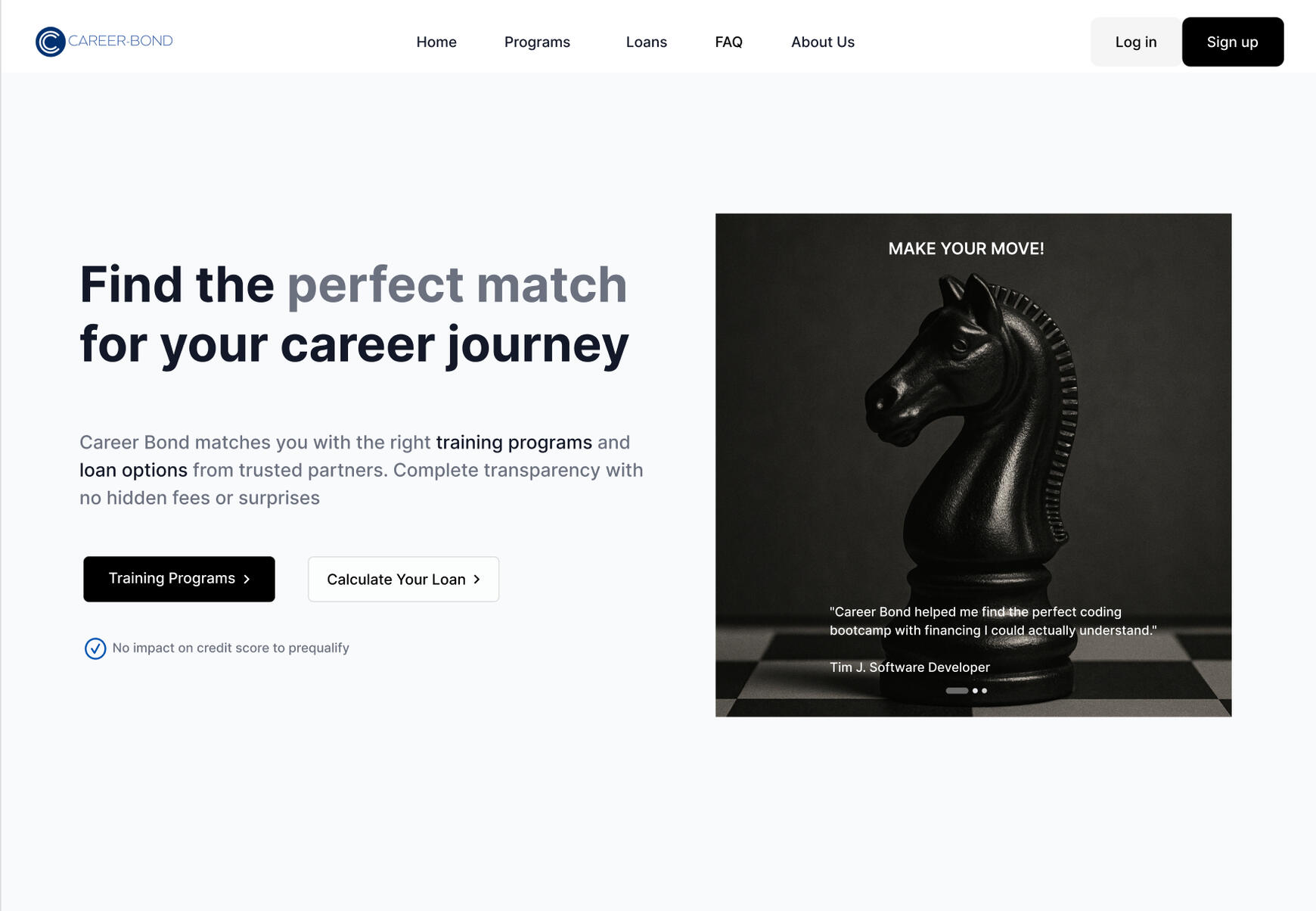
Redesigned the three-step flow to build trust and deliver value. Users can now explore Programs or Loan Matching to see which loans support each program, or vice versa. The interface displays this relationship clearly through dynamic “pill” indicators, giving instant transparency before commitment.
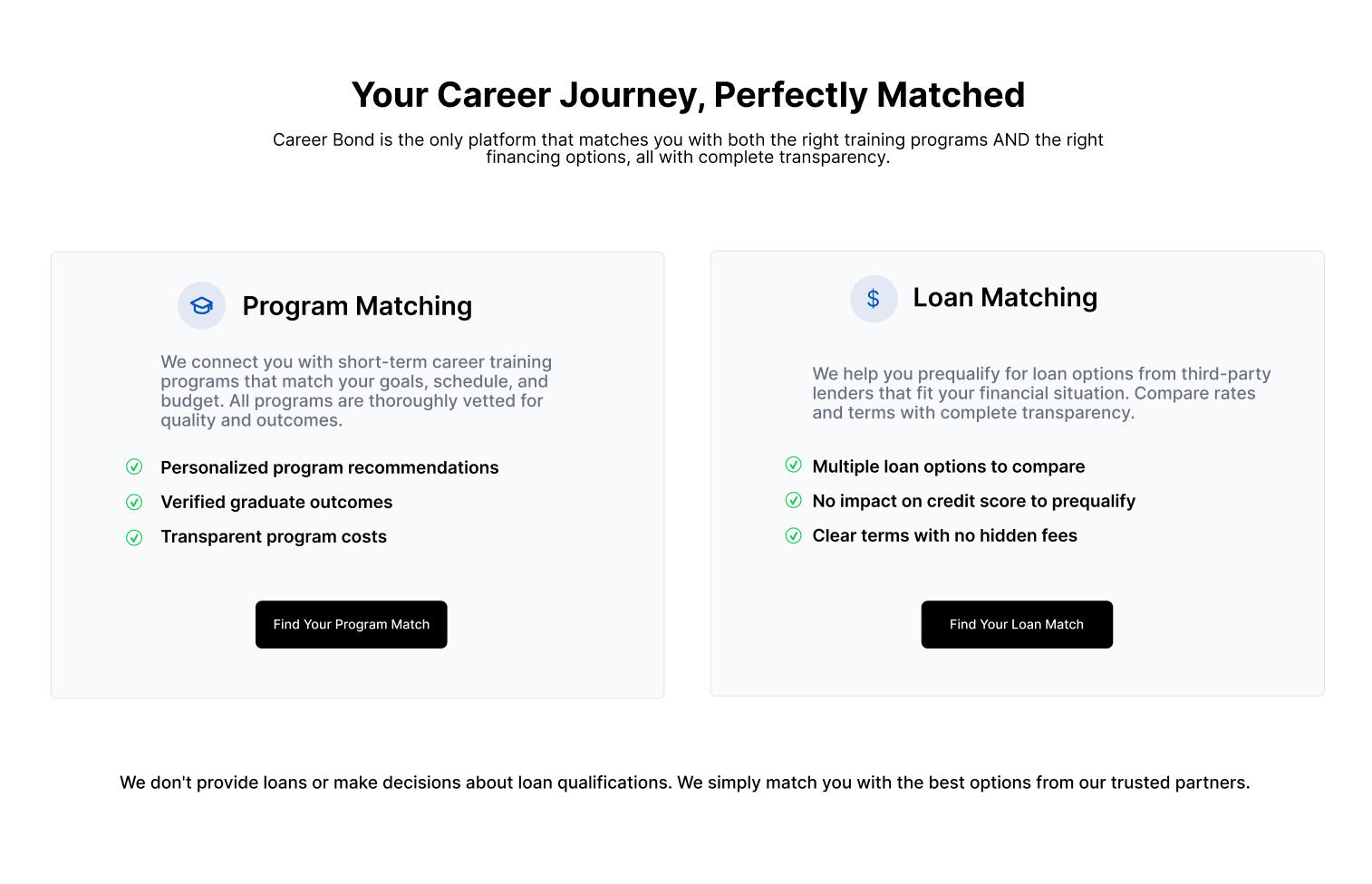

This illusion of choice eroded trust early in the journey. Users believed they were exploring tailored programs, but were instead redirected to the same generic page asking for personal details before showing any relevant information. Instead of guiding discovery,
the interface funneled every action into data capture, making the experience feel manipulative rather than supportive.
UX Insight: False Choice Destroys Trust
A key psychological trigger for distrust.
When multiple CTAs lead to the same page, users lose perceived control. Instead of feeling guided, they feel manipulated. In financial contexts, that emotion directly translates to abandonment and skepticism. True transparency isn’t about showing numbers, it’s about making every action feel honest and distinct.
The Solution
The core problem stemmed from a lack of transparency users were asked for information before receiving value.
To rebuild trust, I designed an interactive loan calculator that showed real numbers upfront, helping users understand total repayment before committing. This shift from “Apply to see your rate” to “Preview before applying” created an open and confidence-driven flow.
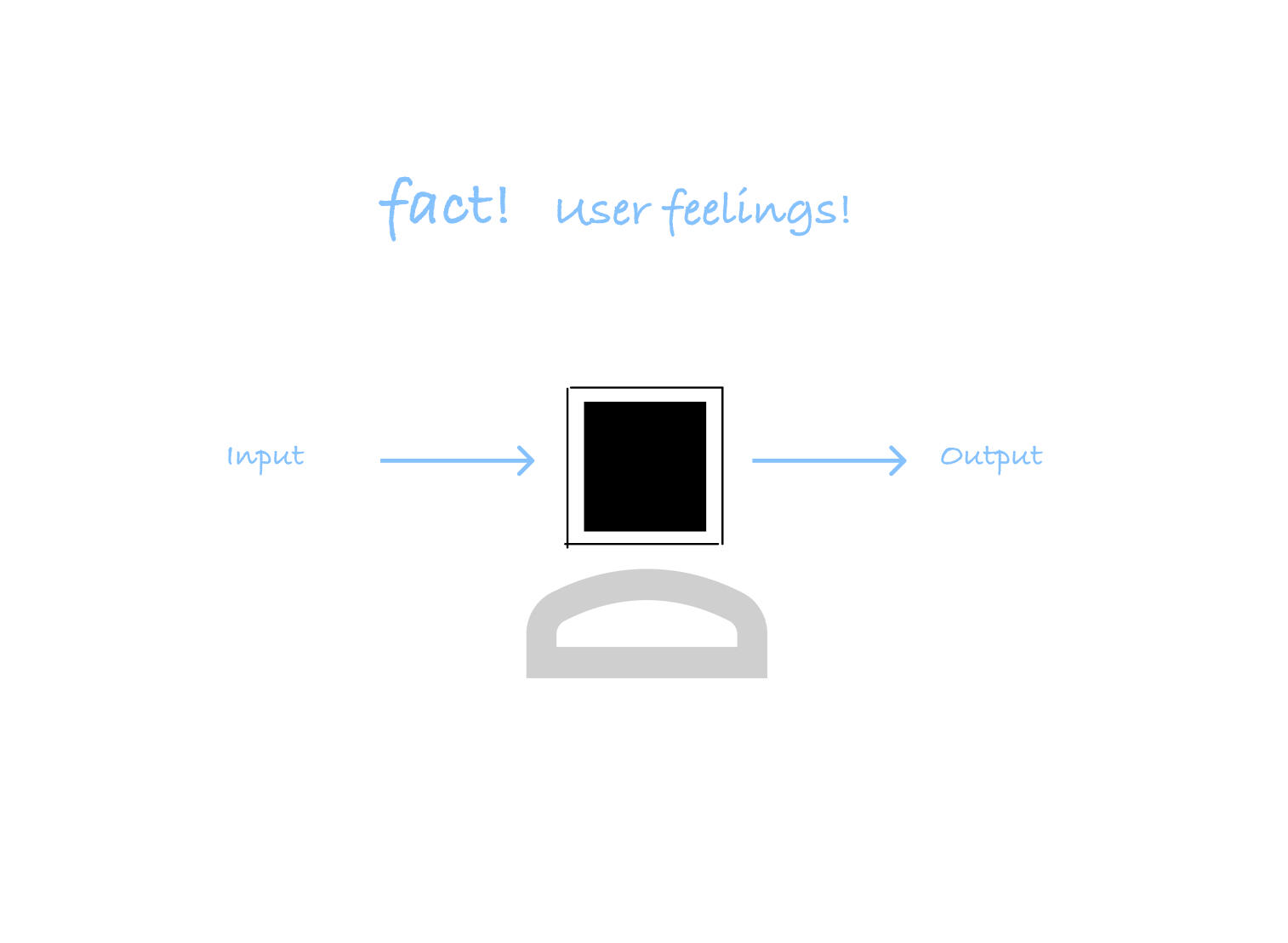
User described;
"The loan journey feels like a black box" users are unsure what to expect.
User insights revealing emotional disconnect and the need for clarity before commitment.
Feature 1: Simplified Application Entry Flow; preventing unnecessary repetition and user frustration.
The original toolbar redirected users to the same “Career Goals” form regardless of their intent. I restructured the entry points to distinguish between program discovery and loan options, preventing unnecessary repetition and user frustration.
Feature 2: Upfront Cost Visibility; I introduced an interactive loan calculator prototype showing repayment breakdowns.
Users hesitated to proceed without understanding total program costs. I introduced an interactive loan calculator prototype showing repayment breakdowns and total costs before personal data entry.
Feature 3: Clear Navigation Hierarchy; I proposed a simplified structure where users could first explore then preview financing.
The old multi-step form and program listing caused confusion. I proposed a simplified structure where users could first explore programs, then preview financing reducing perceived friction.
Existing interface: users struggled to locate relevant loan programs and understand repayment terms.
I designed calculator prototype with simplified breakdown and transparent costs.
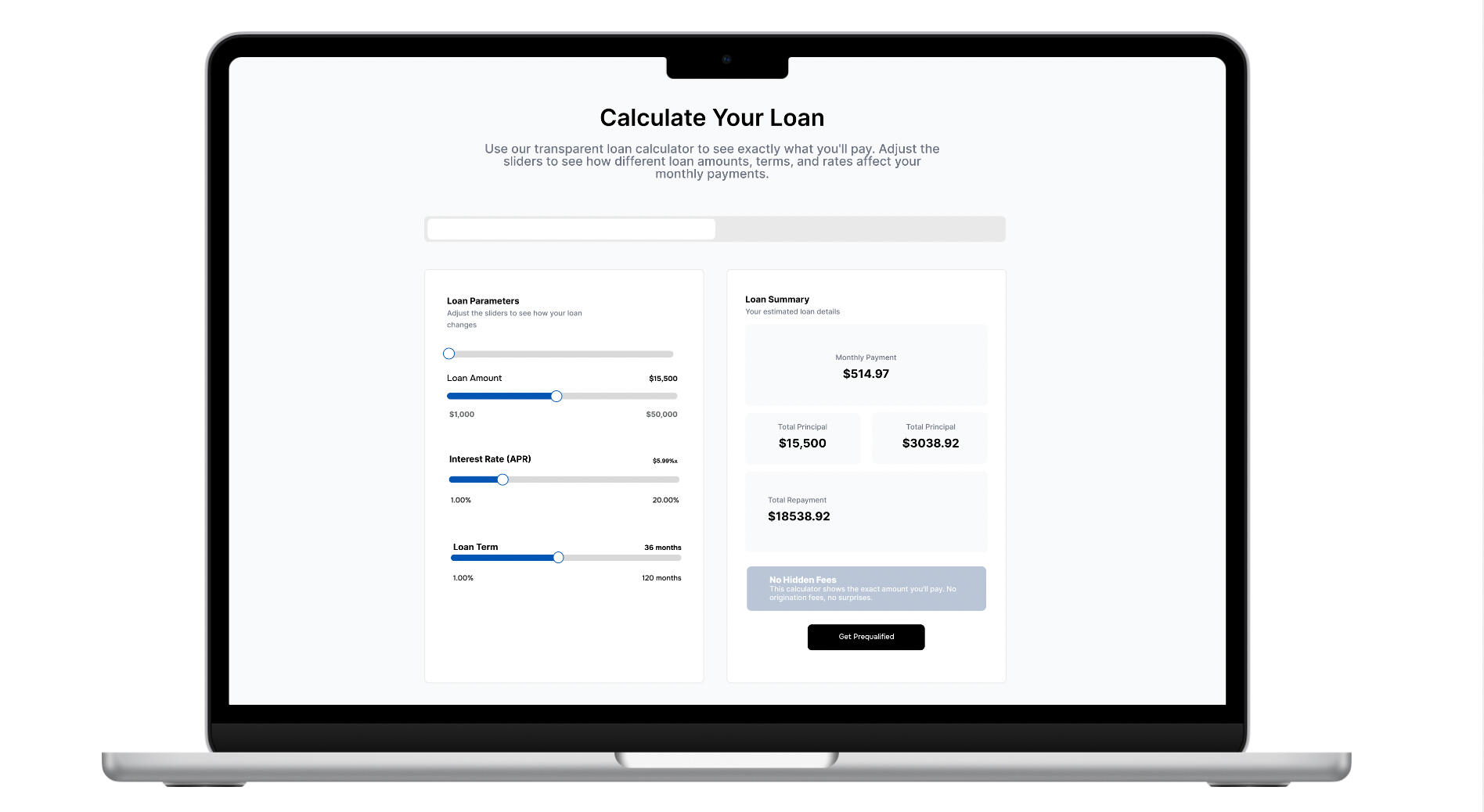
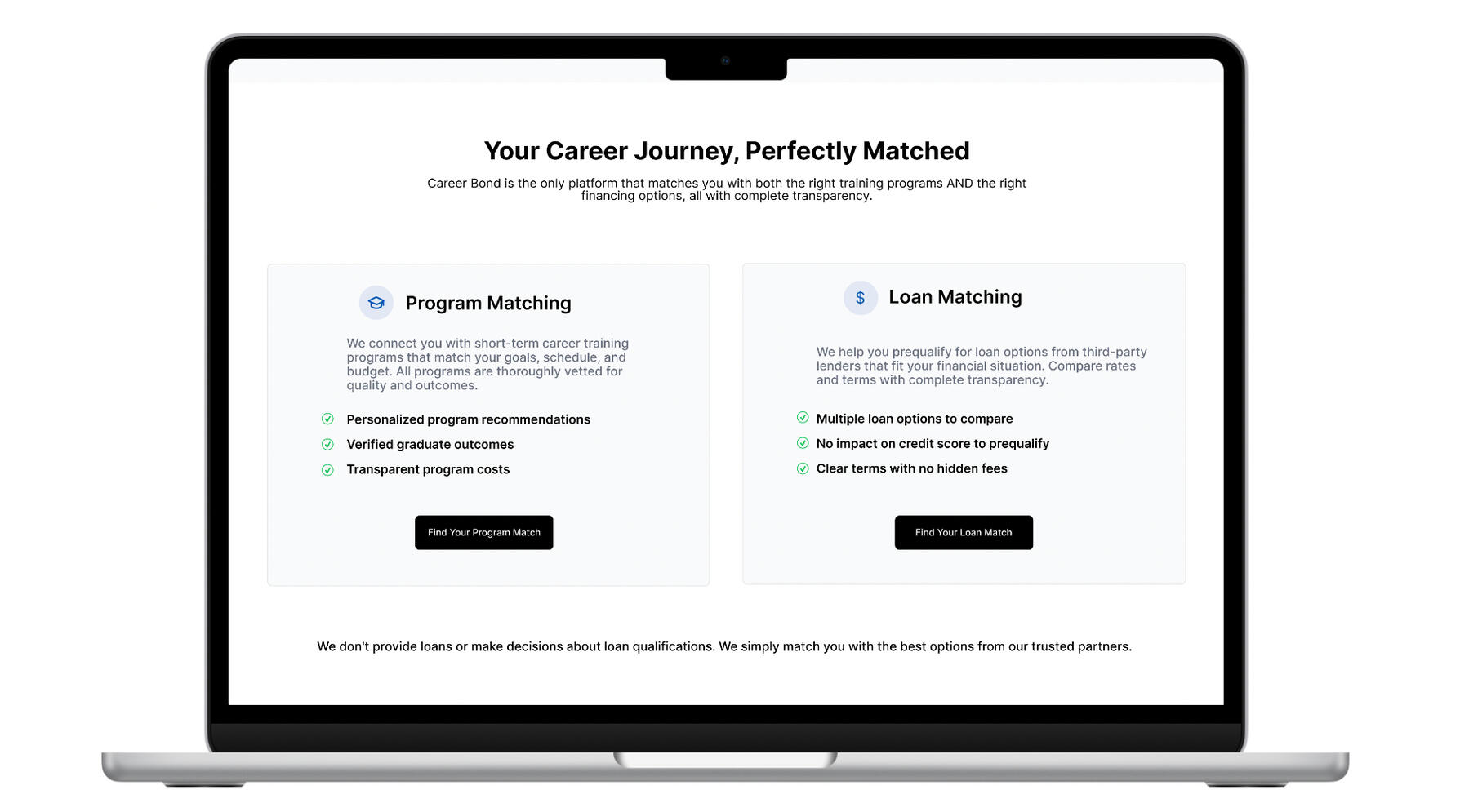
Guiding users through a transparent progression with clear feedback at every stage.
Three-step flow
Estimate, Verify, Apply.
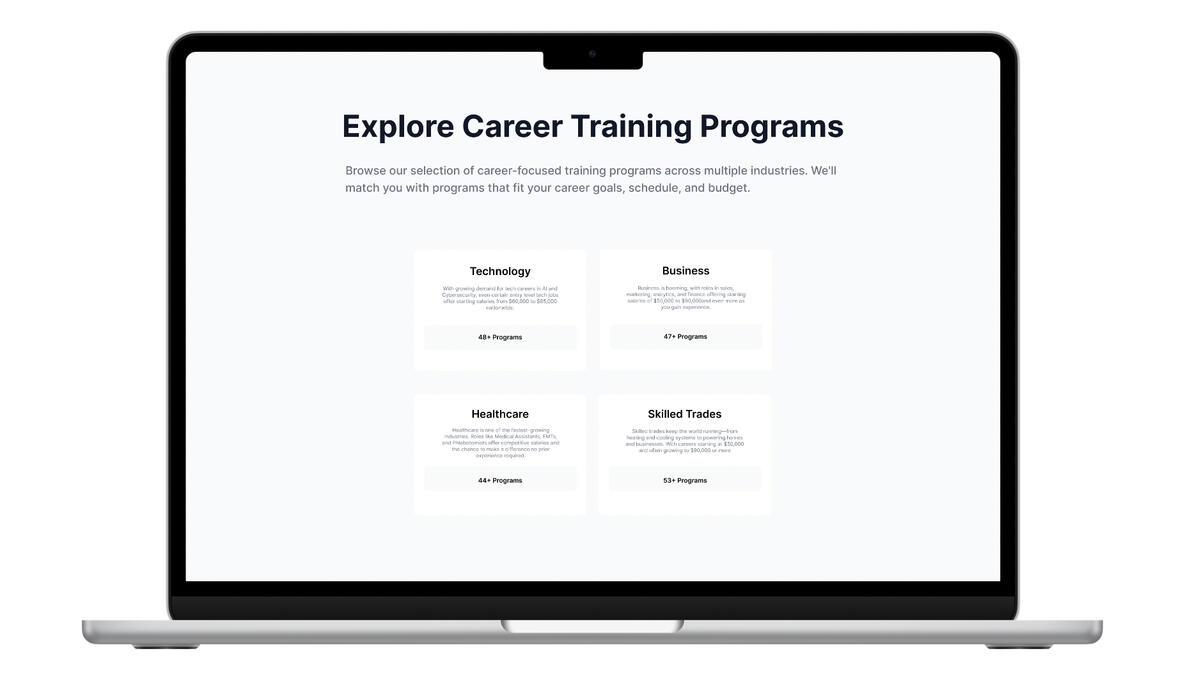
Step 1
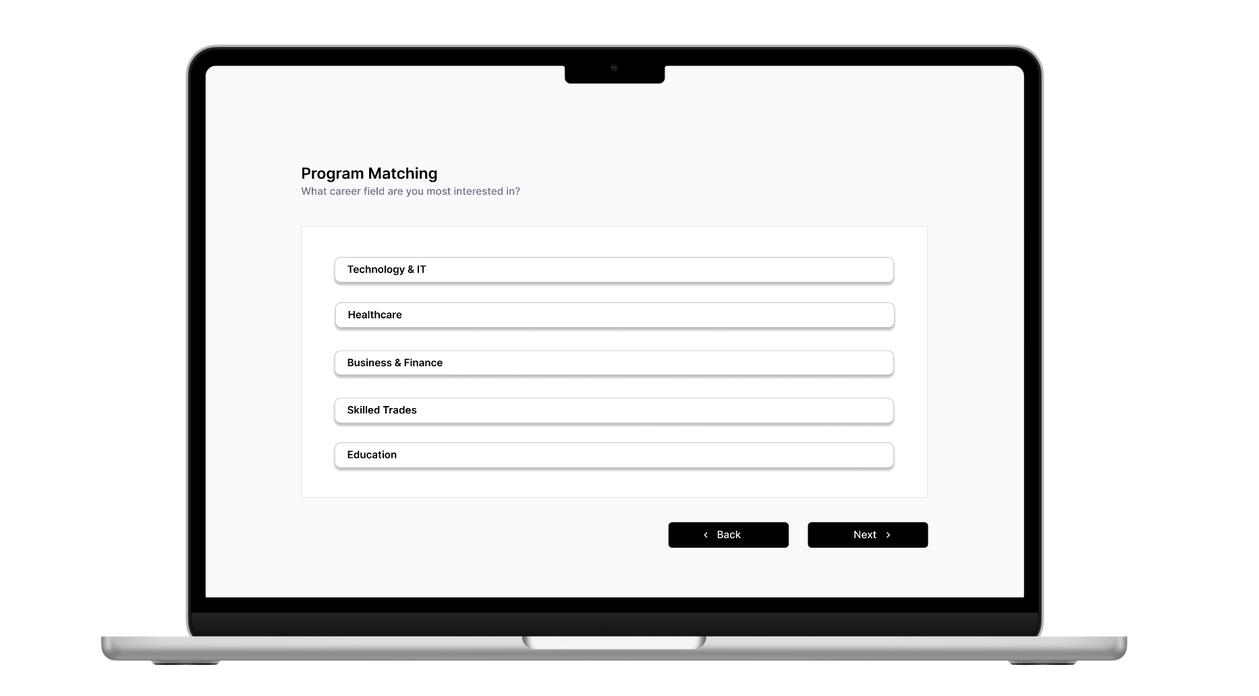
Step 2
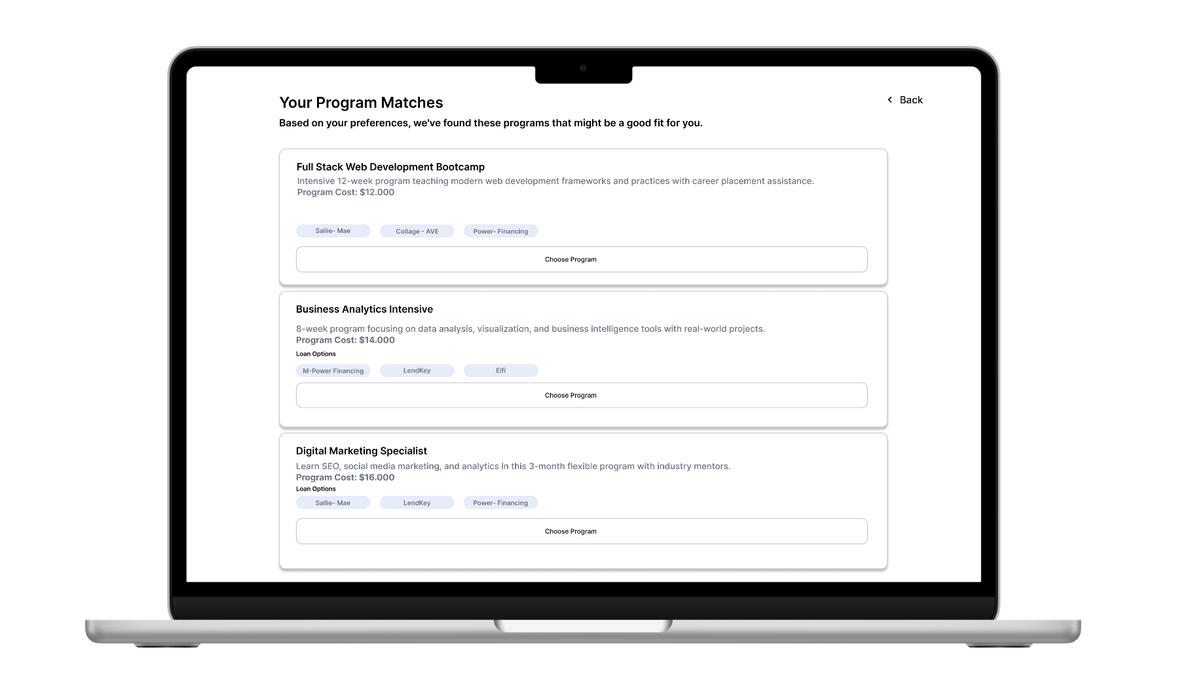
Step 3 (Results)
Flow & Structure
Simplified page hierarchy reduced confusion and separated program discovery from loan qualification.
The platform flow was rebuilt around clarity breaking the process into three transparent stages: Estimate, Verify, and Apply. Each stage provides visible progress and upfront information before any personal data entry.
Information Architecture
Shows simplified page hierarchy for the redesigned platform.
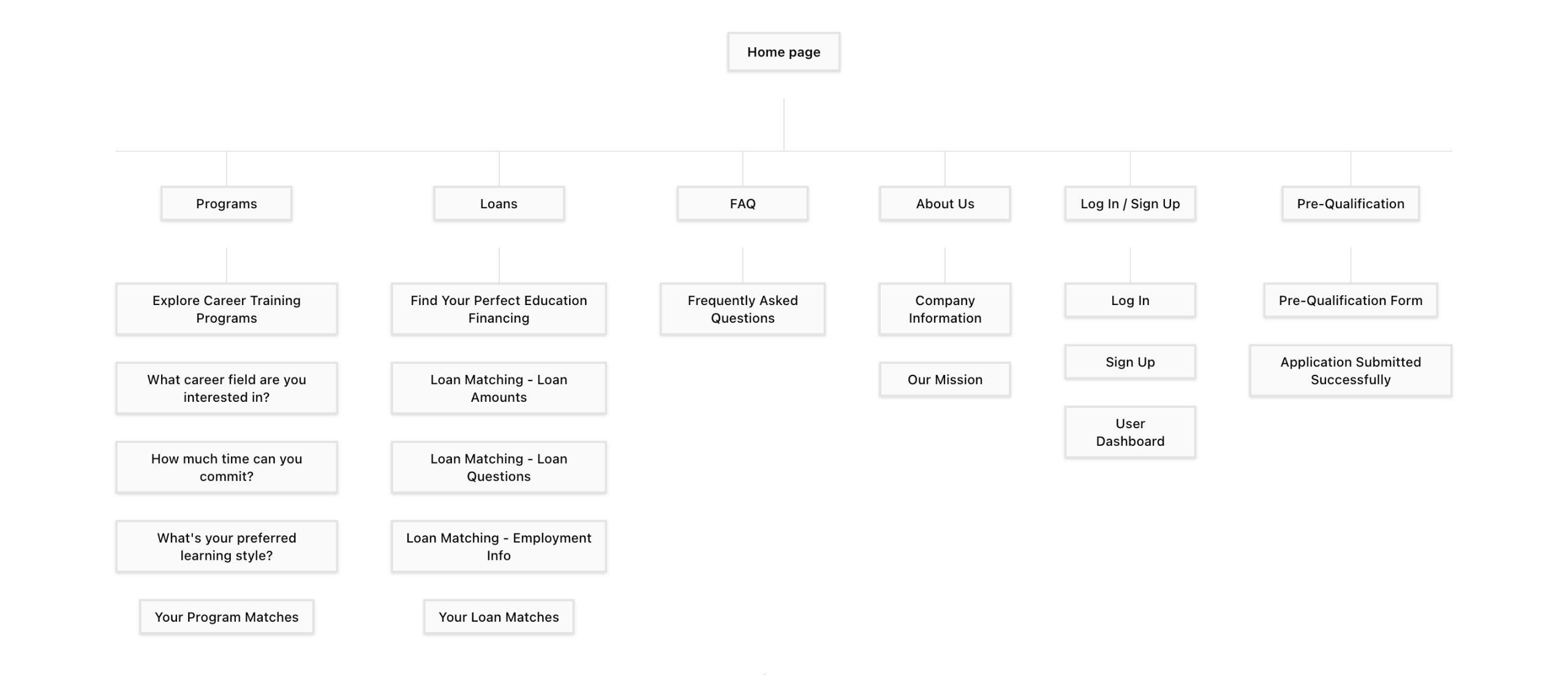
Low-Fidelity Wireframes
Early structural sketches testing information order and user navigation clarity.
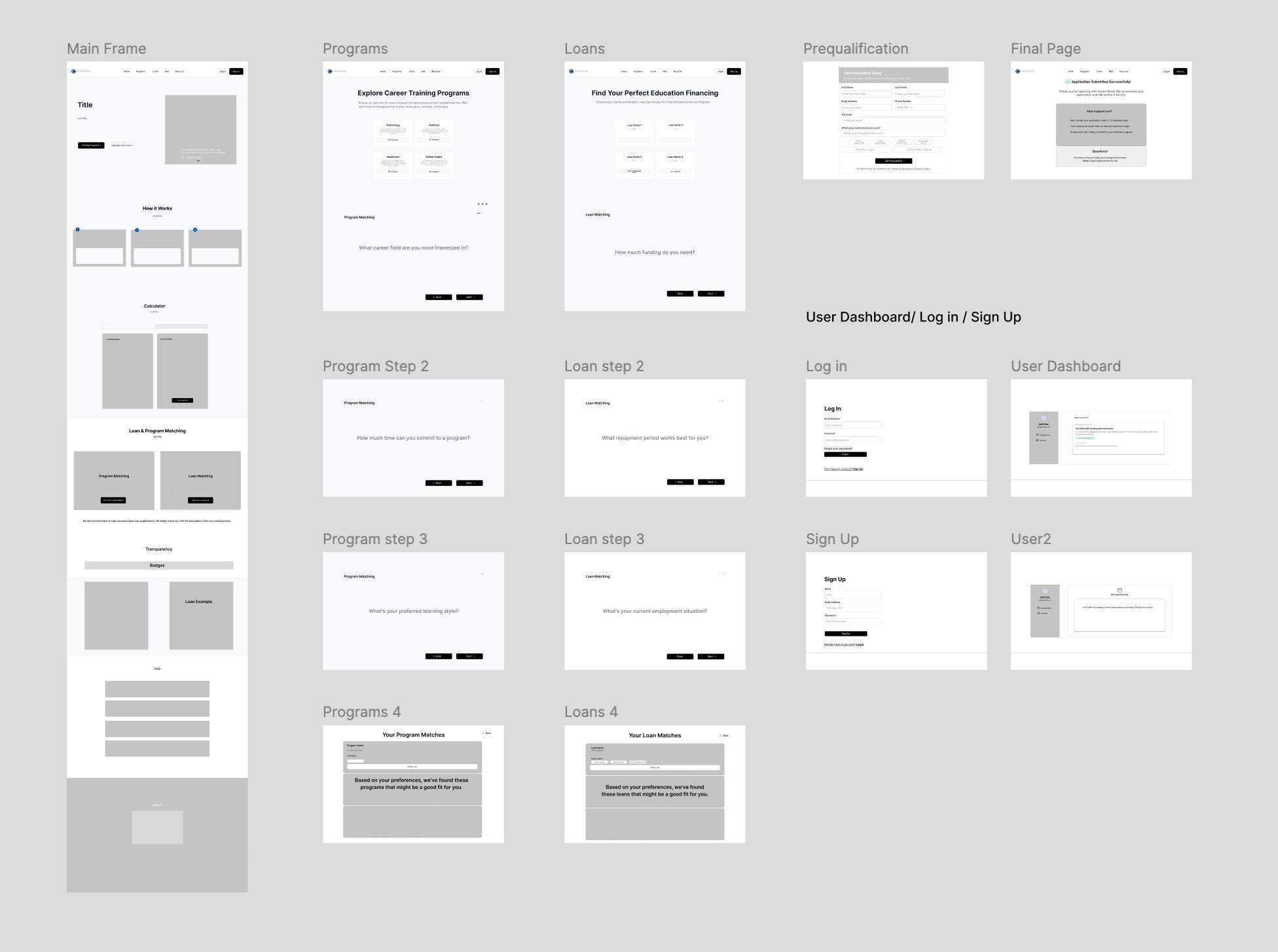
User Interface Design
The palette gives the interface a confident identity without shouting. Deep navy and black signal credibility; a restrained blue accent adds focus. Neutral grays and off-whites keep attention on content. The result is bold yet minimal aligned with CareerBond’s values of honesty and transparency.
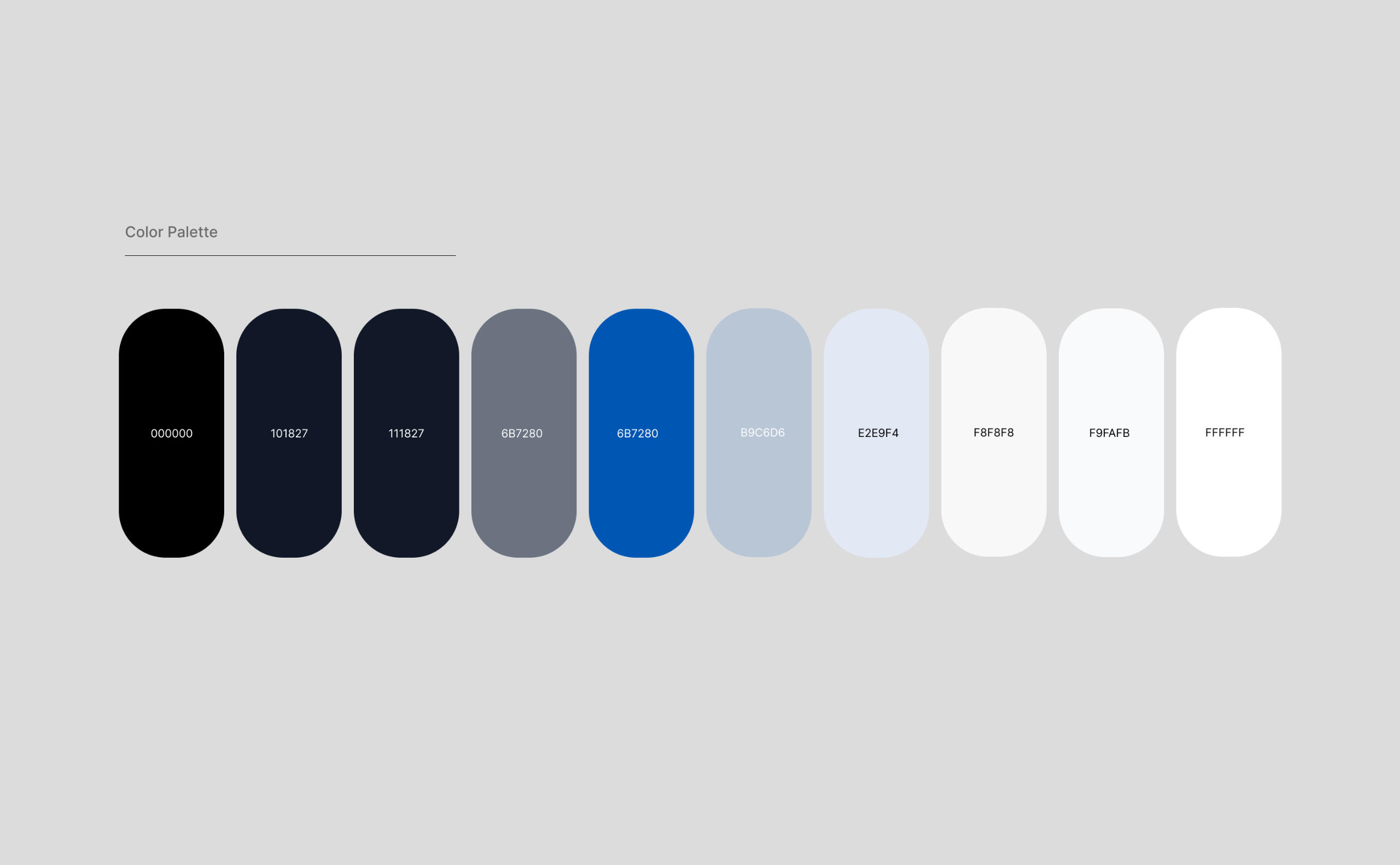
Using a clear hierarchy of Bold, SemiBold, Medium, and Regular weights guides attention naturally.
The interface uses Inter, a modern sans-serif typeface designed for digital clarity and balance. It's geometric simplicity makes complex financial data easy to scan while maintaining a professional tone.
From key actions to supportive information ensuring a consistent and accessible reading experience across all screens.
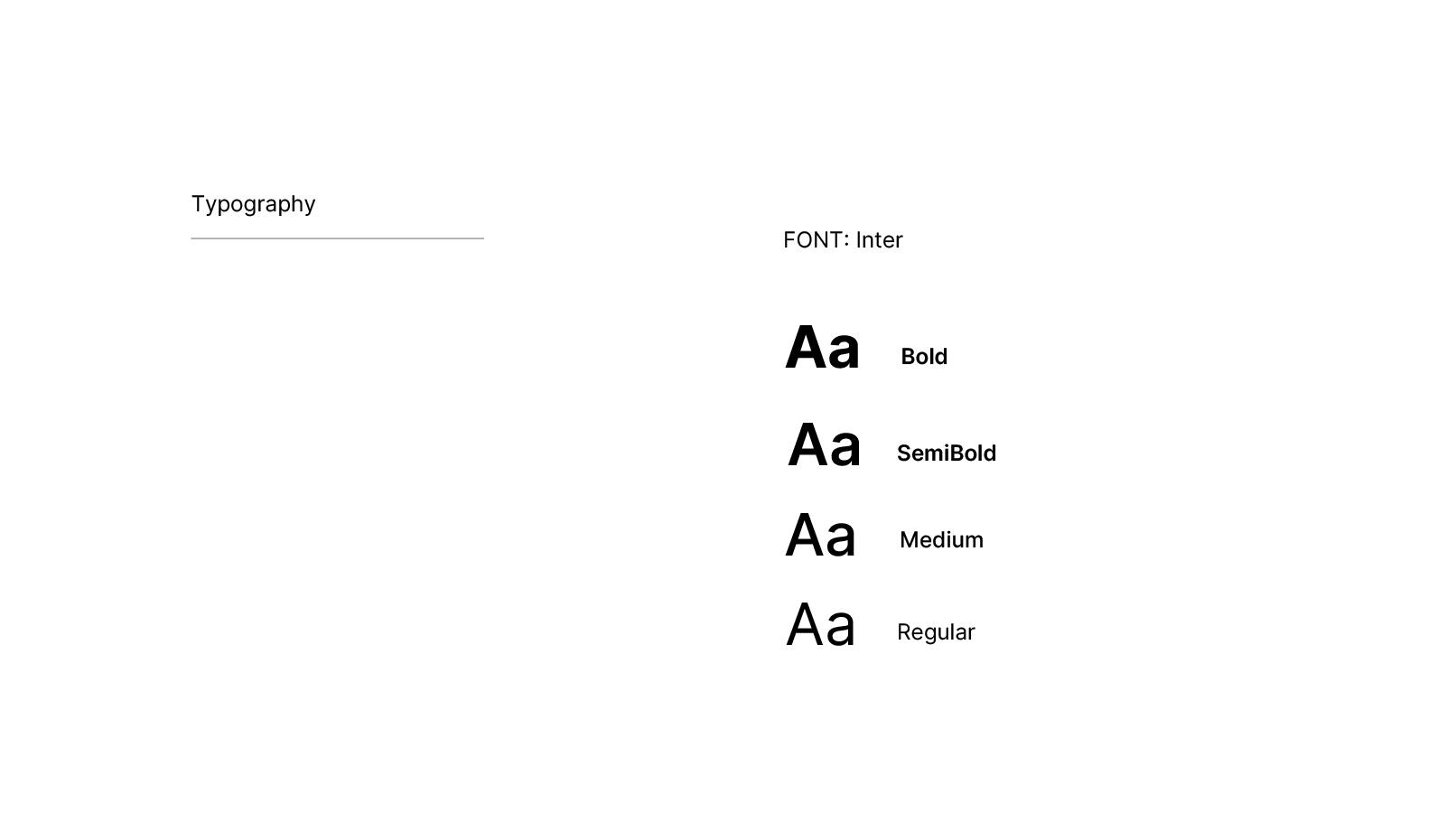
COMPOSITIONS
I developed desktop web compositions focused on hierarchy and ease of scanning. Each frame emphasized predictability, the psychological core of trust.
Key compositions included:
Pre-application estimator: Displayed total repayment before personal data entry. Simplified comparison view: Allowed users to understand multiple loan options at a glance. Guided input flow: Broke complex forms into calm, digestible sections. Completion screen: Framed confirmation as reassurance, not pressure.The compositions were built for clarity, not persuasion, a visual language that quietly earned belief through simplicity.
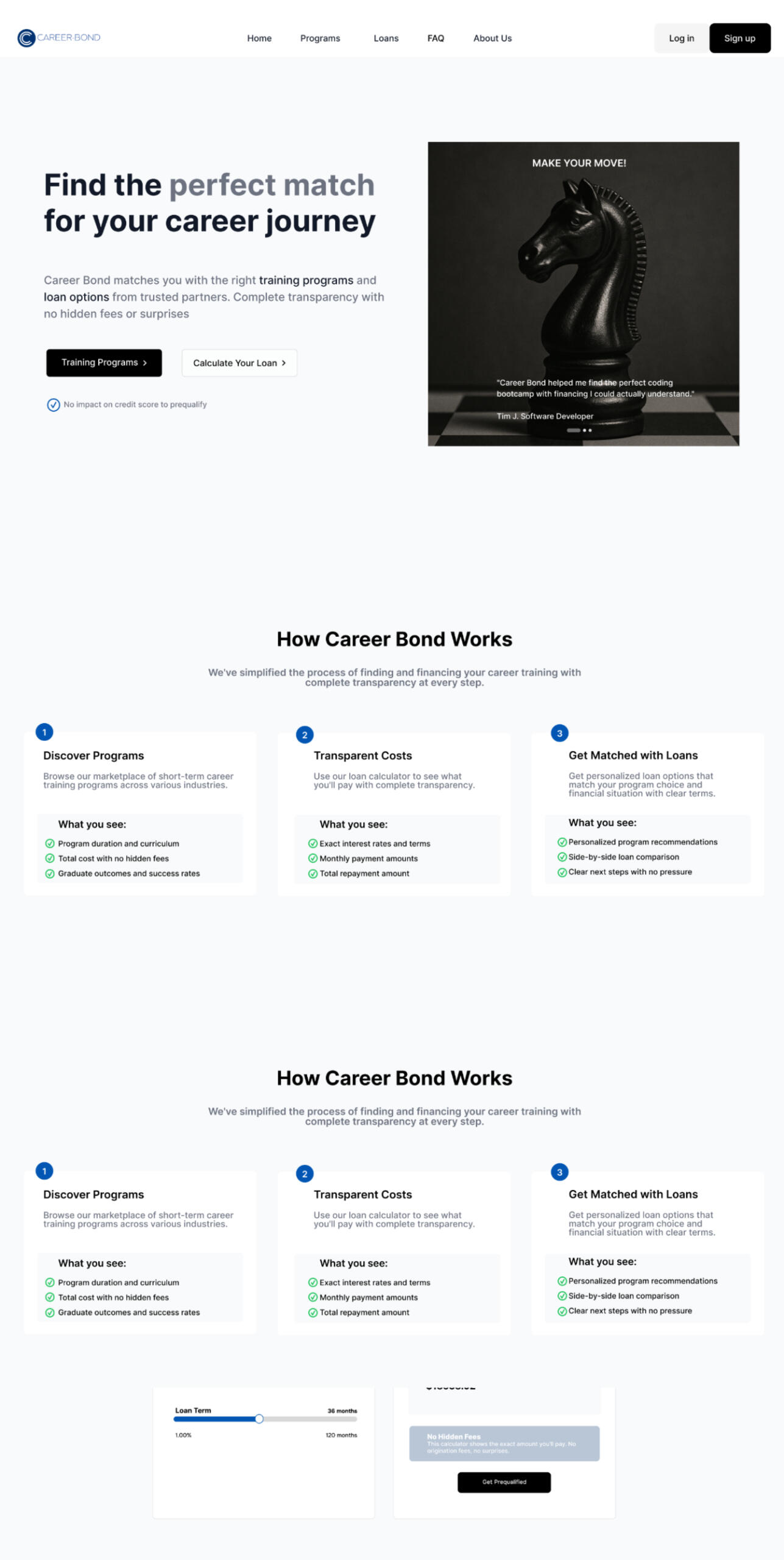
outcomes
Tested with the same 4 users before & after
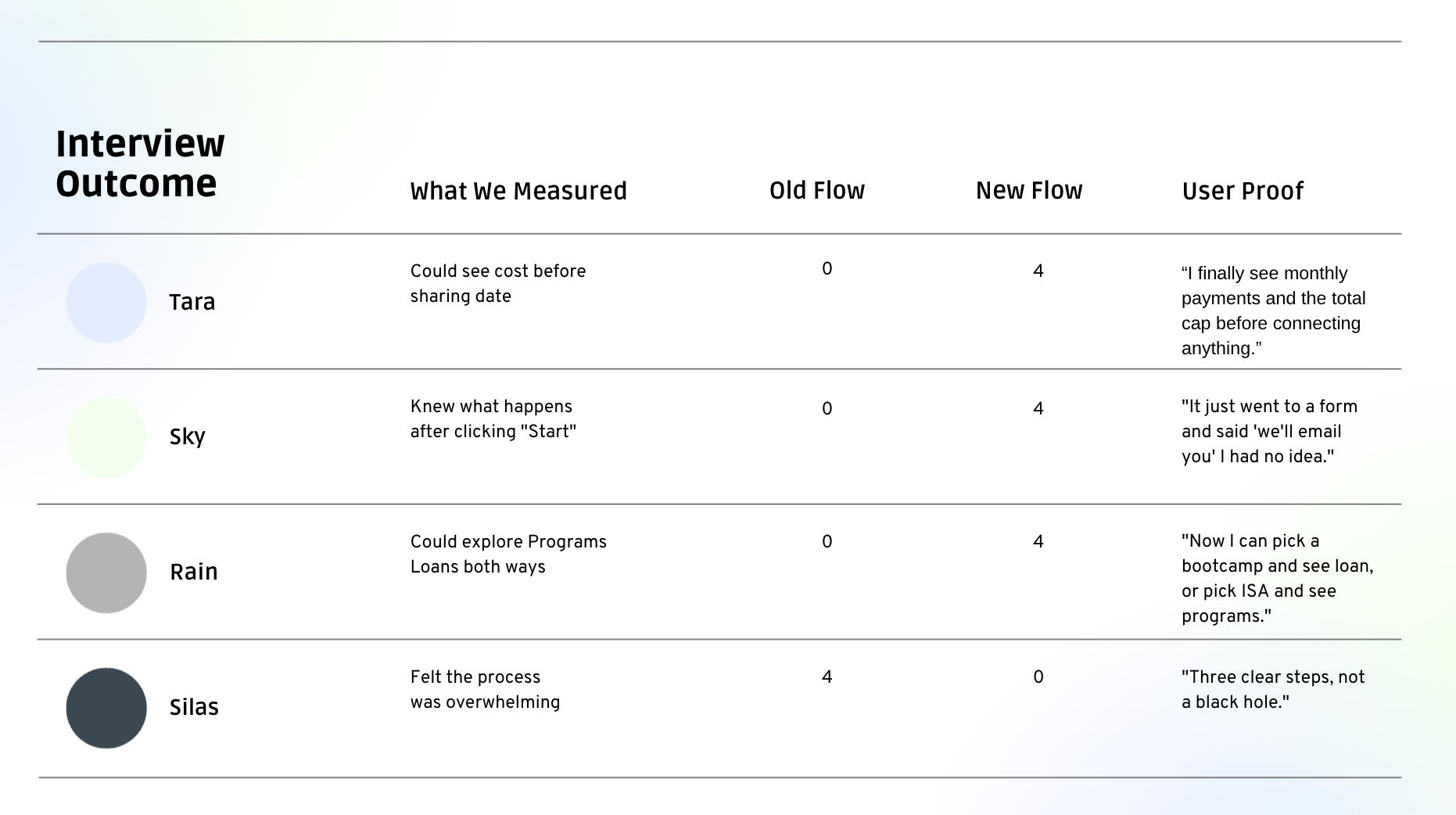
STRATEGIC IMPACTA trust-first UX framework for fintech- Truthfulness > Conversion: Built a model where users see real numbers first, not after data entry.- “Clear, honest, finally easy” direct quote from all 4 testers.- Scalable Design System:→ Transparency-first language (calculator, 2-way explore, 3-step flow)→ Reduced cognitive load by 100 % (per user feedback)→ Reusable for ISAs, student loans, career financing
This isn’t just a redesign, it’s a blueprint for any trust-sensitive financial product.
FINAL THOUGHTS
This project proved that great UX isn’t just about usability it’s about emotional integrity. Financial tools often fail not because users don’t understand them, but because they don’t believe them. The idea began with a coffee analogy how hidden costs shape distrust and evolved into a UX principle: when what users see is exactly what they get, trust becomes the design. That’s the benchmark I design for clarity so consistent that users never have to second-guess the product or themselves.
About
Su Barikan is a product designer and creative director based in New York City, known for her work at the intersection of contemporary art and digital media. She is the founder of Abstract State, a contemporary art publication and digital platform. Barikan established Abstract State to bridge the gap between contemporary art and digital audiences, overseeing the platform's brand strategy, editorial design, and complete digital ecosystem. Her work is characterized by the integration of fine arts principles with strategic user experience design.In recognition of her contributions to the field, Barikan was awarded the classification of "Extraordinary Ability in Visual Arts and Design" by the United States. Her design practice encompasses product development and digital strategy across various sectors, including environmental sustainability, financial technology, and wellness innovation.Barikan's educational background is multidisciplinary, combining studies in Philosophy at Istanbul University (2016–2022) with formal training in design and fine arts. She attended the Gerrit Rietveld Academy in Amsterdam for Art & Design (2010–2011) and the Royal Academy of Art in The Hague, where she studied Fashion Design & Textile (2011–2013) as a merit-based scholarship recipient.
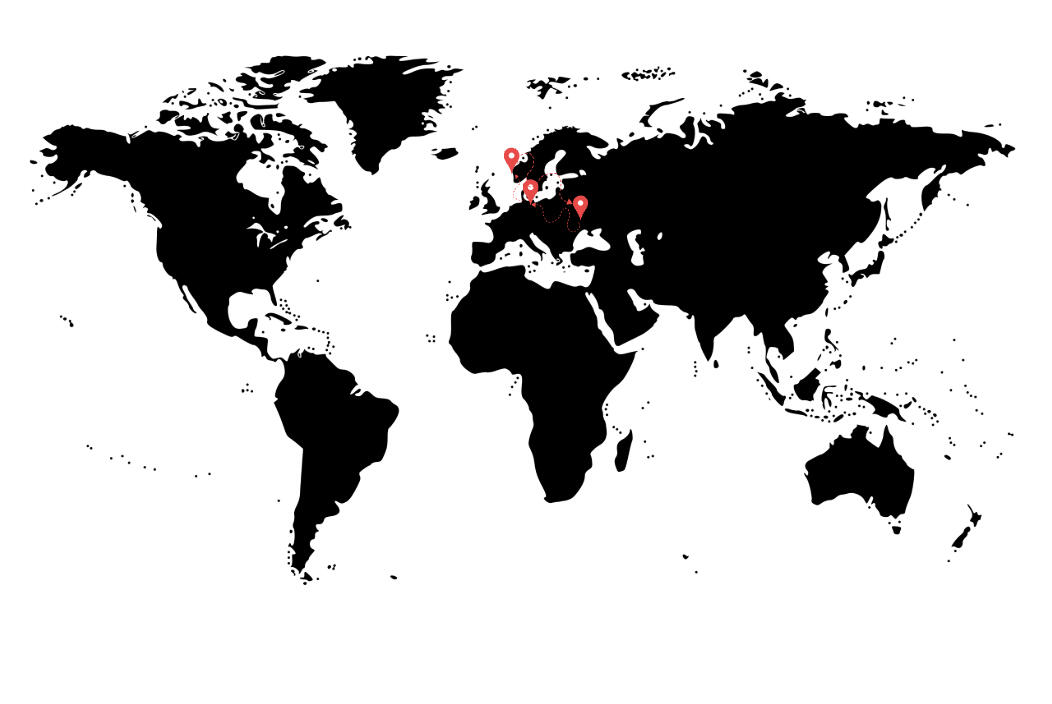
B.A in Philosophy
Istanbul University
Istanbul, Turkey, 2016 - 2022Fashion Design & Textile
(Merit-based scholarship recipient)
The Royal Academy of Arts
The Hague, Netherlands, 2011 - 2013Foundation in Art & Design
Gerrit Rietveld Academy,
Amsterdam, Netherlands, 2010 - 2011
Interior Design
Leonardo da Vinci Project Istituto per l'Arte e il Restauro Palazzo Spinelli
Florence, Italy, 2004Interior Design Pera Fine Arts Institute
Istanbul, Turkey, 2003 - 2004
Ocean Series
The Playground
I believe playing is in our nature however in the process of growing up we replace toys with people which leads us to forget the harmless games we used to play. Suppressing our nature makes adulthood robotic instead of being poetics. But, whenever we go near the ocean, we leave ourselves in the arms of nature to our playground where we play in it, at any age. I'm creating this playground in my paintings to remind you to be poetic, to play, to be harmless.
MANHATTAN COLLECTION
Size 18x24" Oil/Mixed media Paintings

No:20 M

No:22 M

No:27 M

No:28 M
Size 8x8" Oil/Mixed media

Sold

No:2 M

No:3 M

No:4 M

No:7 M
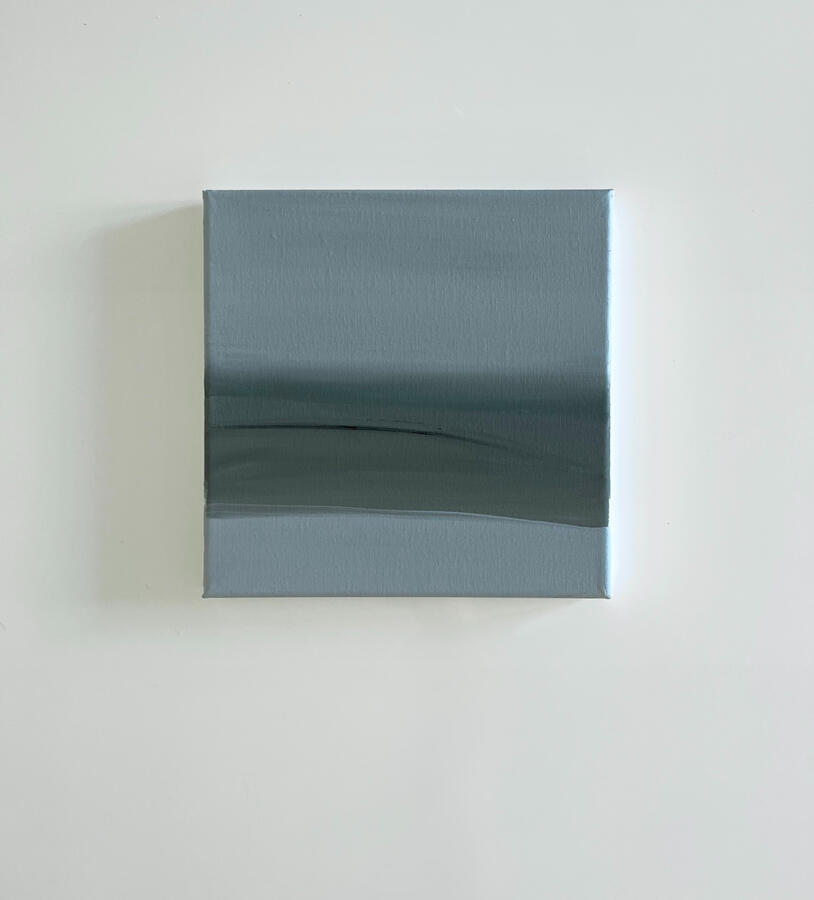
No:8 M
Size 8x10" Oil/Mixed media

No:13 M

No:14 M

No:15 M

No:16 M

No:17 M

No:5 M
2025
14 FEB - 16 FEB Arte Genova (Genova Art Fair) , Genova GE, Italy28 MAR - 30 MAR, Vernice Art Fair, Forlì, Italy24 MAY - 7 JUN, Dialogues With Time, Mega Art & AroundArt, Corchiano, Italy
2024
12 JAN - 17 JAN, Dreams & Nightmares 2nd Edition, Boomer Gallery, London, UK9 FEB - 14 FEB, The Dark Side, First Edition, Boomer Gallery, London, UK8 MAR - 13 MAR, The Inner World, Boomer Gallery, London, UK2 APR - 17 APR, DREAMS & NIGHTMARES 3RD EDITION, Boomer Gallery, London, UK20 APR - 28 APR, A Window on International Contemporary Art - Crema 2024, TD Art Gallery, Crema, Italy25 MAY - 7 JUN, SINTESI XIII Harmonies and Divergences Istanbul, Turkey
INTERVIEW
https://www.artistcloseup.com/blog/interview-su-barikanPRESS17 APR, Collect Art, Book Edition30 APR, Collect Art, Special Edition1 MAY, Artistcloseup Magazine, Issue 612 MAY, Al- Tiba9 Magazine, Issue 1327 JUL, Artist Talk Magazine, Issue 26
2023
MAR
3 MAR - 13 MAR, Of Integration, Van Der Plas Gallery, New York, USA13 MAR - 13 APR, The Holy Art Gallery, London, UK26 MAR - 23 APR, Royal Blue Gallery, UKAPR15 APR - 22 APR, All the Colors of The Art, Mega Art Gallery, Corchiano, Italy29 APR - 29 MAY, Collect Art, Tbilisi, GeorgiaMAY- JUNE5 MAY - 10 MAY, Walking With Giants, Boomer Gallery, London, UK23 MAY - 23 JUN, Untitled, Monat Gallery & Artsper, Madrid, Spain24 MAY - 2 JUNE, International Contemporary Art, Mega Art & Mo. C. A. Gallery, Rome, Italy26 MAY - 4 JUNE, The Bridge, Van Der Plas Gallery, New York, USAJUNE
9 JUN - 14 JUN, Vogue 6th Edition, Boomer Gallery, London, UK9 JUN - 11 JUN, ArtsLibris Barcelona, Artist's Book Fair, Al- Tiba9, Barcelona, SpainJULY6 JUL - 12 JUL, 1st. Contemporary Art Exhibition, Mega Art & Studio D'Arte Larkina Loreta, Venice, Italy7 JUL - 12 JUL, The New Renaissance, Boomer Gallery, London, UK13 JUL - 19 JUL, 2nd. Contemporary Art Exhibition, Mega Art & Studio D'Arte Larkina Loreta, Venice, Italy
6 JUL - 12 JUL, 1st. Contemporary Art Exhibition, Mega Art & Studio D'Arte Larkina Loreta, Venice, Italy7 JUL - 12 JUL, The New Renaissance, Boomer Gallery, London, UK13 JUL - 19 JUL, 2nd. Contemporary Art Exhibition, Mega Art & Studio D'Arte Larkina Loreta, Venice, ItalyAUG11 AUG - 16 AUG, The New Artist | 5th Edition, Boomer Gallery, London, UK16 AUG - 31 AUG, Panorama, Monat Gallery, Spain25 AUG - 27 AUG, Monaco Art Fair, MonacoSEP8 SEP - 13 SEP, What is Art | 6th Edition, Boomer Gallery, London, UK15 SEP - 29 SEP, Contea Caravaggio Museum, Mega Art Gallery, Sicily, Italy23 SEP - 29 SEP, Sintesi 2023 - Contaminations in Contemporary Art, Crocetti
Museum, Rome, ItalyOCT13 OCT - 18 OCT, Dreams & Nightmares 1st Edition, Boomer Gallery, London, UKNOV8 NOV - 17 NOV, Spazio Arte Tolomeo, Milano, Italy10 NOV - 15 NOV, Why do you do it | 1st Edition, Boomer Gallery, London, UKDEC15 DEC - 20 DEC, The New Artist | 6th Edition, Boomer Gallery, London, UK


